

TE carta
Preocupados de la experiencia del cliente.

Destinos
Flota
Nueva flota para brindar el mejor servicio.

Historia
Hemos construido una historia en común.

Personas
Nuestra gente es lo más importante.
TE informacionCompania

TE estrategiaNegocios
El grupo aéreo mas grande de la región.

Directorio
Nuestra experiencia nos hace únicos.

Ejecutivos
Nuestra experiencia nos hace únicos.

TE practicaGobierno

TE EstructuraPropiedad

TE politicaFinanciera

TE OperacionInternacional
Estamos conectados a todo el mundo.

TE OperacionCarga
Somos el mayor operador de carga en la Región.
TE PropiedadesPlantas

TE EntornoIndustria
La economías emergentes impulsan la industria.

TE Marco Regulatorio

TE ResultadosFinancieros

TE PremiosReconocimientos
Nuestros reconocimientos más destacados.

TE HechosEsenciales
LATAM: Nuestra nueva marca.

TE InformacionBursatil

TE FactoresRiesgo

TE InformacionAdicional

TE PlanInversion

TE visionSostenibilidad
Nuestra aspiración de ser más.

TE GobernanzaSostenibilidad
Nuestra gestión de la sostenibilidad.
TE CambioClimatico
Nuestro compromiso con el medio ambiente.

TE CiudadaniaCorporativa
Nuestro compromiso con la región.
TE RelacionGrupos
Nuestra relación con nuestros stakeholders.

TE carta
Dear shareholders,
2015 was the most challenging year in the history of LATAM. In virtually every market we operate, local currencies depreciated; thus impacting our revenues and costs related to the import of goods and services. Moreover, we faced a huge economic and political crisis in Brazil, our largest market; which strongly impacted the civil aviation sector. The country faced the largest recession of its modern history; resulting in a contraction of GDP, increased unemployment and a fall in real wages. This has had a significant impact on the wealth of individuals and companies, with the troubles in the political environment affecting expectations, thus exacerbating the damage to the macroeconomic scenario.
This highly challenging scenario in our largest market explains the 219 million dollars loss that LATAM reported in 2015, which could have been worse if it wasn’t mitigated by the strong performance of our Spanish speaking markets. It’s worth highlighting that LATAM met its operating margin forecast of 5%, with the most adverse impact on currency depreciation, mainly in Brazil.
Notwithstanding the above, we retained our leadership in the main markets in which we operate, such as Chile and Peru. In 2015 we reduced our seat capacity (ASKs) by 2.5% in Brazil’s domestic operation and renegotiated our aircraft deliveries, which resulted in the cancellation of nearly 40% of our fleet commitments through 2018 and an investment reduction of 2.9 billion dollars. We are aware of future challenges, and in 2016 we will continue to adapt our network with an important additional reduction of 8% to 10% in seat capacity in the Brazilian domestic market as well as downsizing the international market from Brazil, especially to the United States. Therefore, 2015 will be remembered as the year where LATAM demonstrated its ability to respond to challenging economic scenarios.
We continue to consolidate our leadership in our main hubs – Guarulhos, Brasilia, Lima and Santiago – which will enable us to develop our network and offer the broader range of destinations to our passengers. Proof of this is the thirteen regional and international routes that were announced during the year, including connections between Brasilia and Montevideo, Punta Cana and Buenos Aires and Lima to Montevideo, Antofagasta and Washington D.C.
I would like to highlight the ‘joint business agreements’ negotiated in 2015 between LATAM and IAG (controlling holding company of British Airways and Iberia) and American Airlines (AA), one of the leading airlines in the United States. Once approved by the corresponding authorities, we will have access to a broad network of connections in important hubs in the United States and Europe. With these agreements, we have the possibility to open a large network of destinations and offer further advantages to our customers, such as the unique ticket sales and improved travel experiences. This was only possible because of our unrivalled flight network and connections within South America.
Finally, I wouldn’t like to end this message with announcing our new brand, LATAM Airlines. Since the beginning we knew that the best way to merge the different hispanic and Brazilian cultures would be through a new brand, a decision that we have arrived to after long discussions and breaking of paradigms, because a new brand has never been created from a merger or association of airlines in the history of aviation.  It wasn’t an easy decision, because the replacement of powerful and historic brands such as LAN and TAM required courage. It was also a logical decision, because the merger will generate economies of scale in the long run with the process simplification in virtually every area.
In 2016, our plan is to expand our leading position in Latin America, flying to new destinations with our unique identity and the same strength to overcome problems and grow in a profitable way.
Mauricio Amaro
Chairman of the Board
LATAM Airlines Group
Dear shareholders,
The consolidation of LATAM as one of the leading airlines in Latin America in terms of quality and service has been a priority over the last few years. We believe that the only way to be successful is to offer a distinctive offering to our passengers. Being only a step away from a huge accomplishment – the launch of our new brand – we are still convinced that we have the right strategy to achieve our goal of positioning LATAM among the best airlines in the world.
I would like to take this opportunity to inform you about all the work we’ve done over the last year. Introducing LATAM has meant change; changes that have opened a world of possibilities and allowed us to reestablish a new culture with the customerand place them at the center of every strategic plan. LATAM has not only brought together the best of LAN and TAM stories, but also it has amplified them on a large scale to deliver our clients much more than the sum of their parts.
We have made these changes in a highly complex and challenging regional scenario, which encourages us to be efficient, take care of our cost structure and to prioritse our strategies. We have focused on initiatives that allow us to build a distinctive offer. We offer the best network of destinations, a state-of-the-art digital experience and a team that directs its efforts towards satisfying our customers; which will guarantee our future growth.
In this vein, we continue working to enhance our flight network and connections within South America, thus offering our passengers a unparalled connectivity in the region. The company will continue to focus on strengthening our main hubs, allowing us to reinforce the group’s connectivity in Latin America, North America, the Caribbean, Europe and now Africa.
During 2015, we invested more than US$50 million in the implementation of digital advances that have allowed us to improve the passenger flight experience, offer better service before and after the flight and improve our how our employees work. Through this investment we look forward to creating a unique flight experience and a competitive advantage for the Company. Some of the innovations that stood out during the year were: the implementation of a new onboard wireless entertainment system that enables passengers to watch movies, series and videos through their own mobile devices; as well as a new smartphone application, offering electronic boarding passes. Additionally, three thousand tablets were delivered to LATAM employees; to help improve our service quality, whether directly or indirectly.
I also want to highlight our daily commitment to be a transparent and responsible company to our customers and investors and at the same time provides a valuable contribution to Latin America. For the second consecutive year, we were one of only two airlines worldwide to be listed in the Dow Jones World Sustainability Index, placing us among a select group of companies for sustainability based on long-term economic, social and environmental criteria.
We have worked with conviction and passion, giving our best to get to this stage. Along with thanking our shareholders, I would like to acknowledge over 50,000 people from different nationalities that work for the company, whose effort and dedication has been crucial for this unique and historic project. LATAM is a global operator and is preparing to compete in the major leagues of the airline business worldwide, therefore generating value for our shareholders, stakeholders and the society as a whole.
Enrique Cueto
CEO of LATAM Airlines Group

Flota
LATAM’s fleet plan main objective is to maintain leadership in terms of efficiency throughout the constant aircraft renovation and the incorporation of high performance technologies, thus improving the product and contributing to care for the environment.
In 2015 the Company operated a fleet composed of 327 aircrafts, with an average age of less than 7 years, being among the most modern and youngest fleets globally. In this period the Company incorporated 23 larger and more efficient aircrafts, the most prominent being the Airbus A321, Boeing 787-9 and the first Airbus A350. In parallel, the phase out plan for older models continued, with the phase out of 19 aircrafts, being among them the last seven Dash Q200 aircrafts, three A340 aircrafts and three A330 aircrafts, the latter also will be completely phased out from the fleet in 2016.
Looking forward to develop its short-haul passenger operations – flights on domestic routes and regional routes within South America –, in 2015 LATAM utilized a fleet of 240 aircrafts, mainly from the Airbus A320 family. In this period, LATAM received 15 models A321, the largest version of the family, thus summing up 36 aircrafts by the end of the period.
LATAM’s medium-term plan on short haul routes is to have a fleet comprised exclusively by aircrafts from the A320 family, with focus on A321neos and A320neos, whose use represents cost savings of 5.4% in comparison to the A320s. Additionally, the A320neo is a new option within the A320 family with a more efficient engine and new sharklets (advanced technology devices installed in the wings of the aircraft to reduce its aerodynamic resistance), therefore providing fuel savings of nearly 15% and reduction in emissions of 3,600 tons per aircraft per year. LATAM has placed orders for 67 modern aircrafts from the A320 family, and delivery will start from 2016 onwards.
 In relation to its long-haul passenger operations, in this period the Company utilized a fleet of 76 aircrafts, two less than in 2014. This is defined by the LATAM’s fleet plan that seeks to unify its aircraft fleet and increase capacity through the incorporation of larger and more modern models, with the purpose of maintaining leadership in efficiency. As such, in 2015 seven B787-9 aircrafts were incorporated to LATAM’s fleet –medium-size equipment and wide fuselage, whose technology provides substantial improvement to the passenger’s flight experience. Set up for 313 passengers (283 seats in Economy class and 30 seats in Premium Business class), the B787-9 model has 28% higher passenger capacity and 51% more capacity in cargo volume than the B767 model. Besides, its fuel consumption is 20% lower than similar aircrafts, and its CO2 emissions are reduced in up to 20%. Worth is to mention that LATAM is the only airline that operates the 8 and 9 versions of the B787 Dreamliner in Latin America.
In relation to its long-haul passenger operations, in this period the Company utilized a fleet of 76 aircrafts, two less than in 2014. This is defined by the LATAM’s fleet plan that seeks to unify its aircraft fleet and increase capacity through the incorporation of larger and more modern models, with the purpose of maintaining leadership in efficiency. As such, in 2015 seven B787-9 aircrafts were incorporated to LATAM’s fleet –medium-size equipment and wide fuselage, whose technology provides substantial improvement to the passenger’s flight experience. Set up for 313 passengers (283 seats in Economy class and 30 seats in Premium Business class), the B787-9 model has 28% higher passenger capacity and 51% more capacity in cargo volume than the B767 model. Besides, its fuel consumption is 20% lower than similar aircrafts, and its CO2 emissions are reduced in up to 20%. Worth is to mention that LATAM is the only airline that operates the 8 and 9 versions of the B787 Dreamliner in Latin America.
Additionally, in this period, the LATAM Fuel Efficiency Program was carried out, whose purpose is to reduce costs related to fuel consumption, improve efficiency and mitigate greenhouse gas emissions. Resulting from the implementation of various operational and technological projects, the Company decreased fuel consumption in 38 million gallons, which is equivalent to 360,000 tons of C02 reduction, thus saving of US$70 million for this concept only.
In its permanent concern for innovation and looking forward to offer the best passengers’ flight experience, in 2015 the Company also announced the launching of new cabins for long-haul airplanes, thus being the 787-9 fleet the first one to incorporate it. The unified cabins from LAN and TAM are a concrete consequence of the merger of both companies. The new proposal was inspired on the colors and textures of the region, and pretends to show a balance between the passion of our cultures and the elegance of natural shades.
 Likewise, one of the main achievements of the year was the arrival of the first Airbus A350, out of a total of 27 aircrafts of this model that LATAM has ordered. This aircraft was incorporated to TAM’s fleet in December, setting a precedent for the incorporation of a new long-haul aircrafts to the Company’s fleet, thus becoming the first airline in Latin America to operate with this equipment and fourth worldwide. The A350 model of TAM will start its commercial operation in April 2016 in the Sao Paulo-Madrid route, in addition to the Sao Paulo-Orlando route, in the second half of the year. The A350 model is a medium-haul aircraft that incorporates high technology, whose advantage is to have up to 24% less CASK when compared to similar size planes, such as the Airbus A330, and similar CO2 emissions reduction. The model is designed for 348 passengers, 318 in Economy class and 30 in Premium Business class, and offers new comfort level on-board, an extra wide cabin that provides more space to passengers for both categories.
Likewise, one of the main achievements of the year was the arrival of the first Airbus A350, out of a total of 27 aircrafts of this model that LATAM has ordered. This aircraft was incorporated to TAM’s fleet in December, setting a precedent for the incorporation of a new long-haul aircrafts to the Company’s fleet, thus becoming the first airline in Latin America to operate with this equipment and fourth worldwide. The A350 model of TAM will start its commercial operation in April 2016 in the Sao Paulo-Madrid route, in addition to the Sao Paulo-Orlando route, in the second half of the year. The A350 model is a medium-haul aircraft that incorporates high technology, whose advantage is to have up to 24% less CASK when compared to similar size planes, such as the Airbus A330, and similar CO2 emissions reduction. The model is designed for 348 passengers, 318 in Economy class and 30 in Premium Business class, and offers new comfort level on-board, an extra wide cabin that provides more space to passengers for both categories.
With regards to the cargo business, the focus of the Company is to optimize the bellies usage of passengers’ aircrafts. This plan considers the gradual reduction of the number of fully dedicated freighters. As such, LATAM finishes the year with an operational fleet comprised by 11 aircrafts, two less than the previous year, comprised by eight Boeing 767F and three Boeing 777F, the latter is the most modern fully dedicated freighter of its kind in the industry.
Worth is to mention that by the end of 2014 the Company signed a leasing contract for three B767F aircrafts to a cargo operator outside the region, which was in place in 2015, allowing the Company to better use its assets. Additionally, in this period LATAM signed a leasing contract for one of its B777 aircrafts, also with a cargo operator outside South America.
With facilities in Brazil and in Chile, the Maintenance, Repair and Revision unit of LATAM (MRO) is the unit responsible for heavy maintenance of the LATAM’s aircraft and occasionally also provides services to third parties. In Brazil, the facilities are located in the São Carlos (SP/Brazil) Technological Center, in an area of 100,000-m² and its own 1,720-meter runway while the Chilean facility, at the Santiago International Airport, in a 10,000-m² area. Both facilities provide 75% of the heavy maintenance required by the airline group. Services not provided by this unit are outsourced to some of MRO’s partners around the world, such as Mexicana, Coopesa Eithad Airways and Tap Brasil.
LATAM’s MRO unit is audited and certified by major international aviation authorities from the United States, Europe, Brazil, Chile, Argentina, Ecuador, Paraguay and Canada, among others, for Heavy Maintenance and Components Repair and Overhaul for the Airbus A320 and A330 families, Boeing 767s and 787s, ATR-42/72s and Embraer E-Jet 170/190s. The Company also has minor resources for repair and revision of Airbus A340 and Boeing 777 aircraft components.
In 2015, the MRO unit effectively used 1.23 million man-hours, which represented a 2.7% variation in relation to 2014, serviced 158 aircrafts of LATAM’s fleet and repaired approximately 60 thousand components that were delivered for maintenance operation. In addition, the external suppliers network of MRO expanded, thus obtaining the successful first heavy maintenance of the B787 fleet at Eithad, Abu Dhabi’s MRO, in the United Arab Emirates.
 Additionally, in this period new repair capacity was generated for the components repair of the new A350 fleet in San Carlos, Brazil, which will be part of LATAM fleet in the next years to come. Likewise, the MRO unit of LATAM installed the new onboard wireless entertainment system–LATAM Entertainment–, which is already available in 73% of the short-haul fleet of LAN y TAM, process carried out in Chile, Brazil and also in external MROs.
Additionally, in this period new repair capacity was generated for the components repair of the new A350 fleet in San Carlos, Brazil, which will be part of LATAM fleet in the next years to come. Likewise, the MRO unit of LATAM installed the new onboard wireless entertainment system–LATAM Entertainment–, which is already available in 73% of the short-haul fleet of LAN y TAM, process carried out in Chile, Brazil and also in external MROs.
Worth is to highlight that for over 5 years, LATAM’s maintenance has production and support processes transformed through LEAN methodology, which from 2014 leaded to a new automation and integration of procedures phase through integrated information systems. This allows to improve the productivity levels of technical equipment as well as the response times against contingencies, besides providing simplification and robustness to the maintenance processes, thus making them more scalable y visible to the organization.
Together with the development of these computer systems, in 2015 the use of tablets was deepened in the maintenance network, and coverage reached all of the stations in the Spanish speaking countries where the Company operates. In 2015, 308 iPads were deployed in the maintenance network in these countries, covering a population of 1,195 technicians. The plan for 2016 is to deploy 322 additional iPads in Brazil, with the involvement of 1,282 additional technicians.
Among the highlights of the period, in July 2015, the completion of the new and modern maintenance hangar of the Company in the Miami international airport stands out, who strengthen Miami as a strategic facility in the northern hemisphere, thus complementing the facilities offer in Chile, Peru and Brazil. Built in a 6,140-m2Â Â area, the hangar and the adjacent infrastructure (workshop, warehouses and offices), required an investment of US$ 16.4 million, being the first of the Group in the United States.
| As of December 31, 2015 | Off-Balance | On-Balance | Total |
|---|---|---|---|
| TOTAL FLEET | 106 | 225 | 331 |
| | Passenger Aircraft | |||
| Airbus A319-100 | 12 | 38 | 50 |
| Airbus A320-200 | 59 | 95 | 154 |
| Airbus A321-200 | 10 | 26 | 36 |
| Airbus A330-200 | 2 | 8 | 10 |
| Airbus A350-900 | 0 | 1 | 1 |
| Boeing 767-300 | 4 | 34 | 38 |
| Boeing 777-300 ER | 6 | 4 | 10 |
| Boeing 787-8 | 4 | 6 | 10 |
| Boeing 787-9 | 4 | 3 | 7 |
| TOTAL | 101 | 215 | 316 |
| | Cargo aircraft | |||
| Boeing 777-200F | 2 | 2 | 4 |
| Boeing 767-300F | 3 | 8 | 11 |
| TOTAL | 5 | 10 | 15 |
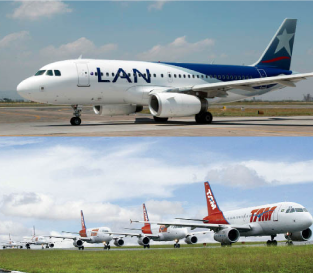


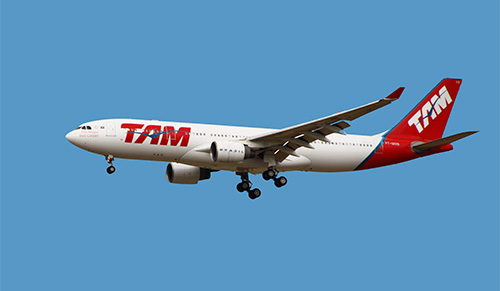

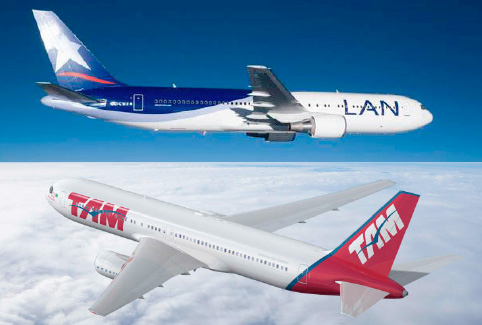
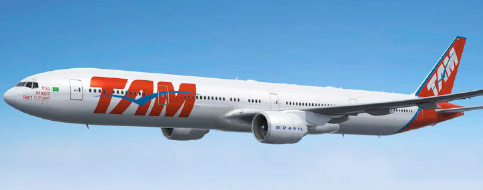
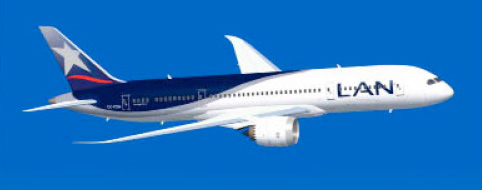

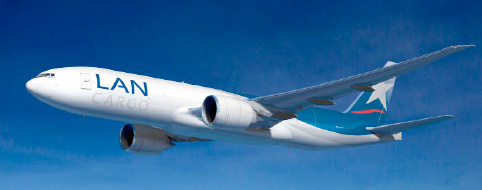
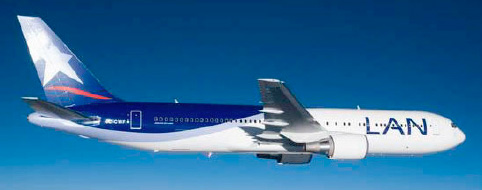
TE Filiales

TE informacionCompania
Chilean Tax N° (RUT): 89.862.200-2
Incorporation: Established as a limited liability company by public deed of 30 December 1983, extended by Public Notary Eduardo Avello Arellano, an extract of which was recorded at Folio 20,341 Nº 11,248 of 1983 of the Santiago Business Register and published in the Official Gazette of 31 December 1983.
By public deed of 20 August 1985, extended by Public Notary Miguel Garay Figueroa, the company became a joint stock company under the name of LÃnea Aérea Nacional de Chile S.A. (now LATAM Airlines Group S.A.). As regards aeronautical and radio communication concessions, traffic rights and other administrative concessions, this company was expressly designated by Law N°18.400 as the legal continuation of the state company created in 1929 under the name of LÃnea Aérea Nacional de Chile.
The Extraordinary Shareholders’ Meeting of LAN Chile S.A. held on 23 July 2004 agreed to change the company’s name to “LAN Airlines S.A.â€. An extract of the public deed corresponding to the Meeting’s minutes was recorded on the Business Register of the Real Estate Registry Office at Folio 25,128 Nº 18,764 of 2004 and was published in the Official Gazette of 21 August 2004. The change of name came into force on 8 September 2004.
The Extraordinary Shareholders’ Meeting of LAN Airlines S.A. held on 21 December 2011 agreed to change the company’s name to “LATAM Airlines Group S.A.†An extract of the public deed corresponding to the Meeting’s minutes was recorded on the Business Register of the Real Estate Registry Office at Folio 4,238 Nº 2,921 of 2012 and was published in the Official Gazette of 14 January 2012. The change of name came into force on 22 June 2012.
LATAM Airlines Group S.A. is subject to the regulation applicable to listed joint stock companies and is registered with the Superintendencia de Valores y Seguros (SVS), Chile’s stock market regulator, under Inscription N° 0306 of 22 January 1987.
Avenida Presidente Riesco 5711, 19th Floor
Las Condes, Santiago, Chile
Tel: (56) (2) 2565 2525
Arturo Merino BenÃtez Airport
Santiago, Chile
Tel: (56) (2) 25652525
LAN – Santiago Stock Exchange
LFL – New York Stock Exchange
LATM33 – Sao Paulo Stock Exchange
Â
Investor Relations
LATAM Airlines Group S.A.
Avenida Presidente Riesco 5711, 20th Floor
Las Condes, Santiago, Chile
Tel: (56) (2) 2565 8785
Email: Investor.Relations@lan.com
Â
Depósito Central de Valores
Huérfanos 770, 22nd Floor
Santiago, Chile
Tel: (56) (2) 2393 9003
Email: atencionaccionistas@dcv.cl
JPMorgan Chase Bank, N.A.
P.O. Box 64504
St. Paul, MN 55164-0504
Tel: General (800) 990-1135
Tel: From outside US (651) 453-2128
Tel: Global Invest Direct (800) 428-4237
Email: jpmorgan.adr@wellsfargo.com
Banco Santander Chile
Bandera 140, Santiago
Custody Department
Tel: (56) (2) 2320 3320
Itaú Corretora de Valores S.A.
Rua UruraÃ, 111 – Prédio II – Piso Térreo
Tatuapé – São Paulo/SP
CEP: 03084-010
Attention: Unidade Dedicada Produto ADR/BDR
Tel.: 55 11 2797 3411
Email: dr.itau@itau-unibanco.com.br
Pricewaterhouse Coopers
Avenida Andrés Bello 2711, Piso 5
Santiago, Chile
Tel: (56) (2) 2940 0000
Complete information about LATAM Airlines:
www.latamairlinesgroup.net
www.lan.com
www.tam.com.br















Fundación de TAM-Transportes Aéreos Regionais por el capitán Rolim Adolfo Amaro.
Inicio de servicios de TAM en ciudades brasileras, especialmente en Mato Grosso y Sao Paulo.
Constitución de Línea Aérea Nacional - Chile Limitada, a través de la CORFO.
LAN se transforma en una sociedad anónima.
TAM adquiere a VOTEC-Brasil Central Linhas Aéreas-, otra aerolínea regional que operaba en los sectores norte y centro de Brasil.
Comienza el proceso de privatización: Gobierno de Chile vende 51% del capital accionario a inversionistas nacionales y a Scandinavian Airlines System (SAS).
Brasil Central es renombrada TAM-Transportes Aéreos Meridionais.
TAM estableció TAM Fidelidade, el primer programa de viajero frecuente en Brasil.
Culmina el proceso de privatizaciónde la compañía con la adquisición de los actuales controladores y otros accionistas del 98,7% de las acciones de la sociedad.
TAM compra la aerolínea Lapsa del gobierno paraguayo y crea TAM Mercosur./ Inicio de vuelos Sao Paulo - Asunción.
LAN lista sus acciones en la Bolsa de Nueva York, siendo la primera aerolínea latinoamericana en transar ADRs en esta importante plaza bursátil.
Llega el primer Airbus A330 y la aerolínea lleva a cabo su primer vuelo internacional desde Sao Paulo a Miami.
Empieza el proceso de expansión de la empresa: inicio de operaciones de LAN Perú.
Se inaugura servicio a Europa a través de un acuerdo de código compartido con Air France a Paris Charles de Gaulle.
LAN se incorpora a ONEWORLD.
Alianza de LAN con Iberia e Inauguración del terminal de Carga en Miami.
Fundación del Centro de Tecnología y Academia de Servicios en Sao Paulo.
Alianza de LAN con Qantas y con Lufthansa Cargo.
Continúa el plan de expansión de la empresa: inicio de operaciones de LAN Ecuador.
Cambio de imagen corporativa: LAN Airlines S.A
TAM comienza a volar a Santiago. Lanzamiento de la nueva clase ejecutiva para los vuelos a Paris y Miami.
Otro paso del plan de expansión regional de LAN: inicio de operaciones de LAN Argentina.
TAM S.A. se lista públicamente en el BOVESPA./ Lanzamiento de vuelo a Nueva York y Buenos Aires.
Lanzamiento de la nueva clase Premium Business.
TAM se lista públicamente en la bolsa de Nueva York / Inicio de vuelos a Londres y vuelos a Zurich y Ginebra a través de su acuerdo con Air France.
Implementación del modelo Low Cost en los mercados doméstico.Aumentode capital por US$ 320 millones.
Lanzamiento ruta Milán y Córdoba. Autorización de ANAC para empezar vuelos a Madrid y Frankfurt
Termina el proceso de renovación de flota de corto alcance, formada ahora por aeronaves de la familia A320.
La compañía recibe su primer Boieng 777-300ER.
Inicio de operaciones de carga en Colombia y de pasajeros en el mercado doméstico de Ecuador.
Lanzamiento de Multiplus Fidelidade. Adquisición de Panmtanal Linhas.
Compra de aerolínea colombiana Aires.
TAM ingresa oficialmente a STAR ALLIANCE.
LAN y TAM firmaron los acuerdos vinculantes asociados a la fusión entre ambas aerolíneas.
Nace LATAM AIRLINES GROUP, a través de la fusión de Lan y Tam.
Colocación de 2,9 millones de acciones.
Aumento de capital por US $940,5 millones.
TAM se une a Oneworld, con lo que Oneworld pasa a ser la alianza global para LATAM Airlines Group.
LATAM lanza su Plan Estratégico 2015 - 2018, con el foco en transformarse en uno de los grupos aéreos más importantes del mundo.
Nace LATAM, la nueva marca que adoptarán LAN, TAM y sus filiales
Emisión de bono estructurado EETC por US$1.020MM: Primera en Latinoamérica.

Personas
LATAM is a multinational and multicultural airline. As of December 2015 the Company’s team was composed of 50,413 employees from 62 different nationalities across 26 different countries.
In this context, its important to highlight the important role that the Human Resources area has played in the last three years, in terms of the mitigation of the impact that any organizational change might have on people’s lives, specially taking into account the multicultural nature of the Company’s employees.
During 2015, LATAM announced a new corporate culture, which defined the central values that inspire the job of the staff, thus establishing a common identity within the organization and facing the client. This corporate culture is funded in four key pillars, being the first one the “passion for security†(security is the main priority). Likewise, LATAM allocates special relevance to customer care, which requires a constant awareness of the customers’ needs and to provide the best service. Within this context is the search of the excellence and constant improvement; and the fourth pillar is the passion for the team (“we work as one team onlyâ€), where each and every one of the members of the Company are recognized as one entity only in order to pursue the common goals.
With regards to the work force’s security, in this period the Company implemented management tools designed to remove potential risks using rules, standards and procedures and its concern was to have the best indicators for this field. Thanks to these measures, the subsidiary Andes –which operates every ground service for the aircrafts– in Chile reduced injury rate in 27%, thus generating direct savings for the Company of nearly US$ 660 thousand per year.
Among the milestones of the period in terms of training, it should be noted the implementation of a new work model that centralizes the design of the training courses, both on-site and e-learning trainings, and the coordination and logistics tasks for the execution of every training for the LATAM Group. For this purpose, LATAM created the School of Excellence and the Shared Services Management.
In the first case, the objective of the centralization is to ensure quality and consistency of the Company’s trainings, also to standardize the study programs and obtain efficiencies of the resources invested in the employees and additional costs related to the design of the training courses to solve common issues. In this context, 159 e-learning courses and 57 on-site courses were completed in the operational and commercial areas.
For its part, in the first stage the coordination and logistics for Chile and Brazil was centralized in the Shared Service Management. The objective of this initiative is to generate efficiencies trough the standardization of tasks. Once the system in fully implemented, the second stage will be carried out, which consists on spreading out the coverage of the service to the rest of the countries where the holding operates.
Additionally, in this period the Company designed and implemented workshops of corporate culture “Building LATAM: Our Purposeâ€, targeted to people that work at the call center areas, sales, airport and onboard service–over 30,000 employees–, as well as introductory courses for new employees from these areas. The most important and innovative aspect of this program is that speakers were executives from the Company. Â
In a complementary way, e-learning workshops were designed and carried out, whose objective was to provide basic management tools for leaders, in the topics related to recruitment interviews and feedback.
Additionally, with the support of LATAM’s Legal area, in 2015 it continued with the development of the Code of Conduct course, transversal within the organization, which pursued to introduce to its over 50,000 collaborators with the framework within which they must carry out their tasks, avoiding potentially illegal actions or situations that would compromise LATAM Airlines Group as a whole. As of December 2015 the degree of achievement was 84%.
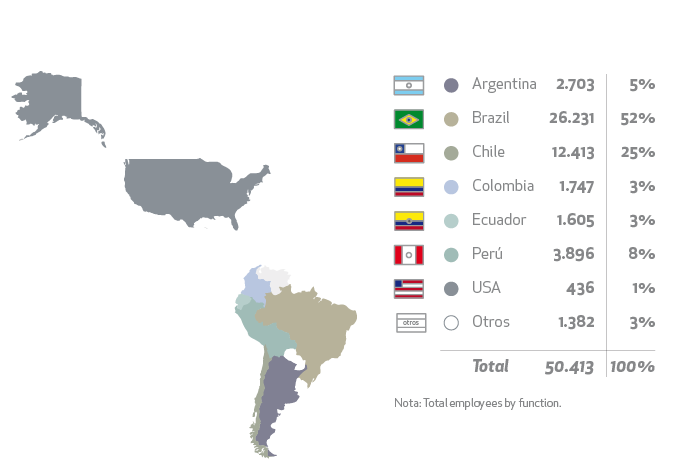
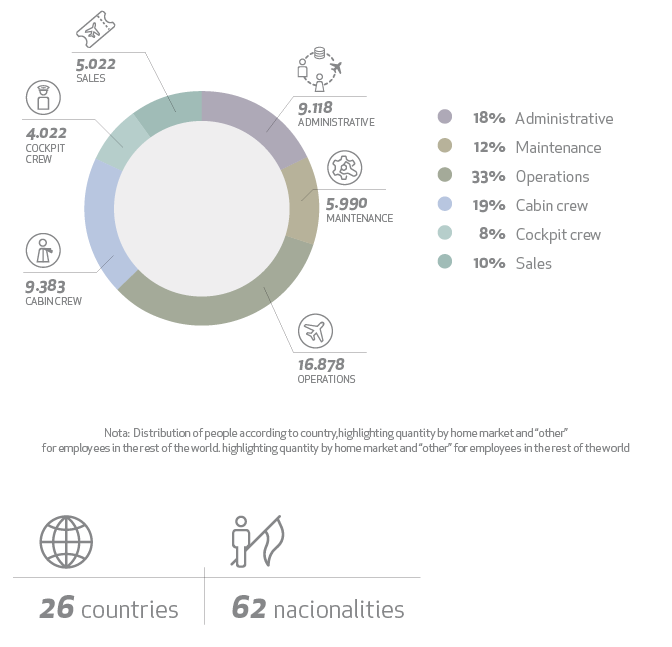

TE estrategiaNegocios
LATAM Airlines Group S.A. (from now on “LATAMâ€, “LATAM Group†or “the Companyâ€) in the largest air transport group in Latina America, with domestic operations in six countries in South America – Argentina, Brazil, Chile, Colombia, Ecuador and Peru – which together represents nearly 90% of the total traffic in the region. This diversification represents a unique competitive advantage in the region, being able to provide the best connectivity within the subcontinent, and to the world and vice versa, providing services to nearly 137 destinations in 25 countries in the world.
During 2015, the Company announced that LATAM is the only corporate identity brand under which all the airlines that belong to the Company will operate, which means that the brands LAN and TAM will disappear. Starting from the first semester of 2016 and gradually, the new corporate image will be displayed in physical spaces, aircrafts, commercial offices, web pages and uniforms, among others, and the estimation is that the brand unification process will be completed in 2018. This decision seeks to combine the best of the two brands and to have one team that identifies with one single airline to face the customers and also internally within the company.
The goal of LATAM is to be positioned among the three most important airline groups worldwide in 2018, and for this purpose it has a clear an defined strategy, based on five critical factors, within which we highlight the network leadership, leader brand and customer experience, and cost competitiveness, pillars that the company has defined as non-negotiable. As such, despite the challenging economic scenario observed in the last year, which has been reflected in the weakening of regional air transport demand, LATAM maintained its strategic plans, thus convinced of the solid and long-term vision of the strategy.
Through the permanent growth of its flight network and connections within South America, to and from the rest of the world, LATAM seeks to provide the best connectivity for its customers. Key in this process is the strengthening of its main hubs in the Spanish speaking countries, with special emphasis on the Guarulhos airport in Brazil, which stands as the main entry point in the region. Additionally, there are multiple alliances and commercial agreements subscribed with the main operators of the industry worldwide, which enables the Company to offer more destinations, better schedules, connections and prices to passengers, reaching nearly 121 additional destinations though these agreements. Â Worth is to highlight that every passenger airlines that belong to LATAM are member of oneworld, the global alliance comprised by the most prestigious airlines in the world.
In terms of service, the focus is to offer passengers the best travel experience and to consolidate its brand leadership in the region. LATAM commitment is to continue investing on mobile technologies and service digitalization, to offer a differentiated value proposal and to position LATAM as the preferred airline in South America, where 2/3 of the passengers in the region will choose as their preferred airline in 2018 (today, one out of two South American passengers chooses one of the Group’s airlines).
Other important aspect of LATAM’s strategy is to have a competitive cost strategy, which is considered a critical factor in this industry to compete profitably. At present, the Company is committed to follow its savings plan, in order to obtain savings equivalent to 5% of operational costs of the Company in 2018. These savings are in addition to the costs optimization related to the fleet optimization plan.
As of December 2015, for its operations LATAM has a fleet of 331 aircrafts, being among the most modern and young fleets worldwide. During this period, the company continued moving forward with the fleet renovation program started in 2012, which consists on the gradual phase out of older aircrafts and their replacement with more efficient and largest aircrafts, and allocating the most adequate ones for each market. This allows the Company to open new routes in a profitable way, and to optimize the fleet and network yields.
Additionally, it’s important to highlight that LATAM carries out a unique business model, based on the successful combination of passengers and cargo operations, which enables the Company to maximize the passengers aircrafts occupancy using the storage space (bellies) to transport cargo, together with the use of specially dedicated freighters, thus diversifying the sources of revenues. The flexibility of this model enables the Company to make their routes profitable, decrease seasonal effects and increase load factors. As of December 2015, 83% of its business came from passengers’ business and the remaining 13% from cargo operations, among others.
A sustainable business model supports all the work carried out by the LATAM GROUP with their different stakeholders. This vision is based on its relationships’ dynamics and businesses that last over time and generates value for the society as a whole.  For LATAM, this is the only possible way to move forward to build its commitment for the future, and is expressed in their daily work.
In this line, LATAM is constantly identifying relevant topics that may impact the Company as well as its stakeholders, which enables it to manage critical issues and establishes action plans in due time to mitigate the main impacts and/ or risks, including their monitoring and yearly follow up, and the dissemination of the results through the sustainability report.
In 2015 different elements were taken into account, such as eco-efficiency management, climate change mitigation, noise reduction, connectivity and relationship with the customer, health and safety on air and ground, talent retention, rotation control, relationship with the government and regulatory specificities, economic and financial sustainability, promotion of sustainable tourism and sustainable management of suppliers.

Directorio
| MAURICIO ROLIM AMARO
Chairman of the Board
RUT: 48.143.165-4
Mr. Mauricio Rolim Amaro has served as member of LATAM Airlines Group’s board of directors since June 2012. He was reelected to the board of directors of LATAM in April 2015 and has served as Chairman since September 2012. Mr. Amaro’s current term as chairman ends in April 2015. Mr. Amaro has previously held various positions in the TAM Group and served as a professional pilot at TAM Linhas Aéreas S.A. and TAM Aviação Executiva S.A. Mr. Amaro has been a member of the Board of TAM S.A. since 2004, and vice-chairman of the Board since April 2007. He is also an executive officer at TAM Empreendimentos e Participações S.A. and chairman of the boards of Multiplus S.A. (subsidiary of TAM S.A.) and of TAM AviaçãoExecutiva e Taxi Aéreo S.A.

| HENRI PHILIPPE REICHSTUL
Director
RUT: 48.175.668-5
Mr. Henri Philippe Reichstul joined LATAM ´s board of directors in April 2014 and was reelected to the board of directors of LATAM in April 2015. Mr. Reichstul has served as President of Petrobras and the IPEA-Institute for Economic and Social Planning and Executive Vice President of Banco Inter American Express S.A. Currently, in addition to Administrative Board member of TAM and LATAM group, he is also a member of the Board of Directors of Repsol YPF, Peugeot Citroen and SEMCO Partners, among others. Mr. Reichstul is an economist with an undergraduate degree from the Faculty of Economics and Administration, University of São Paulo, and postgraduate work degrees in the same discipline - Hertford College - Oxford University.

| JUAN JOSÉ CUETO PLAZA
Director
RUT: 6.694.240-6
Mr. Juan José Cueto Plaza has served on LAN’s board of directors since 1994 and was reelected to the board of directors of LATAM in April 2015. Mr. Cueto is the Vice President Executive of investment Costa Verde S.A., position he has held since 1990, and also serves on the boards of Consorcio logger S.A., Inversiones del Buen Retiro S.A., Costa Verde Aeronáutica S.A., synergy real estate S.A., Valle Escondido S.A., Foundation Colunga and Universidad San Sebastián.

| GEORGES DE BOURGUIGNON
Director
RUT: 7.269.147-4
Mr. Georges de Bourguignon, has served on LATAM Airlines Group’s board of directors since September 2012 and was reelected to the board of directors of LATAM in April 2015. He is co-founder of Asset Chile S.A., a Chilean investment bank, where he works since 199 3 as its Executive Director. He is currently also director of K+S Chile S.A. and Salmones Austral Spa. In the past, has participated in various directories of public and private companies, and non-profit organizations. Between 1990 and 1993 he worked as Manager of Citibank N.A. of financial institutions in Chile and was also Professor of Economics at the Pontifical Catholic University of Chile. The Lord of Bourguignon is an economist at this last University and has a graduate degree in business administration from the Harvard University Business School.

| RAMÓN EBLEN KADIS
Director
RUT: 4.346.062-5
Mr. Ramón Eblen Kadis has served on LAN’s board of directors since June 1994 and was reelected to the board of directors of LATAM in April 2015. Mr. Eblen has served as President of Comercial Los Lagos Ltda., Inversiones Santa Blanca S.A., Inversiones Andes SpA, Granja Marina Tornagaleones S.A. and TJC Chile S.A. Mr. Eblen is a member of the Eblen Group (a major shareholder of LATAM Airlines Group).

| RICARDO J CABALLERO
Director
RUT: 7.758.557-5
Mr. Ricardo J. Caballero joined LATAM’s board of directors in April 2014. Mr. Caballero is the Ford International Professor of Economics and Director of the World Economic Laboratory at the Massachusetts Institute of Technology, an NBER Research Associate, and an advisor of QFR Capital Management LP. Mr. Caballero was the Chairman of MIT's Economics Department (2008 -2011) and has been a visiting scholar and consultant at many major central banks and international financial institutions. His teaching and research fields are macroeconomics, international economics, and finance. His current research looks at global capital markets, speculative episodes and financial bubbles, systemic crises prevention mechanisms, and dynamic restructuring. His policy work focuses on aggregate risk management and insurance arrangements for emerging markets and developed economies. He has also written about aggregate consumption and investment, exchange rates, externalities, growth, price rigidity, dynamic aggregation, networks and complexity. Mr.Caballero has served on the editorial board of several academic journals and has a very extensive list of publications in all major academic journals. In April 1998 Caballero was elected a Fellow of the Econometric Society and subsequently of the American Academy of Arts and Sciences in April 2010.

| CARLOS HELLER SOLARI
Director
RUT: 8.717.000-4
Mr. Carlos Heller Solar,entrepreneur, joined the board of LAN in May 2010 and was re-elected to the Board of Directors of LATAM in April 2015. Mr Heller has extensive experience in the sectors of retail, communications, transport and agriculture. He is President of Grupo Bethia, who in turn owns Axxion S.A. and Betlán two S.A., companies with significant share in LATAM Airlines. In turn presides over the directories of network television Megavision S.A., Club Hipico de Santiago, Falabella Retail S.A., Sotraser S.A., Viña Indómita S.A., Viña Santa Alicia S.A., Blue Express S.A. and Aero Andina S.A. In addition, it is the majority shareholder and President of Azul Azul S.A. dealership of the Corporation of professional football from the University of Chile.

| GERARDO JOFRÉ MIRANDA
Director
RUT: 5.672.444-3
Mr. Gerardo Jofré Miranda, economist and business manager, joined LATAM Airlines’s Board of directors on May 2010 and was reelected to the board of directors of LATAM in April 201 5. Member of the board of Directors of Codelco, Enersis Chile and member of the Board of investment of property funds is roots of Banco Santander. Between 2010 and 2014 was Chairman of Codelco and between 2005 and 2010, he was member of the boards of Endesa Chile S.A., Viña San Pedro Tarapacá S.A., D&S S.A., Construmart S.A., Inmobiliaria Titanium S.A., Inmobiliaria Playa Amarilla S.A and Inmobiliaria Parque del Sendero S.A. He was also President of Foundation know more. Between 2004 and 2005, was the director of insurance for the Americas of the Santander group in Spain. From 1989 to 2004, he was Vice President of the Santander group in Chile, and worked as a Director and Chairman of several companies of that group.

| FRANCISCO LUZÓN LÓPEZ
Director
RUT: 48.171.119-3
Mr. Francisco Luzón López has served on LATAM Airlines Group’s board of directors since September 2012 and was reelected to the board of directors of LATAM in April 201 5. He has served as a consultant of the Inter-American Development Bank (BID) and he has been Teacher “Visiting Leader” of the School of Business China-Europe (CEIBS) in Shanghai. He is currently a member of the board of La Haya and an Independent Director at Willis Group. Between 1999 and 2012, Mr. Luzon served as Executive Vice President for Latin America of Banco Santander. In this period, he was also Worldwide Vice President of Universia SA. Between 1991 and 1996 he was Chairman and CEO of Argentaria Bank Group. Previously, in 1987, he was appointed Director and General Manager of Banco de Vizcaya and in 1988 Counselor and General Director of Banking Group at BBV. During his career Mr. Luzon has held positions on the boards of several companies, most recently participating in the council of the global textile company Inditex-Zara from 1997 until 2012.


Ejecutivos
| ENRIQUE CUETO PLAZA
CEO LATAM Airlines Group
RUT: 6.694.239-2
Mr. Enrique Cueto Plaza is the CEO of LATAM Airlines Group and has served in this position since the merger of LAN Airlines and the Brazilian TAM Linhas Aereas from June 2012. Between 1983 and 1993 was Chief Executive Officer of Fast Air, a Chilean cargo airline. Mr. Cueto has extensive knowledge in the management of airline passengers and cargo, both in commercial and operational aspects, acquired during his 30 years in the airline industry. It is an active member of the Board of Directors of the Alliance Oneworld® and of the Board of Directors of the International Association of air transport (IATA). It is also a member of the Board of the Fundación Endeavor, an organization dedicated to the promotion of entrepreneurship in Chile and President of the Latin American Association and the Caribbean air transport (ALTA).

| IGNACIO CUETO PLAZA
CEO LAN
RUT: 7.040.324-2
Mr. Ignacio Cueto is the CEO of LAN. His career in the airline industry extends more than 25 years. In 1985 he became Vice President of sales at Fast Air Carrier, the largest company in domestic cargo at the time. He led the area shopping and services of that company in the North American market. Subsequently he served on the board of directors of LAN (from 1995 to 1997) and Ladeco (from 1994 to 1997). In addition, he took over as General Manager of LAN CARGO between 1995 and 1998. In 1999 he had under his responsibility the General management of passengers of LAN and in 2005 took over the General management of the company, position that held until the partnership with TAM. In addition, he led the creation of subsidiaries of LAN Airlines in different countries of South America, as well as the implementation of key alliances with other airlines. Mr. Cueto is also a member of the Cueto Group (which is a controlling shareholder of LATAM.

| CLAUDIA SENDER
Mrs. Claudia Sender, is the President of TAM, a position he assumed in May 2013. Mrs. Sender joined the company in December 2011, as Commercial and Marketing Vice-President. After June 2012, with the conclusion of TAM-LAN merger and the creation of LATAM Airlines Group, she became the head of Brazil Domestic Business Unit, and her functions were expanded in order to include TAM’s entire Customer Service structure. Before joining LATAM Airlines, she developed an extensive career in Whirlpool Latin America where she was the Vice President of Marketing for 7 years. She also worked as a consultant at Bain&Company, developing projects for large companies in various industries, including TAM Airlines and other players of the global aviation sector. She has a bachelor degree in Chemical Engineering from the
Polytechnic School at the University of São Paulo (USP) and a MBA from Harvard Business School.

| ARMANDO VALDIVIESO
Senior VP Comercial of LATAM RUT: 8.321.934-3
Mr. Armando Valdivieso Montes is the Senior Vice President commercial, position that he took in the year 2015. Mr Valdivieso was previously the General Manager of LAN after the association between LAN and TAM. Previously, Mr. Valdivieso was General Manager of LAN passenger since 2006. Between 1997 and 2005 he served as General Manager of Carga of Lan Airlines. From 1995 to 1997, he was General Manager de Fast Air. From 1991 to 1994, he served as Vice President at United States of Fast Air with residence in Miami. Mr. Valdivieso is a Civil Engineer and received an Executive MBA from Harvard University.

| CRISTIAN URETA
Cargo- Executive Vice-President
RUT: 9.488.819-0
Mr. Cristian Ureta is the is LATAM’s Cargo Executive Vice-President, position that he took in 2005. From 2002 to 2005 he served as Vice President of production at LAN Cargo. Between 1998 and 2002, he served as Vice President of Planning and Development of LAN Cargo. Previously served as General Manager and commercial Director of MAS Air, and Manager of Fast Air Services. Mr. Ureta is engineer and graduate of the Catholic University and Executive expertise at Stanford University program.

| ROBERTO ALVO
Senior VP International and Alliances LATAM
RUT: 8.823.367-0
Mr. Roberto Alvo Milosawlewitsch, is LATAM’s Senior VP International and Alliances, since 2015. Mr Alvo is in charge of the results of the international passenger business unit and the negotiations on fleet related negotiations. He assumed the position of Senior Vice President Strategic Planning and Development in 2008. Mr. Alvo joined LAN Airlines on November 2001, and has served in various roles within LAN, including as CFO of LAN Argentina, as Vice-president of Development of LAN Airlines and Vice-President of Treasury of LAN Airlines. Before 2001 Mr. Alvo held various positions at Sociedad Química y Minera de Chile S.A., a leading non-metallic Chilean mining company. Mr. Alvo is a civil engineer and obtained an MBA from IMD in Lausanne, Switzerland.

| JEROME CADIER
Chief Marketing Officer
RUT: 24.363.805-4
Mr. Jerome Cadier,is Chief Marketing Officer, a position he assumed in March 2013. Prior to joining LATAM, he worked between 2003 and 2013 in Whirlpool Home Appliances in Brazil where he held the National Sales Manager and Vice President of Marketing . During this period, Jerome also served for two years as President of Whirlpool in Australia and New Zealand. Finally between 1995 and 2002, Jerome was a consultant for McKinsey and Company in Brazil. Mr. Jerome Cadier Industrial Engineering from Escola Politecnica of Sao Paulo (1994) and has a Masters from the Kellogg Graduate School of Management (1999).

| JUAN CARLOS MENCIÓ
Senior VP Legal
RUT: 24.725.433-1
Mr. Juan Carlos Mencio is Senior Vice President of Legal Affairs and Compliance for LATAM Airlines Group since June 1, 2014. Mr. Mencio had previously held the position of General Counsel for North America for LATAM Airlines Group and its related companies, as well as General Counsel for its worldwide Cargo Operations, both since 1998. Prior to joining LAN, he was in private practice in New York and Florida representing various international airlines. Mr. Mencio obtained his Bachelor’s Degree in International Finance and Marketing from the School of Business at the University of Miami and his Juris Doctor Degree from Loyola University.

| EMILIO DEL REAL
Senior VP of Human Resources
RUT: 9.908.112-0
Mr. Emilio del Real Sota, is LATAM’s HR Executive Vice-President, a position he assumed (with LAN) in August 2005. Between 2003 and 2005, Mr. del Real was the Human Resource Manager of D&S, a Chilean retail company. Between 1997 and 2003 Mr. del Real served in various positions in Unilever, including Human Resource Manager for Chile, Manager of Development of Customer Management in Latin America and Recruitment Manager. Mr. del Real has a Psychology degree from Universidad Gabriela Mistral.

| ANDRÉS OSORIO
Chief Financial Officer
RUT: 7.035.559-0
Mr. Andrés Osorio, is LATAM’s Chief Financial Officer (CFO), and has held this position since August, 2013.He holds a Business degree from the Catholic University of Chile and has over 20 years of experience leading financial areas in companies such as Cencosud, where he was CFO for 7 years, and Metrogas, among others. He has also been CEO of Empresas Indumotora, a Chilean automobile conglomerate, and was a partner at PwC in Chile.

| HERNAN PASMAN
Operating Officer
RUT: 21.828.810-3
Mr. Hernan Pasman has been the Chief Operating Officer of Latam airlines group since October, 2015. He joined LAN Airlines in 2005 as a head of strategic planning and financial analysis of the technical areas. Between 2007 and 2010, Mr. Pasman was the Chief operating officer of LAN Argentina, then, in 2011 he served as Chief Executive Officer for LAN Colombia. Prior to joining the company, between 2001 and 2005, Mr. Pasman was a consultant at McKinsey & Company in Chicago. Between 1995 and 2001, Hernan held positions at Citicorp Equity Investments, Telephonic de Argentina and Argentina Motorola. Mr. Pasman is a Civil engineer from ITBA (1995) and obtained an MBA from Kellogg Graduate School of Management (2001).

| ENRIQUE ELSACA
Senior VP Spanish Speaking countries
RUT: 8.732.095-2
Mr. Enrique Elsaca Hirmas has been the Senior Vice President for Spanish Speaking Countries (SCC) at LATAM Airlines since October 2015. Mr. Elsaca joined LAN Airlines in 2004, as Vice-President of Planning. Then, in 2008, he assumed the Vice Presidency of Operations and Services in LAN. In 2012 Mr. Elsaca became Chief Executive of LAN in Chile. Prior to joining the company, Mr. Elsaca worked in Santa Isabel- Cencosud (2000-2004), a Chilean retail company. Between 1997 and 1999, he served as strategic consulting in Booz, Allen & Hamilton, and between 1991 and 1995, he worked in Esso Chile. Mr. Elsaca is a Civil engineer from Catholic University of Chile and obtained an MBA from the MTI Sloan School of Management (1997).

| Board Members | Position | Director’s remuneration (US$) | Comitte of Directors’ fee (US$) | Comitte of Directors’ fee (US$) | Total (US$) |
|---|---|---|---|---|---|
| 2015 | |||||
| Mauricio Amaro | Presidente | 38.315 | 0 | 9.224 | 47.539 |
| Francisco Luzón López | Director | 15.333 | 0 | 10.735 | 26.068 |
| Juan José Cueto Plaza | Director | 21.106 | 0 | 13.839 | 34.944 |
| Ramón Eblen Kadis | Director | 21.106 | 23.150 | 12.261 | 56.516 |
| Juan Gerardo Jofré Miranda | Director | 21.106 | 28.282 | 15.344 | 64.731 |
| Carlos Heller Solari | Director | 15.349 | 0 | 1.527 | 16.876 |
| Georges Antoine de Bourguignon Covarrubias | Director | 21.106 | 28.282 | 12.252 | 61.639 |
| Ricardo J. Caballero | Director | 15.360 | 0 | 9.233 | 24.593 |
| Henri Philippe Reichstul | Director | 21.106 | 0 | 10.804 | 31.909 |
| Board Members | Position | Director’s remuneration (US$) | Comitte of Directors’ fee (US$) | Sub-Comitte fee (US$) | Total (US$) |
|---|---|---|---|---|---|
| Henri Philippe Reichstul | Director | 6.481 | 0 | 1.728 | 8.209 |
| 2014 | |||||
| Mauricio Amaro | Presidente | 46.434 | 0 | 10.109 | 56.543 |
| Francisco Luzón López | Director | 10.502 | 0 | 10.114 | 20.615 |
| Juan José Cueto Plaza | Director | 23.217 | 0 | 15.212 | 38.429 |
| Ramón Eblen Kadis | Director | 23.217 | 28.313 | 15.212 | 66.741 |
| Juan Gerardo Jofré Miranda | Director | 23.217 | 31.084 | 15.212 | 69.514 |
| Carlos Heller Solari | Director | 19.017 | 0 | 0 | 19.017 |
| Georges Antoine de Bourguignon Covarrubias | Director | 23.217 | 31.084 | 11.894 | 66.195 |
| Ricardo J. Caballero | Director | 17.001 | 0 | 11.894 | 28.895 |
For the purposes of its management structure, LATAM Airlines Group S.A. uses names or terms that are standard in local and, particularly, international companies and serve to indicate the seniority of the different executives who comprise its administration as well as their respective salary levels.
In accordance with the above, the internal terms used in LATAM Airlines Group for the purposes of seniority, supervision and salary scales are as follows:
The term “Directorsâ€, used to report the remunerations of the Company’s executives, is used in the sense of these posts or internal terms and not the legal sense envisaged in Section IV of Chile’s Law No. 18.046 on Corporations. The remunerations or fees of the members of the Company’s Board of Directors are reported in the corresponding section of this Annual Report.
In addition, for the purposes of this Annual Report, all reference to “principal executives†is understood to be to the internal posts or levels of Vice-President, General Manager, Senior Director and Director as set out above.
During the year 2015, LATAM Airlines Group paid the whole of its senior executives (considering the levels of Vice Presidents, general managers, Senior managers and directors, according the markings explained above) a total of US$ 40,404,395 and US$ 13,789,916 corresponding to performance incentives, paid in March 2016. Accordingly, the company paid to its senior executives a gross remuneration total of US$ 54,194,311.
During the 2014 LATAM Airlines Group paid a total of US$ 44,133,566 to the whole of their chief executives. Incentives are paid for performance in 2014, so company paid to its senior executives gross remuneration total up to US $44,133,566.
COMPENSATION PLANS
At the Extraordinary Shareholders’ Meeting held on 21 December 2011, the Company’s shareholders approved the issue of 4,800,000 shares for compensation plans for the employees of the Company and its subsidiaries (the “2011Compensation Planâ€).
The principal conditions of the 2011 Compensation Plan are as follows:
The price to be paid for each share allocated to the Compensation Plan, if the respective options are exercised, will be US$17.22. As from the date of its setting, this price expressed in US dollars will be adjusted for the variation in the Consumer Price Index (CPI), published monthly by the US Department of Labor, between the date of setting the price and the date of subscribing and paying the options. The options will be paid in Chilean pesos at the exchange rate for the Dólar Observado (Observed Dollar) published in the Diario Oficial (Official Gazette) at the same date on which they are subscribed and paid.
As of 31 December 2015, a total of 4,518,000 shares from the 2011 Compensation Plan had been assigned to company employees, corresponding almost exclusively to senior executives in the corporate posts indicated above. There remained, therefore, a balance of 282,000 shares that had not been allocated. To date, none of the options has accrued or been exercised in line with point 1 above.
At the Extraordinary Shareholders’ Meeting which took place on 11 June 2013, the Company’s shareholders approved, among other decisions, the issue of 1,500,000 shares for compensation plans for the employees of the Company and its subsidiaries (the “2013 Compensation Planâ€).
The 2013 Compensation Plan has the following general characteristics:

TE practicaGobierno
LATAM Airlines Group S.A. is a listed joint stock company registered with the Superintendencia de Valores y Seguros (SVS), Chile’s stock market regulator, under Inscription N°306. Its shares trade on the Santiago Stock Exchange, Chile’s Electronic Stock Exchange and the ValparaÃso Stock Exchange as well as on the New York Stock Exchange (NYSE) as American Depositary Receipts (ADRs) and on Brazil’s Stock, Commodity and Futures Exchange (BM&FBOVESPA S.A.) in the form of Brazilian Depositary Receipts (BDRs).
LATAM Airlines Group’s corporate governance practices are regulated by Chile’s Securities Market Law (Nº 18.045) and its Corporations Law Nº 18.046 (“LSAâ€), including their associated norms, as well as other norms issued by the SVS. In addition, it is subject to the legislation and regulation of the United States and that country’s Securities and Exchange Commission (SEC) as they apply to the issue of ADRs and the laws and regulation of the Federal Republic of Brazil and the Comissão de Valores Mobiliários (CVM), the country’s stock market regulator, as they apply to the issue of BDRs.
The corporate governance practices of LATAM Airlines Group are subject to constant review in order to ensure that its internal self-regulation processes are totally aligned with the regulation in force and the LATAM’s values.
LATAM Airlines Group’s decisions and commercial activities are underpinned by the ethical principles established in LATAM’s Code of Conduct.
The main bodies responsible for LATAM Airlines Group’s corporate governance are its Board of Directors and the Directors’ Committee (which also fulfills the functions of the Audit Committee required under the Sarbanes-Oxley Act of the United States), together with the Strategy, Finance, Leadership and Product, Brand and Frequent Flyer Program Committees created after the association between LAN Airlines and TAM. The main functions of these bodies are set out below.
LATAM Airlines Group’s Board of Directors has nine members and is the body responsible for analyzing and defining LATAM’s strategic vision, thereby playing a fundamental role in its corporate governance. All the Board seats come up for election every two years and, under LATAM Airlines Group’s statutes, directors are elected through cumulative voting.
Each shareholder has one vote per share and can use all his or her votes to support one candidate or divide them among any number of candidates. This arrangement ensures that a shareholder with more than a 10% stake can elect at least one director. The present Board of Directors was elected by the Ordinary Shareholders’ Meeting which took place on April 28th, 2015.
LATAM Airlines Group’s Board holds ordinary monthly meetings and extraordinary meetings whenever the Company’s affairs so require. Directors’ fees must be approved by vote at the Ordinary Shareholders’ Meeting. The Directors’ Committee usually meets monthly and its functions and powers are those established by the applicable legislation and regulation.
Under Chilean law, listed joint stock companies must appoint at least one independent director and a Directors’ Committee when they have a market capitalization of at least 1,500,000 unidades de fomento (an inflation-indexed currency unit) and at least 12.5% of the voting shares are held by shareholders who individually control or possess less than 10% of these shares. Three of the nine Board members form a Directors’ Committee, which fulfills both the functions required under Chile’s Corporations Law and those of the Audit Committee required under the Sarbanes-Oxley Act of the United States and the corresponding SEC norms.
The Directors’ and Audit Committee has the functions established in Article 50 bis of Chile’s Corporations Law (Nº 18.046) and the other applicable regulation. These include:
To examine the reports of LATAM Airlines Group’s external auditors, general balance sheets and other financial statements that LATAM Airlines Group’s administrators provide to shareholders and to express an opinion about these reports prior to their presentation for approval by shareholders.
The requirements for directors’ independence are set out in Chile’s Corporations Law (Nº 18.046) and its subsequent modifications under Law Nº 19.705 on the relationship between directors and LATAM’s controlling shareholders.
A director is considered independent when he or she does not, in general, have ties, interests or economic, professional, credit or commercial dependence of a significant nature or size with or on the company, the other companies in the group of which it forms part, its controller or principal executives or a family relationship with the latter or any of the other types of ties specified in Law Nº 18.046.
Under US regulation, it is necessary to have an Audit Committee, comprising at least three Board members, that fulfills the independence requirements established under Rule 10A of the Exchange Act.
As of 31 December 2015, all the members of the Directors’ Committee, who also act as part of the Audit Committee, were independent directors as defined under Rule 10A of the Exchange Act. At that date, its members were Messrs. Ramón Eblen Kadis, Georges de Bourguignon Arndt and Juan Gerardo Jofré Miranda (chairman of the Committee). For the purposes of Chile’s Corporations Law (Nº 18.046), Ramón Eblen Kadis is not considered an independent director. Committee members have not changed in the last two years.
In accordance with article 5°, subsection 8° of article 50 bis under the Corporations Law No. 18,046, the Directors’ Committee of LATAM Airlines Group S.A. (the “Company†or “LATAMâ€), issues the annual management for 2015.
1. Integration of the Directors’ Committee and Sessions
The members of the Directors’ Committee of the Company are Messrs. Gerardo Jofré Miranda, Georges de Bourguignon Arndt and Ramón Eblen Kadis. Messrs. Jofré and De Bourguignon are considered independent directors of the Company. Gerardo Jofré Miranda chairs the Directors’ Committee.
The directors were appointed in the Ordinary Shareholders’ Meeting held on April 28, 2015, for a two-year period pursuant the bylaws of the Company.
2. Report of the Committee’s Activities
During 2015, the Directors’ Committee held twenty-one sessions, in order to exercise its functions and fulfill its obligations pursuant to article 50 Bis under the Corporations Law No. 18,046, and also to undertake those other issues that the Directors’ Committee decided to review, revise or evaluate. Please find below the main topics covered.
Test and Review of the Balance Sheet and Financial Statements Â
The Directors’ Committee tested and reviewed the financial statements of the Company as of December 31, 2014, as well as the quarterly statements as of March 31, June 30 and September 30, understanding the tests of the respective reports of external auditors of the Company. The External Auditor of the Company participated in their respective sessions of the Committee, for the purpose of providing the opinion related to the audit and to inform the relevant issues of the review, the main aspects of internal control and communications required by the regulators of External Auditor, and including in every occasion the confirmation of (i) didn’t experience any difficulties to carry out the audit, (ii) didn’t have any difference of opinion with the Management, and (iii) didn’t came up any facts that represented a threat to its independence.
Likewise, KPMG in its capacity as external auditor of TAM S.A. and subsidiaries participated in two sessions of the Directors’ Committee, with the purpose of presenting the main aspects of the external audit of TAM, the main focuses of its review process and internal control aspects.
Review of the Cash Generating Units Impairment Reports
In the session held on March 16, 2015, the Directors’ Committee examined and analyzed the impairment reports of the cash generating units of the Company, in accordance with the reports issued by the management of the Company and by Deloitte, acting as the consulting firm, hired for the purpose, being present at the session. The external audit company updated the report and was reviewed by the management in the session held on August 12, 2015, where the External Auditor of the Company was present.
Systems of Compensation for Executives and Employees Â
In the sessions held on April 6 and December 4, 2015, the Directors’ Committee examined the systems of remunerations and compensation plans for managers, main executives and employees of the Company. In those sessions the Committee examined the plans proposed by the management and the reports of external consultants hired by the Vice Presidency of Employees of the Company. Other matters related to the human resources area of the Company incudes topics such as (i) performance review of main executives (ii) approval of variable compensation payments (iii) organizational environment and (iv) succession plans, who were evaluated and reviewed in the Leadership Committee of the Company.
Control of Operations with Related Parties
In the sessions held on June 30, November 6 and December 4, 2015, the Directors’ Committee reviewed the Policy on Regular Operations of the Company and the compliance with the legal and accounting regulations related to the control and report of operations with related parties, and carried out a review process of such policy and the controls associated, which will be completed in 2016. In these meetings, the transactions that pursuant to the legal and accounting regulation applicable to the Company were reviewed, which are considered operations with related parties, and was approved by the Committee.
Corporate Governance Practices
In order to comply with General Rule No. 385 of the Superintendence of Securities and Insurance (“NCG 385â€), in the sessions held on September 10, November 20 and December 14, 2015, the Directors’ Committee, analyzed and examined the corporate governance practices of LATAM for 2015, according to the questionnaire provided in Addendum I of General Rule No. 385. In those sessions the Committee evaluated corporate improvements to corporate governance practices of the Company, some of which were recommended to the Board of Directors for their implementation, such as the approval of the Integrated Risk Management Policy, the Contracting of Additional Services from External Auditors Policy and the Induction for New Directors Policy.
Contracting of Additional Services from External Auditors.
 In the sessions held on January 26, June 1st and June 30, 2015, the Directors’ Committee examined and evaluated the rules and guidelines for the control of additional services from external auditors, including the fulfillment of legal regulations in Chile and abroad, thus approving a Contracting of Additional Services from External Auditors Policy, which was recommended and approved ultimately by the Board of Directors of the Company.
 Evaluation and Implementation of Corporate Policies
In 2015, during several sessions of the Directors’ Committee, the analysis of the need to carry out corporate policies in matters of risk and tax management continued, with the purpose to implement a management model for those risks that might impact sustainability, the operational continuity or that might have an impact on customers, people or the environment, in one part, and compliance with the obligations of the Company and the adoption of tax criteria, which resulted in the approval of the Integrated Risk Management Policy of LATAM and the Tax Policy of LATAM, which were recommended and approved ultimately by the Board of Directors of the Company.
 In accordance with the Integrated Risk Management Policy of LATAM, the Directors’ Committee is committed to supervise, analyze and evaluate the development and the management of the Risk Management System of LATAM Airlines Group, along with reporting and to inform the Board of Directors of the results of the supervision, analysis and evaluation.
In several sessions the Committee analyzed deeply certain risks of the Company together with the Risk Manager.
Internal Audit
 In five sessions the Directors’ Committee examined and reviewed the audit and control reports issued by the external auditor of LATAM. In these sessions the audit work performed in 2015 was approved, and throughout the year informed of its main results.
Likewise, the complaints received from the established channels of the Company for that purpose were informed.
 Recommendations of the Directors’ Committee
On the other hand, the Directors’ Committee made the recommendations mentioned below to this annual management report, with the occasion of the appointment of external auditors of the Company and the private risk rating agencies for 2015.
Activities by Session of the Directors’ Committee Report
Notwithstanding the above, the Directors’ Committee met and held sessions in the opportunities mentioned below, where we present a summary of the matters discussed in each session.
1) Ordinary Session N°151 26/01/15
2) Extraordinary Session N°32 16/03/15
3) Ordinary Session N°152 17/03/15
4) Extraordinary Session N°33 20/03/15
5) Ordinary Session N°153 06/04/15
6) Ordinary Session N°154 04/05/15
7) Extraordinary Session N°34 14/05/15
8) Extraordinary Session N°35 19/05/15
9) Ordinary Session N°155 01/06/15
10) Ordinary Session N°156 30/06/15
11) Extraordinary Session N°36 02/07/15
12) Ordinary Session N°157 03/08/15
13) Extraordinary Session N°37 13/08/15
14) Ordinary Session N°158 28/08/15
15) Extraordinary Session N°38 10/09/15
16) Ordinary Session N°159 01/10/15
17) Ordinary Session N°160 06/11/15
18) Extraordinary Session N°39 12/11/15
19) Extraordinary Session N°40 20/11/15
20) Ordinary Session N°161 4/12/15
21) Extraordinary Session N°41 14/12/15
3. Remunerations and Expenses of the Directors’ Committee
The Ordinary Shareholders Meeting of the Company, held on April 28, 2015, agreed that every member of the Committee receives a monthly allowance of the equivalent to 67 Unidades de Fomento for attending the Directors’ Committee sessions.
For the operation of the Directors’ Committee and its advisors, Corporations Law established that the expense budget has to be at least the same as the annual remuneration of the Committees’ members, and therefore in the aforementioned Ordinary Shareholders Meeting a budget of 2,412 Unidades de Fomento for 2015 was approved.
Therefore, the expenses of the Directors’ Committee are related with the monthly allowances for attendance to the sessions, without having any other expenses or outflows to inform.
4. Recommendations of the Directors’ Committee.
4.1 Proposal of External Auditors’ Appointment.
In accordance with article 5°, subsection 8° of article 50 bis under the Corporations Law No. 18,046, the Directors’ Committee of LATAM Airlines Group S.A. (the “Company†or “LATAMâ€), issues the annual management for 2015.
At the Directors’ Committee session held on April 6, 2015 and in accordance to article 2) of subsection eight of article 50 bis under Corporations Law No. 18.046, the Directors’ Committee agreed to propose the External Auditors to the Board of Directors to be suggested at the Ordinary Shareholders Meeting to be held on April 28, 2015. In this regard, the Committee proposed to the Board of Directors the appointment of PriceWaterhouseCoopers Consultores, Auditores y CÃa. Limitada (“PWCâ€) and KPMG Auditores Consultores Ltda (“KPMGâ€) as Auditors of the Company, in this order of priority, but notwithstanding the recommendation to maintain PWC as the Audit Company for 2015.
The Director’s Committee recommendation to maintain PWC as the external auditor of the Company for 2015 is based on the following reasons and fundamentals:
4.2Â Â Â Â Â Â Proposal of Private Risk Rating Agencies.
The Directors’ Committee in session held on April 6, 2015 and in accordance with article 2) subsection 8° of article 50 bis under the Corporations Law No. 18,046, agreed to propose the Board of Directors the risk rating agencies to be suggested at the Ordinary Shareholders Meeting to be held on April 28, 2015. In this regard, the Committee agreed to propose the Board of Directors of the Company the appointment of Fitch Chile Clasificadora de Riesgo Limitada and Feller-Rate Clasificadora de Riesgo Limitada.
In accordance with the shareholders’ agreement of 25 January 2012 between LATAM Airlines Group S.A. (previously LAN Airlines S.A.) and TEP Chile S.A., the Ordinary Board Session of 3 August 2012 established the following four committees to review, discuss and make recommendations to the Board about the issues related to their respective areas of responsibility:
(i) Strategy Committee, (ii) Leadership Committee, (iii) Finance Committee, and (iv) Brand, Product and Frequent Flyer Program Committee. In accordance with the said shareholders’ agreement, each subcommittee will comprise two or more directors of LATAM Airlines Group and at least one of their members must be a director elected by TEP Chile S.A.
The Strategy Committee will focus on corporate strategy, current strategic affairs and the three-year plans and budgets of the main business units and functional areas and high-level review strategies. The Leadership Committee will focus on areas that include group culture, high-level organizational structure, appointment of the executive vice-president of LATAM Airlines Group (henceforth, “CEO of LATAMâ€) and those who report to this person, the philosophy of corporate remunerations, structures and levels of remunerations and objectives for the CEO of LATAM and other key staff, the succession or contingency plan for the CEO of LATAM and evaluation of the performance of the CEO of LATAM.
The Finance Committee will focus on financial policies and strategy, capital structure, control of compliance policies, tax optimization strategy and the quality and reliability of financial information. Finally, the Brand, Product and Frequent Flyer Program Committee will focus on brand strategies and brand construction initiatives for corporate brands and those of the principal business units, the principal characteristics of products and services for each of the principal business units, the strategy of the Frequent Flyer Program and its key characteristics and regular auditing of the brand’s performance.
In addition, by agreement of the Board of LATAM Airlines Group S.A., during the board of directors’ meeting No. 389 on 10 June 2014, a Risk Committee was formed with the purpose of supervising the implementation of the Risk management success factor, included in LATAM’s Strategic Plan, and particularly to oversee LATAM Airlines Group’s risk management of risks of LATAM Airlines Group and ensure a corporate risk matrix structuring.
|Â RELATED-PARTY TRANSACTIONS
Under Chile’s Corporations Law, a listed company’s operations with a related party must take place in market conditions and comply with certain authorization and disclosure requirements that are different from those applying to a non-listed company. This applies to listed companies and their subsidiaries.
LATAM Airlines Group has carried out different transactions with its subsidiaries, including entities owned or controlled by some of its majority shareholders. In the normal course of LATAM’s business, different types of services have been provided to or received from related companies, including the rental and exchange of aircraft and cargo transport and booking services.
LATAM Airlines Group’s policy is not to carry out transactions with or for the benefit of any shareholder or Board member or with any entity controlled by these persons or in which they have a significant economic interest, except when the transaction is related to LATAM and the price and other terms are at least as favorable for the LATAM as those which could be obtained from a third party under market conditions.
These transactions are summarized in the audited consolidated financial statements for the year ending on 31 December 2015.
Finally, and along with the rules laid down in the Code of Conduct of LATAM Airlines Group on this matter, for the purposes of letter b) of the last point of Article 147 of Law No. 18.046 on Corporations, LATAM Airlines Group has a general policy on habitual operations which was approved by its Board of Directors in its Session of 29 December 2009 and reported as material news to the Superintendencia de Valores y Seguros on that same date. The operations indicated in this general policy on habitual operations may be carried out without the requirements envisaged in the said Article 147.
LATAM Airlines Group’s good corporate governance is the result of the interaction of different individuals and stakeholders.
Although all employees share responsibility for compliance with the high standards of ethics and adherence to regulation established by LATAM Airlines Group’s Board of Directors, it is the Board, the Directors’ Committee and the Company’s principal executives who are primarily responsible for LATAM Airlines Group’s good corporate governance. In line with the above, LATAM Airlines Group is committed to transparency and compliance with the ethical and regulatory standards established for this purpose by its Board of Directors.
Notwithstanding the responsibilities of the Company’s Board of Directors and its Directors’ Committee, LATAM Airlines Group’s administration has also taken a number of measures to ensure due corporate governance. These include principally:
The LATAM Group has an Ethics Complaints Channel (www.etica-grupolatam.com). This facility provide employees with a direct and private online channel through which to report any concerns in the knowledge that these will be properly processed or investigated without any risk of reprisal against the person reporting them.
On March 31, 2015, the Report on LATAM’s Corporate Practices which was approved by LATAM Airlines Group’s Board of Directors and prepared in accordance with General Norm N° 341 issued by the Superintendencia de Valores y Seguros (SVS) on 29 November 2012., was dispatched to this same organism.The information required under this norm is as of December 31 of each year and must be presented by March 31 of the subsequent year.
The information filed annually with the SVS must refer to the following matters:

TE EstructuraPropiedad
As of December 31, 2015, LATAM Airlines Group had a total of 1,563 shareholders in its register and is controlled by the Cueto group.
| COSTA VERDE AERONAUTICA SPA | 12,000,000 | 2.2% |
|---|---|---|
| DECEMBER 31 OF 2015 | ||
| Shareholder | Nº Offshares 2015/12/31 | % |
| COSTA VERDE AERONAUTICA SA | 90,427,620 | 16.6% |
| TEP CHILE SA | 65,554,075 | 12.0% |
| INVERSIONES NUEVA COSTA VERDE AERONAUTICA LTDA | 23,578,077 | 4.3% |
| BANCO DE CHILE POR CUENTA DE TERCEROS NO RESIDENTES | 22,557,207 | 4.1% |
| J P MORGAN CHASE BANK | 21,339,756 | 3.9% |
| BANCO ITAU POR CUENTA DE INVERSIONISTAS EXTRANJEROS | 18,653,574 | 3.4% |
| AXXION S A | 18,473,333 | 3.4% |
| INVERSIONES ANDES SPA | 17,146,529 | 3.1% |
| INVERSIONES HS SPA | 14,894,024 | 2.7% |
| LARRAIN VIAL S A CORREDORA DE BOLSA | 12,986,050 | 2.4% |
| BANCHILE C DE B S A | 12,416,588 | 2.3% |
| BANCO SANTANDER POR CUENTA DE INV EXTRANJEROS | 11,174,043 | 2.0% |
|---|---|---|
| DECEMBER 31 OF 2014 | ||
| Shareholder | Nº Offshares 2014/12/31 | % |
| COSTA VERDE AERONAUTICA SA | 85,772,914 | 15.7% |
| TEP CHILE SA | 65,554,075 | 12.0% |
| J P MORGAN CHASE BANK | 41,936,775 | 7.7% |
| INVERSIONES NUEVA COSTA VERDE AERONAUTICA LTDA | 22,928,277 | 4.2% |
| BANCO DE CHILE POR CUENTA DE TERCEROS NO RESIDENTES | 21,904,156 | 4.0% |
| COSTA VERDE AERONAUTICA SPA | 20,000,000 | 3.7% |
| BANCO ITAU POR CUENTA DE INVERSIONISTAS | 19,744,217 | 3.6% |
| AXXION S A | 18,473,333 | 3.4% |
| INVERSIONES ANDES SPA | 17,146,529 | 3.1% |
| INVERSIONES HS SPA | 14,894,024 | 2.7% |
| LARRAIN VIAL S A CORREDORA DE BOLSA | 12,361,609 | 2.3% |
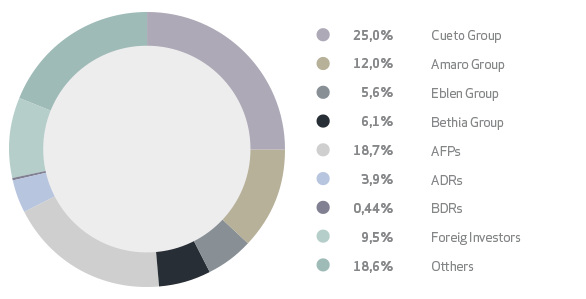

LATAM Airlines Group’s policy is to pay the minimum dividends required by law or, in other words, 30% of profits in accordance with the regulation in force. This does not, however, preclude the distribution of dividends above this obligatory minimum level depending on the particular events and circumstances that may arise during the year.
No dividends were distributed in years 2013, 2014 and 2015 since LATAM reported net losses.
Going forward the company does not expect changes in dividend policy.

TE politicaFinanciera
The Directorate of Corporate Finance is responsible for managing the company’s Financial Policy.  This Policy enables LATAM to respond effectively to external conditions for the normal operation of the business, and thus maintain and anticipate a stable flow of funds to ensure continuity of its operations.
Additionally, the Finance Committee, formed by the Executive Vice-President and Members of the Board of Directors of LATAM, meets periodically to review and make recommendations to the Board about matters not regulated by the Financial Policy.
LATAM Airlines Group’s Financial Policy seeks the following objectives:
The Financial Policy establishes guidelines and restrictions for managing operations related to Liquidity and Financial Investments, Financing Activities and Market Risk Management.
In 2015 LATAM Airlines Group carried out market operations to maintain adequate liquidity levels, ending December 2015 with a liquidity ratio of approximately 13,4% of total sales.
In this context, short-term debt of LATAM was approximately US$387 million at the end of 2015, slightly higher than December 2014. Additionally, in 2015 the company increased debt in approximately US$324,6 million, which is mainly explained by the liability management transaction carried out in June 2015, in which LATAM issued a US$500 million long term bond in the international markets, and interest rate at 7.25%, and also made full payment of the US$300 million bond issued by the company TAM Capital 2, Inc., interest rate at 9.50%. These operations pursued liquidity growth and to reduce the group’s leverage rate levels at the same time.
 In 2015, LATAM maintained adequate liquidity levels, which is consistent with the objective of safeguard the company from potential external shocks and volatility and cycles inherent of the industry. The long-term objective is to maintain liquidity ratio around 15%.
In 2015, LATAM maintained adequate liquidity levels, which is consistent with the objective of safeguard the company from potential external shocks and volatility and cycles inherent of the industry. The long-term objective is to maintain liquidity ratio around 15%.
Additionally, LATAM accounted at the end of 2015 committed credit facilities of US$105 million with financial institutions, both local and international, which at the end of the period has not been used. On March 29, 2016, these facilities were replaced by a revolving committed line of credit, which is secured by airplanes, engines and parts for a total amount of up to US$375 million.
Additionally, in 2015 the company continued to finance an important part of the fleet pre-delivery payments with its own resources, those related to the aircrafts that LATAM will receive in the future, for the Boeing and Airbus aircrafts. As of December 31, 2015, LATAM Airlines Group accounted US$1,361 million in cash and easily convertible securities and US$409.6 million in advances on aircraft financed with its own funds.
The objective of the company’s Financial Investment Policy is to centralize the investment decisions, in order to optimize profitability, adjusted by currency risk, and maintain adequate security and liquidity levels.
Additionally, the company manages risk through counterpart diversification, terms, currencies and instruments.
The scope of LATAM’s Financing Policy is to centralize financing activities and balance the useful life of assets with debt maturities.
The vast majority of LATAM Airlines Group’s investments are fleet acquisition programs, which are generally financed through the combination of own resources and long-term structured financial debt. Usually, LATAM finances between 80% and 85% through bank loans or bonds guaranteed by export promotion agencies, and the rest through commercial loans or its own funds.
Payment maturities of the different financing structures vary from 12 to 16 years, being the vast majority at 12 years. Additionally, important portion of LATAM’s fleet acquisition undertakings take the form of operational leasing arrangements as additional financing measure.
Looking forward to diversify financing alternatives for airplanes, LATAM carried out on May 29, 2015 a private placement of debt certificated named Enhanced Equipment Trust Certificates (“EETCâ€) for an aggregate amount of US$ 1.020,8 million. The execution of this operation allows the Company to broaden our aircrafts financing alternatives and mainly allowed the financing of the acquisition of eleven new Airbus A321-200 airplanes, two Airbus A350-900 airplanes and four Boeing 787-9 airplanes, whose deliveries were scheduled between July 2015 and March 2016. The acknowledgement of the debt is against the delivery of the planes, thus as of December 31, 2015 it was US$675.7 million.
In the case of short-term financing, LATAM held as of December 31, 2015, approximately 4% of its total debt in the form of exporter and importer loans, looking forward to finance working capital needs.
A further objective of the Financing Policy is to ensure a stable profile of debt maturity and leasing commitments, including debt service and fleet rental services, which has to be consistent with the operational cash flow generation of LATAM.
Due to the nature of its operations, LATAM Airlines Group is exposed to market risks such: (i) fuel-price risk, (ii) interest rate risk and y (iii) exchange rate risk. Looking forward to the total or partial hedging against these risks, LATAM uses derivatives to fix or cap the increases of underlying assets. Market Risk management is carried out on a comprehensive manner and takes into account the correlation between each exposure. In order to operate with counterparties, the Company must have a line and an ISDA or LFC contract signed with the chosen counterpart. Counterparts must have a Risk Rating equivalent to “A-“ issued by an International Rating Agency.
i.Fuel-price risk:
Variations in fuel prices depend on an important extent on the oil demand and supply worldwide, the decisions taken by the Organization of Petroleum Exporting Countries (“OPEPâ€), the refining capacity worldwide, the stock levels available, the occurrence of weather phenomena and geopolitical factors. LATAM buys aircraft fuel known as Jet Fuel 54. There is an international reference index for this underlying asset – the US Gulf Coast Jet 54, which was used by LATAM Airlines Group for hedging purposes in 2015.
The Fuel Hedging Policy limits the minimum and maximum range of fuel to hedge, according to the capacity to transfer cost variations and market scenarios reflected in fuel prices. Additionally, the Policy narrows the hedging maximum term and allows portfolio restructuring.
In relation to the fuel hedging instruments, the Policy allows the use of Swaps and Options combined.
ii.Interest-rate risk of cash flows:
The variation of interest rates is strongly linked to the international economic situation. An improvement in the long-term economic outlook leads to an increase in long-term interest rates, while a decline causes a decrease due to market effect. However, taking into account the government intervention, in economic contraction periods, benchmark interest rates tend to decrease in order to boost domestic demand to make credit more accessible to everyone and raise production (likewise, there are benchmark interest rate hikes in economic growth periods).
Uncertainty on market and governments behaviors, which impact interest rates variations, creates debt risk on LATAM debt, which is linked to floating-rate and its investments. Debt interest-rate risk is equivalent to future cash-flows risk of financial instruments, due to fluctuations of the markets interest-rates.
LATAM’s exposure to market interest-rate changes is mainly related to long-term floating-rate liabilities.
 In order to reduce the risk related interest rates growth, LATAM Airlines Group has interest-rate swaps and call options contracts outstanding. The instruments approved by the Interest-Rate Hedging Policy are Swaps and Options on interest rates.
In order to reduce the risk related interest rates growth, LATAM Airlines Group has interest-rate swaps and call options contracts outstanding. The instruments approved by the Interest-Rate Hedging Policy are Swaps and Options on interest rates.
iii. Exchange rate risk:
The US dollar is the functional currency used by the Company to determine the prices of its services, the structure of its classified statement of financial position and the effects on its operating results. There are two types of exchange-rate risk: flow risk and balance sheet risk. Flow risk arises as a result of the net position of revenues and costs in currencies other than US dollar.
LATAM sells most of its services in US dollars, in prices equivalent to the US dollar or in Brazilian reais. Approximately 60% of its revenues are denominated in US dollars, while approximately 25% is in Brazilian reais
A large part of costs are denominated in US dollars or equivalents to the US dollar, especially fuel costs, airport charges, aircraft rentals, insurance and aircraft parts and accessories. Salaries on the other hand, are denominated in local currencies. The total percentage of costs denominated in US dollars is around 67%, while the approximate percentage of costs denominated in Brazilian reais is 19%.
LATAM Airlines Group’s cargo and international passenger businesses prices are mostly defined in US dollars. In the domestic businesses, there is a mix: sales in Peru are mainly denominated in local currency; nonetheless prices are indexed to the US dollar. In Brazil, Chile, Argentina and Colombia, prices are denominated in local currency without any form of indexation. In Ecuador, in relation to prices for the domestic business, both prices and sales are denominated in US dollars. As a result of the above, LATAM is exposed to fluctuations in different currencies including, principally, the Brazilian reais, the Chilean peso and the euro.
LATAM Airlines Group has hedged against exchange-rate risk by acquiring currency forwards. As of December 31, 2015, LATAM accounted hedging mainly for the Brazilian reais for US$270 million for the period January-June 2016.
On the other hand, balance sheet risk occurs when items included in the balance sheet are exposed to variations of exchange rates, because these items are denominated in a currency different than the functional currency. LATAM’s policy allows it to acquire derivatives for protection against the appreciation or depreciation of currencies in relation to the functional currency used by the parent company. In 2015, LATAM didn’t contract any hedging for balance sheet risk coverage.
The main mismatch factor is in TAM S.A., whose functional currency is the Brazilian reais, meanwhile a large part of its liabilities are denominated in US dollars. By the end of 2015, this mismatch accounted less than US$700 million.

TE OperacionInternacional
LATAM is the main international flight operator in the region, offering its passengers the broader connectivity network of the industry, serving 45 international destinations (in addition to the domestic network) in 23 countries, using an average total fleet of 112 aircrafts during the period. LATAM’s passenger operations include both regional flights in South America and the Caribbean and long-haul flights connecting the region with the rest of the world.
During 2015 LATAM carried 14.2 million passengers, increasing 3.9% compared to the previous year. Out of these passengers, 8.5 million flew domestic routes, and 5.7 million flew long-haul routes.
In this period, the international passengers operation developed in a complex environment in South America, with low economic growth in the Spanish speaking countries in which LATAM operates, and negative growth and high inflation mainly in Brazil, in addition to important devaluations of Latin American currencies, in particular the Brazilian reais and the Colombian peso. Additionally, the Company faced important imbalances of supply and demand, mainly in the routes from Brazil to the United States, which prompted a substantial decline in average prices.
In order to mitigate the impact of this challenging scenario, LATAM reduced its capacity offer in the Brazil to United States routes, thus promoting the more demanded routes, such as The Caribbean and Europe. Strengthening its main international hub at the Guarulhos Airport, Sao Pablo, the Company complemented this strategy. Therefore, the consolidated international passengers traffic transported by LATAM (RPK) increased 5.4% compared to the previous year, while its capacity measured in ASK grew 6.4%, resulting in a load factor of 84.6%, showing a 0.8% decrease over 2014.
At a regional level, every airline of LATAM Group served 28 destinations, including four destinations in the Caribbean, for whose purpose the Company used a fleet mainly comprised by aircrafts from the Airbus 320 family. Its broad network coverage allowed LATAM to maintain its leading position in the domestic routes market, with 42.9% market share measured in (ASK). The main competitors in these routes are Avianca, AerolÃneas Argentinas, Gol and Tame, reaching market shares of 22.1%, 10.5%, 9.4% and 4.2%, respectively in the period.
As part of the objective of the Company to provide the best connectivity to its passengers in the region, LATAM increased 75% its offer to the Caribbean, mainly through the new routes to Punta Cana (Dominican Republic) from Buenos Aires, Brasilia and Bogota. Additionally, during the year LATAM opened new routes Buenos Aires-Brasilia and Buenos Aires-Recife, and also the new Sao Paulo (Guarulhos)-Punta del Este route.
One of the milestones of the period was the opening of the Antofagasta-Lima route in December, with three weekly frequencies; therefore the Antofagasta airport became the second international terminal in Chile with scheduled flights. In addition, in the new route Montevideo-Lima will be inaugurated in January 2016, while promoting the Lima hub, which connects South America with Central America, United States and Europe.
With regards to the long-haul routes, as of December 2015 the Company covered 27 destinations, being the Unites States and Europe the most relevant markets and therefore important strategic markets for LATAM. In order to develop its long-haul operations, the Company uses mainly Boeing B767 and B787-8/9 aircrafts. Worth is to mention that in this period the phase out of the Airbus A340 fleet was completed, model that LAN used for almost 15 years to serve the Santiago-Auckland-Sydney route, this model was replaced by the Boeing 787-8 and afterwards by the B787-9. These aircrafts are more modern, more efficient and have greater capacity, and its incorporation in 2015 is also meant to reinforce the operations for the Santiago-Madrid and Santiago-Lima-Los Angeles routes.
Furthermore, in December the first Airbus A350 aircraft was incorporated to the fleet of TAM, with the mission of becoming one of the main aircrafts to operate long-haul flights to United Stated and Europe. This aircraft will begin operating in the Sao Paulo (Guarulhos)-Madrid route in April 2016, and will operate in the second semester in the Sao Paulo-Orlando route, becoming the first airline in the Americas to operate this state of the art aircraft.
With regards to North America, LATAM’s market share reached 24.3% (22.8% in 2014) measured in ASK, being American Airlines, United Continental and Delta its main competitors with 27.7%, 10.4% and 9.4% share of capacity respectively. In this period the Company opened the new Lima- Orlando and Brasilia-Orlando routes, and the Sao Paulo-Nueva York route was enhanced with the extension to Toronto.  Additionally, the Company announced its plans to open new international routes from 2016, such as the first direct and nonstop of LAN Peru between Lima and Washington DC, starting from May, with which LATAM will be the only airline in the region with direct connection 4 times per week of the capital cities of Peru and the United States.
Regarding the European routes, LATAM’s market share grew to 11.9% (10.8% in 2014) measured in ASK, where it mainly competes with Air France-KLM and Iberia-British Airways groups, with 22.1% and 20.2% share of capacity respectively, in addition to TAP and Lufthansa airlines, with 10.7% and 9.1% share of capacity respectively. Among the milestones of the period, worth is to highlight the growth rate of flights’ offer to Europe from Brazil and Chile (7.0% and 6.0% growth respectively), being a profitable operation and oriented to strengthen the connectivity in the region. As such, TAM inaugurated direct flights from Sao Paulo (Guarulhos) to Barcelona with three weekly frequencies, thus being the first new destination that opens from Brazil to Europe in the last 5 years, and the sixth destination of the Company to Europe and the second in Spain.
Additionally, TAM is waiting for the authorities’ approval to open flights from San Pablo to Johannesburg; therefore LATAM Group will be the only operator in Latin America to operate to the African continent on a regular basis.
With regards to the routes to Oceania, LATAM reached 42.8% market share in terms of traffic (39% in 2014). In these operations its main competitors are the Australian airline Qantas, with 43.3% market share, Emirates Airlines with 5.2% market share and Etihad Airways (the second airline of the United Arab Emirates), with 3.6% market share, among others.
Thanks to the permanent promotion of commercial alliances with other airlines–such as the inter airlines agreements, codes sharing and its participation in the oneworld alliance–, in addition to the 140 airports part of existent network of the Company, LATAM in enabled today to carry its passengers to every destination worldwide, therefore its service offer provides the best connectivity of the industry worldwide.
Regarding service, in this period LATAM continued its efforts to maintain the preference of its clients, thus providing the best flight experience. Likewise, the Company implemented wireless entertainment in 131 short-haul aircrafts and also in more than 3,000 short-haul flights. Additionally, in 2015 LATAM launched two new services in its web page: “Manage my booking†and “Flight Statusâ€, services that help clients to be informed in every moment and make the best travel decision. Likewise, the Company continued with the unification process of the check-in desks of LAN and TAM, and at the same time begun to test the Self-Bag Tag service at the Guarulhos and Brasilia airports, looking forward to make boarding times faster.

TE OperacionCarga
LATAM is the largest air cargo operator in Latin America, which offers its clients the widest connectivity within the region and worldwide, with over 140 destinations in 29 countries. The Company transports cargo in the bellies of 315 passenger aircrafts and also in 11 fully dedicated freighters (three B777-200F aircrafts and eight B767-300F aircrafts, excluding aircrafts that has been leased to other operators).
In 2015 LATAM transported 1 million tons of cargo, 9.0% down from 2014. The offer measured in ATKs decreased 1.9%, and as a result the load factor reached 53.6%, being 6.2% lower than the previous year. These reductions resulted from the complex scenario for air cargo demand worldwide, which has showed low growth rates in the recent years. In 2015, cargo demand showed a slight decrease of 3% compared to the previous year.
The situation of cargo markets in the region has been even more difficult due to the weak development of the economies, the strong depreciation of currencies against the dollar and the important political instability. This environment mainly impacted the cargo traffic for imports, which decreased 17% in the routes from the United States to Latin America, being Brazil the country most impacted, with a 25% decline compared to the previous year.
Export markets in Latin America remained stable, despite the circumstantial effects caused by the weather problems that impacted seasonal demands, such as the fruit coming from Argentina and the lower production of seeds in Chile, being 60% lower than 2014. Isolating these one-time effects, we foresee healthy growth of the main commodities such as salmon in Chile and flowers in Colombia and in Ecuador, whose growth rates were 10% and 3% respectively compared to 2014.
With regards to the cargo domestic markets, it was also impacted by the complex environment in the region, being again Brazil the country most affected, with 9.0% decrease in tons transported. It’s important to highlight in this challenging environment, that TAM Cargo maintained its leadership in the market with a market share of nearly 47%.
In addition to the challenging demand scenario observed in the period, worth is to consider the oversupply triggered by the cargo capacity growth of passenger’s aircrafts and the increasing operations of freighters in the region. The stronger competition, together with the sharp decline of fuel prices, pressured down the fees of the industry. As such, globally these fees were 18% lower than 2014.
Looking forward to face this scenario, the Company continued working on the initiative started in 2014 to adjust its fleet of fully dedicated freighters. This way, during 2015 two aircrafts with low capacity use were phased-out, one B767-300F aircraft and one B777-200F aircraft, who were leased to other operator. Therefore, at the end of the period, the cargo fleet of LATAM and subsidiaries was comprised by three B777-200F aircrafts and eight B767-300F aircrafts, thus decreasing its potential offer in 30% with respect to 2013. This has allowed the Company not only to improve the assets profitability, but also to focus its efforts to optimize the cargo capacity of its passenger’s aircrafts.
However, the focus of LATAM in 2015 was not only to face challenges, but also to strengthen its capacities and its long-term competitive position. Accordingly, efforts were concentrated on cost optimization, reinforcement on network development and improvement of service and the value proposal for the client.
With regards to competitiveness, the Company continued its cost savings measures, thanks to simpler and more efficient processes, which were carried out under the LEAN methodology. In addition, the operational and support areas were integrated with the corporate areas in LATAM, thus simplifying the structure of business areas with regards to long-term challenges.
Regarding the international network, on one side stands out the higher connectivity capacity generated by a better planning and optimization of operations in the main hubs of the Company, and also the commercial agreements subscribed with other operators that allow the Company to continue expanding coverage towards other regions. Therefore, its important to mention the deepening of certain agreements with Asian airlines who will allow LATAM to better connect its network in that continent.
In relation to the value proposal improvements for the client, in 2015 the efforts consisted on the design and standardization of processes that will allow the delivery of greater consistency and clear promises to the market. The first achievement was the implementation of Pharma product, which is oriented to the pharmaceutical cargo market, which allows the optimization of the transportation process of this type of product using strict temperature controls and specialized handling.
With all this, 2015 was a challenging year for the cargo unit of the LATAM Group, who faced a complex foreign context and also made progresses in consolidating an integrated the cargo and passenger networks, strengthening connectivity, enhancing the value proposal and the portfolio of products for its customers, besides the continuity of processes and costs optimization, in a way to ensure the future competitiveness of the Company.
 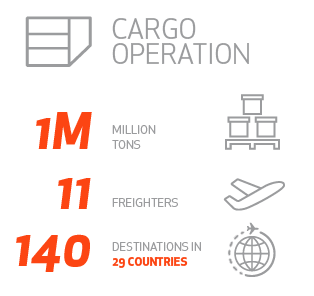

TE PropiedadesPlantas
Our main facilities are located near the Comodoro Arturo Merino BenÃtez International Airport. The complex includes office space, conference space and training facilities dining facilities and mock-up cabins used for crew instruction.
Our corporate offices are located in a more central location in Santiago, Chile.
Our maintenance base is located on a site inside the grounds of the Comodoro Arturo Merino BenÃtez International Airport. This facility contains our aircraft hangar, warehouses, workshops and offices, as well aircraft parking area capable of accommodating up to 30 short-haul aircraft or 10 long-haul aircraft.
We occupy site at the Miami International Airport that has been leased to us by the airport under a concession agreement. Our facilities include corporate building of around 4,450m2, a cargo warehouse (including meter cooling area) of around 35,000m2 and aircraft-parking platform of around 72,000m2, apart from totally equipped offices. In addition, during 2015, LATAM opened the first maintenance hangar of the Company in Miami, with a surface of 6,200m2 for aircraft maintenance and adjacent infrastructure (workshop, stores and offices). The project required a final investment of US$ 16.4 million, fully funded by the Company.

We own a flight-training center on the side of the Comodoro Arturo Merino BenÃtez International Airport. We have also developed a recreational facility for our employees with Airbus’ support. The facility, denominated “Parque LAN,†is located on land that we own near the Comodoro Arturo Merino BenÃtez International Airport.
LAN Peru has approximately 19,000 m2 built. All facilities are leased and are distributed as follows:
Administrative Offices: 7,000 m2
Sales Offices: 2,000 m2
Concessions airports: 10,000 m2
LAN Colombia has approximately 27,500 m2 built. All facilities are leased and are distributed as follows:
Administrative Offices: 4,500 m2
Sales Offices: 1,700 m2
Concessions airports: 21,300 m2
LAN Ecuador has approximately 14,500 m2 built. All facilities are leased and are distributed as follows:
Administrative Offices: 1,600 m2
Sales Offices: 1,000 m2
Concessions airports: 11,900 m2
LAN Argentina has approximately 18,000 m2 built. All facilities are leased and are distributed as follows:
Administrative Offices: 6,600 m2
Sales Offices: 2,600 m2
Concessions airports: 8,700 m2
TAM’s main facilities are located in São Paulo, in hangars within the Congonhas Airport and nearby. At Congonhas Airport, TAM leases hangars belonging to INFRAERO (the Local Administrator Airport): Hangar VII, Hangar VIII, Hangar III. The Service Academy is located about 2.5 km from Congonhas Airport, is a separate property which TAM owns, exclusively for the areas of Selection, Medical Service, Training, and Mock-ups.
At Hangars II and V in Congonhas Airport, which TAM has offices and hangars. This site also houses the areas of Aircraft Maintenance, Procurement and Logistics of Aeronautical Materials.
In São Paulo, TAM has other facilities such as: Commercial Headquarters, Uniform Building, Morumbi Office Tower and a Call Center Building. Besides, in São Paulo, TAM has the offices belonging to the Group as: Multiplus Office, TAM Viagens Office, one store of TAM Viagens and Bahia state. In Guarulhos, TAM has a Passenger Terminal, Operational Areas such as Check-in, Ticket Sales, Check Out, Operations Areas, VIP Lounges, Aircraft Maintenance, GSE, Cargo Terminal, Distribution Centers, etc.

Brasil
With a population of over 200 million people, Brazil is by far the largest domestic market in South America and the third worldwide. In 2015, 98 million passengers flew domestic routes in Brazil. This market is still an opportunity for LATAM, a market with low penetration of air transportation and high growth potential.
2015 was a particularly complex year for passenger transportation in Brazil, because of to the challenging economic scenario, with GDP declining 3,8%, inflation reaching 10.7% (the highest rate since 2002) and depreciation of the currency in relation to the dollar was 49% compared to 2014 (the largest decline in thirteen years).
This recession had a direct impact on the commercial aviation sector, thus impacting particularly the demand of business passengers. The domestic operation of LATAM represents approximately one third of its global passengers business, more than the aggregate of all of its local operations in the Spanish speaking countries where the Company operates.
A key to mitigate the impact of the economic slowdown of the country and especially the weakness of the reais, has been the discipline in the offer of the Company, which has been in place since its entry to Brazil in 2012, in a market who still has overcapacity. Worth is to highlight that during 2015 LATAM was the only company to reduce capacity in the domestic market in Brazil.
In 2015 the Company reduced its offer in 2.5% measured in ASK (seats per kilometer), which followed a reduction of 1.4% in 2014 and 8.4% in 2013. On the other hand, demand decreased 2.6% (measured in RPK), resulting in a healthy load factor of 81.6% for the year –above the average industry level–, representing a 0.1% fall compared to 2014.
It’s expected that the situation in Brazil will continue to pressure the economy in 2016; and right in the middle of a new slowdown of the economy, LATAM announced a reduction of ASK in between 8% to 10%, with the objective of being more efficient in domestic routes, without affecting the connectivity of its passengers.
As of December 2015, TAM served 44 domestic destinations in 46 airports, operating approximately 650 flights daily. With 32 million passengers carried, which represented a decline of 4.0% compared to 2014, the Company maintained its leading position in domestic flights measured in RPK, with 37% market share, followed by the airlines GOL and Azul, with market shares of 36% and 17% respectively, being its main competitors. Additionally, in 2015 TAM remained as the preferred airline in the business passengers segment, reaching a market share of 32% in December 2015.
In order to serve its domestic operations, TAM used a fleet composed by 120 aircrafts from the Airbus A320 family, including the 27 Airbus A321 –9 aircrafts more than 2014– fleet that allows the Company to cover more efficiently the busiest domestic routes.
Additionally, during 2015 the Company continued to focus on maintaining its strategic position in Brazil, improving connectivity from its main hubs, such as the Guarulhos and Brasilia terminals, being the latter the most important for domestic flights in Brazil. In line with the objective of strengthening the hub in Brasilia, TAM opened four new destinations in the country: Bauru, Juazerio Do Norte, São José Dos Campos and Jaguaruna, the latter in connection to Congonhas, seeking to bolster the operations in the most profitable markets and reaching 8% growth in the number of passengers with connections on domestic flights compared to 2014.
Worth is to mention that in this period, and for seventh consecutive year, TAM lead the “Top of Mind†ranking in Brazil, and increased the gap with the second place, thus consolidating its leading position in the Brazilian market, despite the capacity reductions in the domestic network.
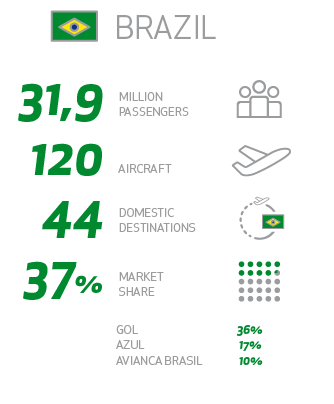

Argentina - Chile
Colombia
Ecuador - Perú
In 2015, LAN Argentina in its 10th year in the country, where the airline has positioned as the second largest operator in domestic flights, where the market is dominated by AerolÃneas Argentinas, the government-owned company, with near 75% market share.
To keep this market position, the Company had been able to maintain its unwavering commitment to provide the highest safety, quality and service standards, which has been showed through the highest satisfaction scores and passengers’ recommendation obtained during the year.
LAN accounted 2.4 million passengers transported in domestic routes, and ended the year with 25% market share, showing a 2.0% decrease over 2014. Its consolidated traffic measured in passenger-kilometers (RPK) grew 4.0%, while the capacity (ASK) increased in the same percentage; these gave a load factor of 76%, which represented a 0.2% increase over the previous year.
In 2015, the Company served 14 domestic destinations, connecting from and to Buenos Aires the following cities: BahÃa Blanca, Bariloche, Comodoro Rivadavia, Córdoba, El Calafate, Iguazú, Mendoza, Neuquén, RÃo Gallegos, Salta, San Juan, Tucumán and Ushuaia.
LAN Argentina used 13 Airbus aircrafts from the A320 family to operate the domestic flights, one more than the previous year, and after the addition of extra equipment of this model to the fleet. The addition of this new aircraft, as well as the perspectives of renovation and fleet growth in the future, is a critical factor to improve the value proposal of the Company, whose priority is to continue the product and service improvement. This aircrafts are considered the most efficient of the industry for this type of operations, and at the same time they have the broader and comfortable passenger cabin of its kind.
In the context of the corporate strategy, which is focused to provide the best travel experience to passengers, in this period LAN added a new service IFE (In-Flight Entertainment) in every airplane, allowing the passenger to have access to movies, music, games and information in their own tablet or laptop.
Along the same line, in 2015 LAN inaugurated two new lines of sales in shopping centers in the city of Avellaneda (province of Buenos Aires) and in Rosario (province of Santa Fe), accounting three island shops and 17 commercial offices in the country as of December 2015.
LAN Argentina operates from Buenos Aires at Ministro Pistarini airport (Ezeiza) and at Aeroparque Jorge Newbery airport, the country’s most important domestic passenger terminal. LAN Argentina has a hangar at this airport, which was inaugurated on November 2009.
 
Accounting 7.2 million passengers transported in Chile in 2015 (Easter Island is not included), similar volume to the previous year, LAN maintained its leadership in the industry, reaching 75% market share and considering that the market didn’t experience any growth of demand and capacity due to de economic slowdown in the country. On domestic routes, the Company competes mainly with SKY Airlines, which as of December 2015 accounted 24.3% market share. Total passengers carried in Chile in the period January-December was nearly 9,7 million, and represented a 0.6% growth when compared to the same period 2014, according to the statistics provided by the Junta Aeronáutica Civil (JAC Chile).
The Company serves 15 domestic destinations (Easter Island is not included), thus covering the main cities in the countries from north to south. The Copa América de Fútbol (America Football Cup) that took place in Chile during June and July, LAN operated 30 extra flights, with 13 reinforcement flights to La Serena and 7 flights to Temuco, in addition to 10 charter flights to the regional airports in Antofagasta, La Serena, Concepción and Temuco.
In this period, the consolidated passenger traffic (RPK) increased 1.3% and capacity (ASK) grew 0.6% (ASK) compared to the previous year, and as a result, the average load factor was a solid 82.8%, representing 0.8% increase over 2014, reaching the highest level in the last five years.
To serve domestic routes, LAN uses a fleet of 27 aircrafts from the Airbus A320 family, one less than the previous year. This was consequence of the incorporation of 6 new Airbus A321, whose capacity is 220 passengers –46 extra passengers per flight–, accounting a total of 7 units of this model by the end of the year. The aircraft Airbus A321 is the largest and most modern plane of the family, whose technology, materials and aerodynamics allows a more efficient operation of domestic flights and a significant reduction of CO2 emissions due to lower fuel consumption, thus contributing for the caring of the environment. For the flights to Easter Island, LAN started this year the operation of this route with the Boeing B787 Dreamliner.
Among the developments of the period, worth is to highlight the opening of the new Vip Lounge at the Santiago airport, being the largest in South America, whose entrance is located near the Preferred Check-in at Arturo Merino BenÃtez airport, right after police control. The new proposal consists on a high-end service, consistent and memorable, and a world-class design.
One of the challenges that the company had to face in the period in Chile, worth is to mention the strike of workers of the Dirección General de Aeronáutica Civil, that took place on September 16 –right before the long weekend of National Holidays–, where LAN and TAM arranged additional flights thus providing more flight alternatives in Chile and also to the international flights starting from or arriving to Santiago. In such way, the Company was able to solve the contingency and also avoid any complication in its operations.
With regards to airport infrastructure, the Santiago airport provided 15 new additional spaces for aircraft parking on a remote platform. In addition, the works of the first phase for the mayor conservation of the main airport runway and the restoration of the ILS CAT III system were finished, which allows the landing of planes under conditions of low visibility (fog). In turn, in the provinces other than Santiago, the improvement works in Calama, Iquique and La Serena were completed.
Additionally, during 2015, the concession for Arturo Merino BenÃtez Airport was awarded to Sociedad Concesionaria Nuevo Pudahuel for a 20-year term. This is an international consortium with large experience worldwide, and responsible for the operations of airports such as Charles de Gaulle and Orly in Paris. The new project considers a capacity increase of 29 million passengers in 2020, as well as investments in distinctive elements such as service and technology.
 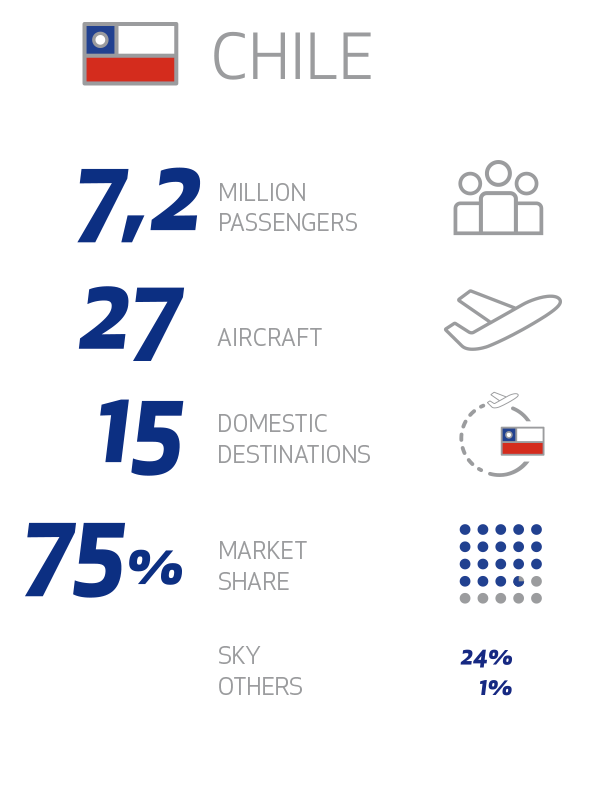
LAN Colombia has operated for four years, and in 2015 the Company transported 4.6 million domestic passengers, 4.0% increase over 2014, thus consolidating its position as the largest operator in the country, accounting a 22% market share, in a market that is considered the most competitive in Latin America. In domestic routes, LAN competes with Avianca (58.0%), Viva Colombia (12.0%), Satena (3.0%), Copa and EasyFly, with 2.0% market share each, among the main ones.
As of December 2015, LAN Colombia flew to 14 cities in the country with 17 routes, and offers broad connectivity alternatives from Bogotá and MedellÃn. The consolidated traffic per passenger (RPK) grew 15% and capacity increased in the same percentage, and as a result occupation load factor remained flat in 79%, similar to the previous period. This happened in a market that also got impacted by de regional economic slowdown.
Among the developments of the period, worth is to mention the inauguration of flights Cali-MedellÃn and MedellÃn-Cartagena, with 13 and 7 weekly frequencies respectively, allowing the Company to continue to deepen its decentralization plan of domestic operation, having a competitive offer to the local market without having to go through Bogotá. Additionally, during 2015 LAN Colombia strengthened its local service with the growth of seven weekly frequencies for the route Bogotá-Cúcuta, thus doubling the flights per week. Likewise, the Company increased the offer for the route MedellÃn-San Andrés, reaching four weekly frequencies, therefore leveraging one of the touristic destinations more demanded in the country.
In order to develop its domestic short-haul operations, the Company ended the year with 15 Airbus aircrafts from the A320 family, with capacity for 174 passengers, and these airplanes are used also to serve the flights to Aruba, Cancún and Punta Cana in El Caribe. Client-facing, in August LAN Colombia launched its onboard wireless entertainment system “LAN Entertainment†in every airplane of its fleet A320, and this technology innovation allows it to offer a much competitive onboard service offer and also differentiate from the domestic airlines, thus allowing passengers to have access to movies, series and news, among others, from their own portable devises.
Worth is to highlight that in the second half of the year, the Company completed the total refund of the last Dash 8-200 equipment of the fleet (turboprop airplanes inherited from the former Aires, with capacity for 37 passengers and with an average age of 17 years), which operated in the cities of Neiva and Villavicencio, thus complying with the fleet renovation plan started in 2012.
With regards to service standards, one of the highlights of the year is the consolidation of LAN Colombia –for the third year in a row– as the country’s most punctual airline in domestic routes, with 95.2% of compliance, according to the latest report of the airlines compliance report issued by the Colombian aviation authority as of September 2015. This acknowledgement is due to the big effort carried out by the Company to continue encouraging the punctuality culture, investing in training, technology and modern fleet. LAN Colombia considers punctuality as an attribute that differentiates the airline when facing the client.
Among other initiatives created to enhance the value proposal for passengers, the launch of the program “LAN Events and Conventions†stands out, whose purpose is to offer to every company in the country an alternative to make business activities in different cities. Since its launch until December, 50 companies signed the program, with more than 1,700 passengers carried.
 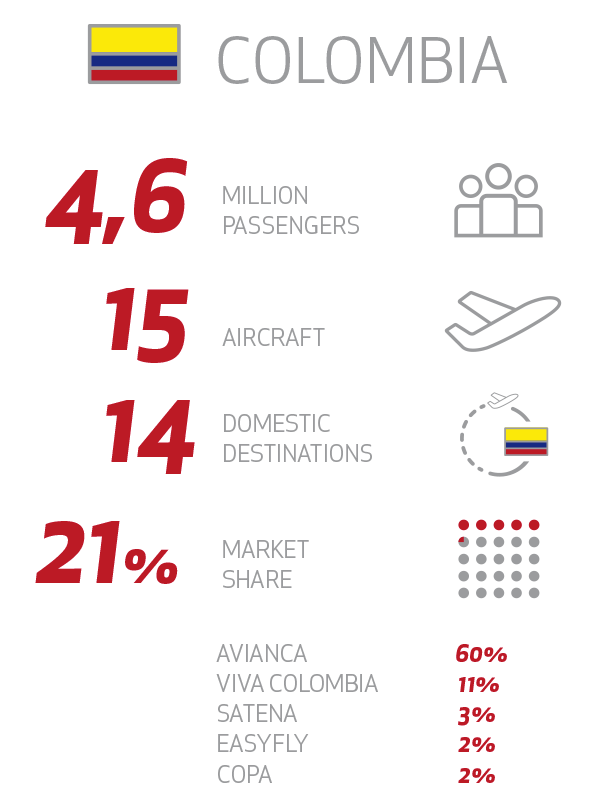
LAN Ecuador started up its domestic operations in 2009 and ever since has gradually positioned as a relevant operator in domestic routes. This has been possible due to the Company’s constant efforts to offer passengers the best value proposal in terms of safety, reliability and service.
The Company serves five destinations through the Quito-Guayaquil and Quito-Cuenca routes and the Quito/Guayaquil route to the San Cristóbal and Baltra Islands in the Galápagos, offering connectivity that seeks to promote tourism and the country’s economic development. In this direction, LAN Ecuador announced that starting from January 2016, it would operate a new direct flight in the Quito-Baltra route.
During 2015, the flight operations developed in a difficult economic scenario, just as most of the countries in the region. Ecuador is a small market, with approximately 16 million customers, whose economy was severely impacted by the sharp decline of oil prices -being the main export commodity – and also was impacted by the appreciation of the dollar, official currency in Ecuador since 2000.
In addition to the above, the reactivation of the Cotopaxi Vulcano’s activity, whose ashes impacted the operations of the Guayaquil-Quito and Quito-Cuenca routes from the second week of August until the end of November. In this context, the Company managed together with the Dirección General de Aviación Civil del Ecuador (DGAC) and the Fuerza Aérea Ecuatoriana the creation of an alternative route in a military area, in order to avoid the cloud of ashes that remained in the commercial flight route.
LAN Ecuador carried 1.1 million passengers on domestic routes, showing a 1.0% increase over 2014, and maintained its position as the second largest domestic operator in the country, with 33% market share, 2.2% higher than in the previous year. Its main competitors are the local airlines Tame, which holds 43% market share, and Avianca, with 25% market share.
The cancellation in January of the operation of Avianca in the Quito-Cuenca route, had a positive impact on LAN, thus increasing its market share in 11% for this route and the average rate grew 27%. For its part, Tame reduced its offer for the Guayaquil-Quito route since May, which prompted a 12% fall of the total seats capacity when compared to the previous year. Nonetheless, this didn’t generate a huge impact in market share, allowing LAN to increase load factor by 1.7% when compared to 2014, reaching 74.9%.
During 2015, LAN Ecuador’s consolidated passenger traffic grew 7.0%, measured in terms of RPK, while capacity measured in terms of ASK increased 8.0%. As a result, the average load factor reached 81.2%, falling 0.5% when compared to 2014.
In order to serve domestic routes, LAN Ecuador holds a fleet of three Airbus A319 airplanes, with no variation with respect to the previous year. These are airplanes have lower capacity in relation to the A320, which allows the Company to adapt to the market’s demand.

Taking into account the slowdown of Latin American economies in 2015, Peru stands out among the economies that showed better performance during the year, accounting a GDP growth of 3.3%.
During 2015, the airline industry accounted 11.3% growth in terms of domestic passengers transported in Peru compared to the previous year, with over 9.9 million people carried. LAN Peru remained as the main operator in these routes, accounting 6.2 million passengers carried in 2015, a 9.9% increase over the previous year. The consolidated passenger traffic (RPK) of the Company grew 8.3% and capacity (ASK) increased 8.0%. Likewise, the load factor was 81.6%, over the industry average, with 0.2% growth over the previous year.
LAN Peru flights to 16 destinations in the country –reaching up to 110 flights per day–, thus offering the best connectivity of the industry, with the greater variety of destinations and frequencies and with a clear approach to provide the best service to its clients. This has contributed to the consolidation of LAN Peru as the leader in the domestic market, reaching a market share of 62.1% in the passenger segment. Its main competitors are Peruvian Airlines, Avianca, Star Peru and LC, which in this period obtained market shares of 13.1%, 12.7%, 6.0% and 4.8% respectively.
The domestic operations use a fleet of 17 aircrafts, one less than in 2014, and comprises nine Airbus A319 aircrafts and eight Airbus A320 aircrafts.
Among the major milestones of the year, worth is to highlight the recognition obtained by LAN Peru as the “Most Admired Company in Peruâ€, award granted by the ranking made by the international consultant PwC Peru and Revista G de Gestión. This acknowledgement is granted to those companies that stand out for its strategic vision, financial management, innovation capacity, commercial strategy, senior management quality, good corporate governance practices and corporate social responsibility initiatives. The nomination of the 10 awarded companies was the product of a survey made to 4,500 executives from the 1,500 largest companies in Peru in terms of billings.
Likewise, for the second year in a row, LAN Peru was awarded with the first place in the MERCO 2015 ranking, in the air transportation category, ranking also in the 11thposition of the general ranking of companies, an improvement compared to the place number 27 of 2014.
Additionally, LAN Peru was awarded with the Corporate Creativity Award, granted by Universidad Peruana de Ciencias Aplicadas (UPC), in the categories Tourism & Entertainment and Technology & Computing, for the project “Night Flights to Cusco†with RNP (Required Navigation Performance) technology, which has satellite navigation. The RNP system present in the Lima-Cusco route (starting from September 2013) represents a successful example of the revenue generation practices carried out by the Company. This technology uses avionics advanced capacity (discipline that studies the electronic techniques applied to air navigation) and supported by a satellite guide, allowing more accurate flights and to operate safely in low visibility conditions, avoiding delays and flight cancellations. In addition to this, the flight time reduction is 6.3 minutes, due to the route reduction of 35 nautical miles. All these advantages are translated in lower fuel consumption –with savings of 67.5 gallons– and a reduction of 644 kilos of CO2 per flight. Furthermore, the implementation of aero satellite navigation technology to this route allowed the expansion of the Cusco Airport working hours to night hours, thus increasing revenues for the Company.
Finally, during the year LAN Peru continued making progress in its objective of being a socially responsible company. In this sense, worth is to mention that LAN Peru was able to compensate, for the fourth year in a row, its carbon footprint of land operations and workers’ activities, equivalent to 6,500 tons of CO2, plus a total of 25,390 tons compensated in 2015.
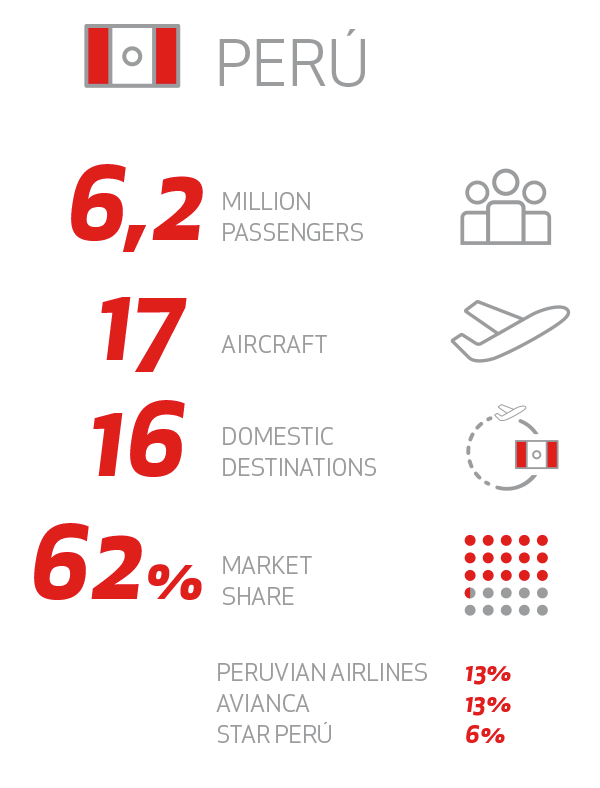
TE ProgramasFidelidad
LAN and TAM operate their own “loyalty programsâ€â€“LANPASS and TAM Fidelidade, respectively– whose objective is to recognize the loyalty of frequent flyer passengers and reward them with different benefits and awards. During 2015 the plans for these airlines was to continue operating independently, nonetheless the Company continued working in order to standardize the two programs in line with the process of homogenization facing the customer, to whom LATAM is committed across all areas of its operations.
At the moment, passengers registered on each program may earn and redeem kilometers or points on any flight in the network administered by the two airlines and their associated airlines. Likewise, the other program already recognizes top tier members of each program so, for example, LANPASS members can obtain upgrades on TAM flights and members of TAM Fidelidade on LAN flights. In addition, both may have access to the same airport services, such as preferred check-in, among other benefits.

LANPASS is the frequent flyer program created by LAN in 1984. Members of the program earn kilometers every time they fly with LAN, TAM or any other other airline member of oneworld, as well as when shopping with or using the services of companies around the world which have an agreement with LANPASS. Members of the program can exchange LANPASS kilometers for free tickets as well as different products from the program’s catalogue or other options such as gift cards from certain retail stores, among others. The program includes four “elite” categories: Premium, Premium Silver, Comodoro and Black. These categories have their equivalents in this alliance where Ruby corresponds to the Premium category, Sapphire to Premium Silver and Emerald to Comodoro and Black.
As of December 2015 LANPASS had 10.9 million members, a 13% growth over 2014, mainly distributed in Chile, Peru, Argentina, Colombia, Ecuador and the United States.
For its part, the frequent flyer program of TAM was created in 1993, with the purpose to reward those passengers who fly regularly with the airline, through different benefits and exclusive offers. In this case, members earn points each time they fly with TAM, LAN or any other airline that belongs to the oneworld alliance. As of December 2015, TAM Fidelidade had 12.8 million members, all of them in Brazil, reaching 8,0% growth over 2014. The program includes four Elite categories – Azul, Vermelho, Vermelho Plus and Black – which now have their equivalent categories in the oneworld alliance – Ruby for Azul, Sapphire for Vermelho and Emerald for Vermelho Plus and Black – giving members access to more benefits, including that of priority on the waiting list of any airline in the oneworld alliance.
TAM Fidelidade is administrated by Multiplus, a company listed on the Sao Paulo stock exchange in which LATAM Airlines Group is the main shareholder with a 73% stake. Multiplus is Brazil’s largest and best loyalty network and allows members to accumulate Multiplus points in a single account at more than 13.000 stores affiliated to the program, and allows to exchange their points in over 550.000 different products and services. As of December 2015 the Multiplus network comprised over 465 partners and nearly 13.0 million members.
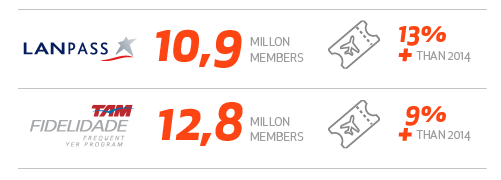
By mid-2015, TAM and Multiplus modified the points exchange program, which was in place for approximately 10 years; with the purpose of improving the long-term relationship of both companies. The new contract considers a 3% reduction for each 10,000 points exchanged in TAM tickets, and also modified the exchange system, from a fixed rate by seat to a dynamic prices formula related to the type of seat.
Among the achievements of the period, we highlight the implementation of the “Fly Higher†campaign, both in LAN and TAM, whose purpose is to rewards the passengers’ preference with additional benefits. Among these benefits, the access to free preferred seats in Economy class domestic flights, extra bonuses for the kilometers/ points accrued for Business class flights and access to the best network of VIP lounges in South America with a guest.
Moreover, the qualification rules for the four Elite categories were reduced in most of the countries where the Company operates. For instance, in the past a member needed 150,000 LANPASS KILOMETERS to become Comodoro partner in Chile, now the requirement is 140,000 kilometers.
Â

TE EntornoIndustria
During 2015, the global airline industry was challenged by different macroeconomic factors. Among the positive factors we can highlight the sharp fall of fuel prices to an average of US$52.3/ barrel, a 47% drop compared to 2014. Among the negative factors, the strong depreciation of local currencies against the dollar stands out, in addition to the lower growth of the main economies of the region, specially Brazil.
In general, 2015 was a good year for the industry, which was reflected in the 6,5% increase in passengers’ traffic, above the average for the last ten years and with increases in demand in every region worldwide, where the growth of Middle East, Asia Pacific and Latin America stands out, thus prompting a substantial improvement of the operational result and the profits of the global industry, which are estimated to be US$33.0 billion (US$17.3 billion in 2014).
At a domestic and regional level, the trend towards the low-cost model is still in place, which has shown a significant expansion, and greater passengers’ segmentation according to their travel needs.
 Additionally, the trend towards the strengthening of alliances and cooperation agreements among the world’s airlines continues, being a key factor the better performance of these alliances lately, thus improving connectivity for passengers.
Additionally, the trend towards the strengthening of alliances and cooperation agreements among the world’s airlines continues, being a key factor the better performance of these alliances lately, thus improving connectivity for passengers.
With regards to the different geographic markets, the North American airlines had an outstanding year in terms of profits, mainly explained by low fuel costs, and the strong domestic demand, partially compensated by lower revenues resulting from the strength of the dollar in relation to other currencies. Additionally, we observe a less fragmented and more disciplined industry, with better labor relations and supported by the creation of increased ancillary revenues.
In Europe, the growth of traffic was driven by the recovery of consumer spending in the Eurozone, in addition to the slight growth of the frequencies within the region. Despite that the economic environment improved from the previous years, challenges remained, mainly caused by the strike of Lufhtansa and Air France-KLM employees after their efforts to restructure its operations towards a low cost model, looking forward to compete with the increasingly popular Ryanair and EasyJet, besides the closing of operations of the Russian airline Transaereo.
In the Asia-Pacific region, operators showed the second fastest growth within regions, prompted by an increase in the number of airports with direct connections within the region, which stimulated passengers’ demand, and therefore decreased waiting times for customers, partly offsetting the lower economic growth of the region.
In Latin America, the economic slowdown and the strong depreciation of local currencies pressured unit revenues of operators in 2015. Particularly Brazil, country that represents approximately 50% of the traffic in the region, experienced a strong economic slowdown, thus impacting the business passengers’ demand, where capacity discipline was a key factor to reach healthy load factors. Despite the latter, international passengers traffic within the region still shows solid growth rates (9.3%), while domestic markets traffic were weaker, mainly in Brazil.
 Regarding the cargo business, traffic showed a slight slowdown on its growth rate, growth reached 2.2% in 2015 compared to the 4.5% expansion achieved in 2014. Growth in this period was driven by the Middle East (+11.3%), while cargo in Latin America (-6,0%) remained weak mainly due to lower imports from Brazil. In addition, the lower growth of the Asian markets explains in large part the weakening of the cargo business worldwide.
Regarding the cargo business, traffic showed a slight slowdown on its growth rate, growth reached 2.2% in 2015 compared to the 4.5% expansion achieved in 2014. Growth in this period was driven by the Middle East (+11.3%), while cargo in Latin America (-6,0%) remained weak mainly due to lower imports from Brazil. In addition, the lower growth of the Asian markets explains in large part the weakening of the cargo business worldwide.
One of the main issues of 2015 was the drop in fuel prices. The average price of jet fuel was US$52.3/ barrel in 2015. The impact of this drop, although positive for the airline industry as a whole, had a different impact by region depending on the strength/ weakness of their economies and currencies, and also on the level of competition. In some cases, hedging also meant that much of the benefit of lower fuel prices was not captured. In 2016, fuel prices are expected to remain low, benefiting airlines.
Given the industry’s current structure and the fuel price outlook, the International Air Transport Association (IATA) expects an increase in global returns in 2016, with the industry’s profits reaching US$36,3 billion and operating margin of 5.1%, being a record result for the industry. This growth is partly driven by the lower fuel average price forecasted for 2016, as well as the efficiencies improvements achieved by the industry in general.  It’s worth to highlight that the growth drivers for global traffic in 2016 will continue to be the emerging economies, mainly Asia-Pacific, Middle East and Latin America. Due to their economic growth outlook and the still low penetration of air travel in these countries, this trend is expected to persist over the next 20 years.

TE Marco Regulatorio
Both the DGAC and the JAC oversee and regulate the Chilean aviation industry. The DGAC reports directly to the Chilean Air Force and is responsible for supervising compliance with Chilean laws and regulations relating to air navigation. The JAC is the Chilean civil aviation authority.
Primarily on the basis of Decree Law No. 2,564, which regulates commercial aviation, the JAC establishes the main commercial policies for the aviation industry in Chile, regulates the assignment of international routes, and the compliance with certain insurance requirements, and the DGAC regulates flight operations, including personnel, aircraft and security standards, air traffic control and airport management.
We have obtained and maintain the necessary authority from the Chilean government to conduct flight operations, including authorization certificates from the JAC and technical operative certificates from the DGAC, the continuation of which is subject to the ongoing compliance with applicable statutes, rules and regulations pertaining to the airline industry, including any rules and regulations that may be adopted in the future.
Chile is a contracting state, as well as a permanent member, of the ICAO, an agency of the United Nations established in 1947 to assist in the planning and development of international air transport.
The ICAO establishes technical standards for the international aviation industry, which Chilean authorities have incorporated into Chilean laws and regulations.
In the absence of an applicable Chilean regulation concerning safety or maintenance, the DGAC has incorporated by reference the majority of the ICAO’s technical standards. We believe that we are in material compliance with all relevant technical standards.

International route rights, as well as the corresponding landing rights, are derived from a variety of air transport agreements negotiated between Chile and foreign governments. Under such agreements, the government of one country grants the government of another country the right to designate one or more of its domestic airlines to operate scheduled services to certain destinations of the former and, in certain cases, to further connect to third-country destinations.
In Chile, when additional route frequencies to and from foreign cities become available, any eligible airline may apply to obtain them. If there is more than one applicant for a route frequency the JAC awards it through a public auction for a period of five years. The JAC grants route frequencies subject to the condition that the recipient airline operate them on a permanent basis. If an airline fails to operate a route for a period of six months or more, the JAC may terminate its rights to that route. International route frequencies are freely transferable. In the past, we have generally paid only nominal amounts for international route frequencies obtained in uncontested auctions.
Chilean airlines are permitted to establish their own domestic and international fares without government regulation. For more information, see “—Antitrust Regulation†below.
In 1997, the Antitrust Commission approved and imposed a specific self-regulatory fare plan for our domestic operations in Chile consistent with the Antitrust Commission’s directive to maintain a competitive environment.
According to this plan, we must file notice with the JAC of any increase or decrease in standard fares on routes deemed “non-competitive†by the JAC and any decrease in fares on “competitive†routes at least twenty days in advance. We must file notice with the JAC of any increase in fares on “competitive†routes at least ten days in advance.
In addition, the Chilean authorities now require that we justify any modification that we make to our fares on non-competitive routes. We must also ensure that our average yields on a non-competitive route are not higher than those on competitive routes of similar distance.
Aircraft registration in Chile is governed by the Chilean Aeronautical Code (“CACâ€). In order to register or continue to be registered in Chile, an aircraft must be wholly owned by either:

The DGAC requires that all aircraft operated by Chilean airlines be registered either with the DGAC or with an equivalent supervisory body in a country other than Chile. All aircraft must have a valid certificate of airworthiness issued by either the DGAC or an equivalent non-Chilean supervisory entity. In addition, the DGAC will not issue maintenance permits to a Chilean airline until the DGAC has assessed the airline’s maintenance capabilities.
The DGAC renews maintenance permits annually, and has approved our maintenance operations. Only DGAC-certified maintenance facilities or facilities certified by an equivalent non-Chilean supervisory body in the country where the aircraft is registered may maintain and repair the aircraft operated by Chilean airlines.
Aircraft maintenance personnel at such facilities must also be certified either by the DGAC or an equivalent non-Chilean supervisory body before assuming any aircraft maintenance positions.
The DGAC establishes and supervises the implementation of security standards and regulations for the Chilean commercial aviation industry.
Such standards and regulations are based on standards developed by international commercial aviation organizations. Each airline and airport in Chile must submit an aviation security handbook to the DGAC describing its security procedures for the day-to-day operations of commercial aviation and procedures for staff security training. LAN has submitted its aviation security handbook to the DGAC. Chilean airlines that operate international routes must also adopt security measures in accordance with the requirements of applicable bilateral international agreements.
The DGAC supervises and manages airports in Chile, including the supervision of take-off and landing charges. The DGAC proposes airport charges, which are approved by the JAC and are the same at all airports.
Since the mid-90s, a number of Chilean airports have been privatized, including the Comodoro Arturo Merino BenÃtez International Airport in Santiago. At the privatized airports, the airport administration manages the facilities under the supervision of the DGAC and JAC.

There are no material environmental regulations or controls imposed upon airlines, applicable to aircraft, or that otherwise affect us in Chile, except for environmental laws and regulations of general applicability. There is no noise restriction regulation currently applicable to aircraft in Chile. However, Chilean authorities are planning to pass a noise-related regulation governing aircraft that fly to and within Chile.
The proposed regulation will require all such aircraft to comply with certain noise restrictions, referred to in the market as Stage 3 standards.
LAN’s fleet already complies with the proposed restrictions so we do not believe that enactment of the proposed standards would impose a material burden on us.
The Chilean antitrust authority, which we refer to as the Antitrust Court (previously the Antitrust Commission), oversees antitrust matters, which are governed by Decree Law No. 211 of 1973, as amended, or the Antitrust Law.
The Antitrust Law prohibits any entity from preventing, restricting or distorting competition in any market or any part of any market. The Antitrust Law also prohibits any business or businesses that have a dominant position in any market or a substantial part of any market from abusing that dominant position.
An aggrieved person may sue for damages arising from a breach of Antitrust Law and/or file a complaint with the Antitrust Court requesting an order to enjoin the violation of the Antitrust Law.
The Antitrust Court has the authority to impose a variety of sanctions for violations of the Antitrust Law, including termination of contracts contrary to the Antitrust Law, dissolution of a company and imposition of fines and daily penalties on businesses. Courts may award damages and other remedies (such as an injunction) in appropriate circumstances. As described above under “—Route Rights—Airfare Pricing Policy,†in October 1997, the Antitrust Court approved a specific self-regulatory fare plan for us consistent with the Antitrust Court’s directive to maintain a competitive environment within the domestic market.
Since October 1997, LAN Airlines S.A. and LAN Express follow a self-regulatory plan, which was modified and approved by the Tribunal de la Libre Competencia (the Competition Court) in July 2005, and further in September, 2011.
In February 2010, the FiscalÃa Nacional Económica (the National Economic Prosecutor’s Office) finalized the investigation initiated in 2007 regarding our compliance with this self-regulatory plan and no further observations were made.
By means of Resolution No. 37/2011, issued on September 21, 2011 (the “Resolutionâ€), the Tribunal de Defensa de la Libre Competencia de Chile (“TDLCâ€) approved the merger between LAN and TAM and imposed 14 mitigation measures on LATAM, which scope and details are set out in said Resolution and which, for convenience only, are briefly described below:
The Brazilian Council for Economic Defense – CADE has approved the LAN/TAM merger by unanimous decision during the hearing session of December 14, 2011, subject to the conditions: (1) the new combined group (LATAM) should leave one of the two global alliances to which it was part (Star Alliance or oneworld); and (2) the new combined group (LATAM) should offer to swap two pairs of slots in Guarulhos International Airport, to be used by an occasional third party interested in offering direct non-stop flights between São Paulo and Santiago do Chile. These impositions are in line with the mitigation measures adopted by the TDLC, in Chile.
Furthermore, the association was submitted to the antitrust authorities in Germany, Italy and Spain. All these jurisdictions granted unconditional clearances for this transaction. The merger was filed with the Argentinean antitrust authorities, which approval is still pending.

TE ResultadosFinancieros
LATAM Airlines Group accounted an operating income of US$ 513.9 million in 2015, representing a 0.1% increase over 2014. Operating margin reached 5.1%, increasing 1.0% compared to the previous year. The results improvement of LATAM is mainly explained by lower operational costs due to lower fuel prices, and also due to the constant efforts made by the Company with regards to costs control, and also due to the effect of the devaluation of local currencies in the region.
Total revenues in 2015 reached US$ 10,125.8 million, compared to US$ 12,471.1 million in 2014. The 18.8% fall is explained by the 19.0% decrease in passengers’ revenues and the 22.4% fall in cargo revenues, which was partially compensated by a 2.2% increase in other revenues. The drop in revenues resulted from the complex macroeconomic scenario in South America and the important currencies devaluation in Latin America during the period, especially the 42% depreciation of the Brazilian reais. In 2015, passengers and cargo revenues represented 83.1% and 13.1% of total operational revenues, respectively.
The 19.0% decrease in passengers’ revenues in the year reflected the 3.1% increase in offer, which was offset by the 20.5% reduction in consolidated revenues per passenger (RASK), compared to 2014. This fall resulted from the 21.4% decrease in yields and a slight reduction of 0.3% in load factor, reaching 83.0%. The weak economic scenario in South America and the devaluation of local currencies, mainly the Brazilian reais, is still impacting yields performance.
The growth of capacity of 3.1% during 2015 was mainly explained by the 6.4% growth of the international business capacity, whose strategy was focused on the strengthening of LATAM’s international hubs and the routes to the Caribbean, which was compensated by the reduction in less demanded such as the operations between Brazil and the United States.  Capacity in the Spanish-speaking domestic markets grew 4.8%, and was mainly driven by the Colombian and Peruvian markets. Regarding domestic operations in Brazil, with the ongoing discipline in capacity of domestic flights, the Company reduced the offer for the fourth consecutive year, thus ended up the year with 2.5% lower capacity than 2014, leading the capacity reductions in the country.
Cargo revenues decreased 22.4% during 2015, resulting from the 12.0% drop in cargo traffic, and the 11.8% fall in yields. During the year, the cargo services demand was still weak, especially in the local market and also in the international market of Brazil, as a result of the slowdown of economic activity in the country, which directly impacted imports. Likewise, the oversupply of the airline industry resulted from the increasing competition of regional and international airlines in South America. The latter, together with the substantial drop in fuel prices, largely explains the drop in yields of cargo business.
In 2015 operational costs reached US$ 9,611.9 million, 19.6% decrease from 2014, prompting a 20.1% reduction of the cost per ASK equivalent (including net financial costs). Cost reduction is mainly explained by the 47,1% drop in fuel prices, and also an outcome of the cost reduction program prompted by the Company, in addition to the positive effect of the currency devaluation over costs denominated in local currencies.
Fuel expenditure decreased 36.4% reaching US$2,651.1 million, compared to US$4,167.0 million in 2014. This drop in explained by the fall of fuel prices, as well as the 1.2% decrease in fuel consumption per ASK-equivalent, as a result of the fuel efficiency programs and also due to an increasingly efficient fleet.
Additionally, the Company recognized in 2015 a hedging loss of US$239.4 million compared to the hedging loss of US$108.7 million in 2014. With regards to exchange rate hedging, the Company reported a gain of US$19.2 million on currency hedging in 2015 compared to a gain of US$3.8 million in 2014.
Wages and benefits decreased 11.8% in 2015, mainly due to the impact of local currency depreciation over wages, especially the 41.7% depreciation of the Brazilian reais, and 14.7% depreciation of the Chilean peso compared to 2014. Additionally, during the fourth quarter of the year, LATAM reported a US$37 million reversal of performance bonuses for the year. With regards to the non-operating income, the Company accounted a non-cash exchange rate difference of US$467.9 million, mainly explained by the devaluation of the Brazilian reais during the year.
At the end of the year, LATAM reported a net loss of US$ 219.3 million, compared to a net loss of US$ 109.8 million in 2014. This result implied a negative net margin of 2.2%, thus representing a 1.3% fall over 2014.
| For the 12 months period ended December 31 | 2015 | 2014 | Var.( %) |
|---|---|---|---|
| EBITDAR Margin | 19.5% | 16.2% | 3.2 pp. |
| REVENUE | |||
| Passenger | 8.410.614 | 10.380.122 | -19.0% |
| Cargo | 1.329.431 | 1.713.379 | -22.4% |
| Other | 385.781 | 377.645 | 2.2% |
| TOTAL OPERATING REVENUE | 10.125.826 | 12.471.146 | -18.8% |
| EXPENSES | |||
| Wages and Benefits | -2.072.805 | -2.350.102 | -11.8% |
| Aircraft Fuel | -2.651.067 | -4.167.030 | -36.4% |
| Comissions to agents | -302.774 | -365.508 | -17.2% |
| Depreciation and Amortization | -934.406 | -991.264 | -5.7% |
| Other Rental and Landing Fees | -1.109.826 | -1.327.238 | -16.4% |
| Passenger Services | -295.439 | -300.325 | -1.6% |
| Aircraft Rentals | -525.134 | -521.384 | 0.7% |
| Aircraft Maintenance | -437.235 | -452.731 | -3.4% |
| Other Operating Expenses | -1.283.221 | -1.482.198 | -13.4% |
| TOTAL OPERATING EXPENSES | -9.611.907 | -11.957.780 | -19.6% |
| OPERATING INCOME | 513.919 | 513.366 | 0.1% |
| Operating Margin | 5.1% | 4.1% | 1.0 pp |
| Interest Income | 75.080 | 90.500 | -17.0% |
| Interest Expense | -413.357 | -430.034 | -3.9% |
| Other Income (Expense) | -532.757 | -108.599 | 390.6% |
| INCOME BEFORE TAXES AND MINORITY INTEREST | -357.115 | 65.233 | -647.4% |
| Income Taxes | 178.383 | -142.194 | -225.5% |
| INCOME BEFORE MINORITY INTEREST | -178.732 | -76.961 | 132.2% |
| Attributable to: | |||
| Shareholders | -219.274 | -109.790 | 99.7% |
| Minority Interest | 40.452 | 32.829 | 23.2% |
| NET INCOME | -219.274 | -109.790 | 99.7% |
| Net Margin | -2.2% | -0.9% | -1.3 pp |
| Effective Tax Rate | 44.9% | 438.8% | -394.0 pp |
| EBITDA | 1.448.325 | 1.504.630 | -3.7% |
| EBITDA Margin | 14.3% | 12.1% | 2.2 pp. |
| EBITDAR | 1.973.459 | 2.026.014 | -2.6% |
| For the year ended on december 31 | 2015 | 2014 | Var. (%) |
|---|---|---|---|
| System | |||
| ASKs-equivalent (millions) | 208.857 | 206.198 | 1,3% |
| RPKs-equivalent (millions) | 151.478 | 153.978 | -1,6% |
| Overall Load Factor (based on ASK-equivalent)% | 72,5% | 74,7% | -2,1 pp |
| Break-Even Load Factor (based on ASK-equivalent)% | 73,9% | 70,6% | 3,3 pp |
| Yield based on RPK-equiv (US Cent) | 6,4 | 7,9 | -18,1% |
| Operating Revenues per ASK-equiv (US Cent) | 4,7 | 5,9 | -20,5% |
| Costs per ASK-equivalent (US Cent) | 4,8 | 6,1 | -20,1% |
| Costs per ASK-equivalent ex fuel (US Cents) | 3,6 | 4,0 | -11,5% |
| Fuel Gallons Consumed (millions) | 1.221 | 1.220 | 0,1% |
| Fuel Gallons Consumed per 1,000 ASKs-equivalent | 6 | 6 | -1,2% |
| Average Trip Length (thousands km) | 1,6 | 1,6 | 2,7% |
| Total Number of Employees (average) | 52.697 | 53.300 | -1,1% |
| Total Number of Employees (end of the period) | 51.658 | 53.072 | -2,7% |
| Passenger | |||
| ASKs (millions) | 134.302 | 130.201 | 3,1% |
| RPKs (millions) | 111.510 | 108.534 | 2,7% |
| Passengers Transported (thousands) | 67.835 | 67.833 | 0,0% |
| Load Factor (based on ASKs) % | 83,0% | 83,4% | -0,3 pp |
| Yield based on RPKs (US Cents) | 7,5 | 9,6 | -21,1% |
| Revenues per ASK (US cents) | 6,3 | 8,0 | -21,4% |
| Cargo |
|||
| ATKs (millions) | 7.083 | 7.220 | -1,9% |
| RTKs (millions) | 3,797 | 4,317 | -12.0% |
| Tons Transported (thousands) | 1.009 | 1.102 | -8,5% |
| Load Factor (based on ATKs) % | 53,6% | 59,8% | -6,2 pp |
| Yield based on RTKs (US Cents) | 35,0 | 39,7 | -11,8% |
| Revenues per ATK (US Cents) | 18,8 | 23,7 | -20,9% |
| 2015 | 2014 | % Change | |
|---|---|---|---|
| Perú | 681,340 | 660,057 | 3.2% |
| Argentina | 979,324 | 813,472 | 20.4% |
| EEUU | 1,025,475 | 1,224,264 | -16.2% |
| Europa | 723,062 | 935,893 | -22.7% |
| Colombia | 353,007 | 391,678 | -9.9% |
| Brasil | 3,464,297 | 5,361,594 | -35.4% |
| Ecuador | 238,500 | 248,585 | -4.1% |
| Chile | 1,575,519 | 1,589,202 | -0.9% |
| Pacif Asia and rest of Latin America | 699,521 | 868,756 | -19.5% |
| Operating revenues | 9,740,045 | 12,093,501 | -19.5% |
| Other operating revenues | 385,781 | 377,645 | 2.2% |

TE PremiosReconocimientos
The companies that belong to the LATAM Airlines Group received nearly 25 recognitions in different areas: Services, Sustainability and Onboard Entertainment, among others. Below we highlight the most important recognitions that LATAM Airlines Group received during 2015:
World Line Airline Awards- Skytrax 2015:
The most prestigious award of the industry.
Dow Jones Sustainability Index 2014:
Folio: Eddie & Ozzie Awards 2015:
One of the main awards of the print and digital magazines industry globally.
Structured Financing of the Year –Latin Finance Magazine

TE HechosEsenciales
As provided in Sections 9 and 10 of the Securities Markets Act and in General Rule #30, under due authorization, I hereby inform as MATERIAL DISCLOSURE of LATAM Airlines Group S.A., Securities Registration #306 (“ LATAM â€), the following:
After an extensive integration process following the association of LAN and TAM—during which the Group made great advances in achieving synergies for internal processes, network optimization, and fleet restructuring and modernization, the Board of Directors of LATAM Airlines Group has decided to adopt a single name and identity and announces that the new brand for the largest airline group in Latin America and its affiliates will be LATAM .
The brand LATAM, which is the result of the consolidation of LAN and TAM, will unite all the passenger and cargo airlines for LATAM Airlines Group: LAN Airlines and its affiliates in Peru, Argentina, Colombia and Ecuador; in addition to TAM Linhas Aéreas S.A., and its subsidiary TAM Air Transport Mercosur S.A. (TAM Airlines (Paraguay), and the cargo carriers comprised of LAN CARGO, LAN CARGO Colombia, ABSA (TAM Cargo) and Mas Air.
LATAM Airlines Group is currently working on the new corporate brand, a process that will take approximately three years to complete and will begin to be visible in the first half of 2016 with a gradual roll-out for airports, aircraft, commercial offices, web pages, and uniforms.
As provided in Articles 9 and 10 of the Securities Market Law and in General Rule #30, under due authorization, please be advised as MATERIAL DISCLOSURE that on this date LATAM Airlines Group S.A., Securities Registration #306 (“ LATAM â€), has issued and placed in international markets, pursuant to the Rule 144-A and Regulation S of the securities regulations of the United States of America, senior unsecured notes in the principle amount of US$500.000.000, due in 2020, at an annual initial interest rate of 7,25% (the “ 144-A Bond †or the “ Issuance â€); and
As informed under Material Disclosure of May 20, 2015 and June 5, 2015, the Issuance and placement of the 144-A Bond will have the purpose of (i) financing the repurchase of the senior guaranteed bonds due in 2020, issued by TAM Capital 2 Inc., pursuant to Rule 144-A and Regulation S of the securities regulations of the United States of America (“ TAM 2020 Bond â€); and (ii) with any remaining funds, to finance other corporate general matters.
Finally, please find enclosed the form regarding Regulation 1.072 of the Chilean Securities and Insurance Commission.
As provided in Articles 9 and 10 of the Securities Market Law and in General Rule #30, under due authorization, please be advised of the following MATERIAL DISCLOSURE:
As informed under Material Disclosure of May 20, 2015, LATAM Airlines Group S.A. (“LATAM) on June 4th, 2015, has agreed to issue and place in the international markets, pursuant to the Rule 144-A and Regulation S of the securities regulations of the United States of America, senior unsecured notes in the principle amount of US$500.000.000, due in 2020, at an annual initial interest rate of 7,25% (the “ 144-A Bond †or the “ Issuance â€); and
As also informed under Material Disclosure of May 20, 2015, the Issuance and placement of the 144-A Bond will have the purpose of (i) financing the repurchase of the senior guaranteed bonds due in 2020, issued by TAM Capital 2 Inc., pursuant to Rule 144-A and Regulation S of the securities regulations of the United States of America (“ TAM 2020 Bond â€); and (ii) with any remaining funds, to finance other corporate general matters.
In accordance with Circular No. 988 of the Chilean Securities and Insurance Commission, LATAM informs that in this stage it is not possible to quantify the effects of this transaction in LATAM’s results, in case it is materialized.
Finally, it is stated that LATAM will release as information of interest for the markets, the communications attached to this Material Disclosure, in order to provide further information in connection with the operations related to the Issuance of the 144-A Bonds, and regarding the repurchase of the TAM 2020 Bonds, and which will be distributed in the relevant markets in which those operations will take place.
As provided in Articles 9 and 10 of the Securities Market Law and in General Rule #30, under due authorization by LATAM Airlines Group S.A., Securities Registration #306 (“LATAM Airlines Groupâ€), please be advised as MATERIAL DISCLOSURE, that on this date the issuance and private offering of two tranches of enhanced equipment trust certificates (“ EETC â€) has taken place, which has been upsized to an aggregate face amount of U.S. $1,020,823,000 (the “ Certificates â€), in accordance with the following:
The Certificates were issued and privately offered, by trusts or pass-through trusts (“Trustsâ€).
The private offering is comprised of Class A Certificates which will have an interest rate of is 4.200% per annum with a final expected distribution date of November 15, 2027 and the Class B Certificates which will have an interest rate of 4.500% per annum with a final expected distribution date of November 15, 2023.
The Trusts will use proceeds from the offering, which will be held in custody (“escrowâ€) with a first class bank, to acquire “ Equipment Notes †issued by four separate special purpose vehicles, fully owned by LATAM (each one, an “ Issuer â€).
Each Issuer will use the proceeds from the sale of the Equipment Notes and the initial rent under each Lease (as defined below) to finance the acquisition of eleven Airbus A321-200 aircraft, two Airbus A350-900 aircraft and four Boeing 787-9 aircraft, which are currently scheduled for delivery between July 2015 and March 2016 (the “Aircraftâ€).
Each Issuer will lease the aircraft they own to the Company under a separate finance lease (the “Leaseâ€), being able at the same time to also sublease the aircraft under operational leases.
As provided in Articles 9 and 10 of the Securities Market Law and in General Rule #30, under due authorization, please be advised of the following MATERIAL DISCLOSURE by LATAM Airlines Group S.A. (“LATAM Airlines Groupâ€), Securities Registration #306:
LATAM Airlines Group S.A. (“LATAMâ€) has announced its intention to issue and place in the international markets, senior unsecured notes pursuant to the Rule 144-A and Regulation S of the securities regulations of the United States of America (the “144-A Bond†or the “Issuanceâ€); and
Citigroup Global Markets Inc. (the “Offerorâ€), in accordance with the offer to purchase and consent solicitation statement (the “Offerâ€) and, acting on behalf of LATAM and TAM Capital 2 Inc. – the latter a subsidiary of TAM S.A., duly organized under the laws of the Cayman Islands – has announced the offer to repurchase the senior guaranteed bonds due in 2020 issued by TAM Capital 2 Inc. in the principal amount of US$300,000,000, pursuant to the Rule 144-A and Regulation S of the securities regulations of the United States of America (the “TAM 2020 Bondsâ€).
As provided in Articles 9 and 10 of Securities Market Law 18045 and in General Rule #30 of the Commission of 1989, please be advised that at an Ordinary Shareholders Meeting ( Meeting ) of LATAM Airlines Group S.A. ( LATAM ) held on April 28, 2015, LATAM’s shareholders elected the members of LATAM’s Board of Directors, who will hold office for two years.
The following individuals were elected Directors at the Meeting:
The Directors named in numbers 7, 8 and 9 above were elected as independent directors, according to article 50-bis of Companies Law No. 18.046 of the Republic of Chile.
As provided in Articles 9 and 10 of the Securities Market Law and in General Rule #30, under due authorization, please be advised that at an Extraordinary Meeting held March 17th, 2015, the Board of Directors of LATAM Airlines Group S.A. (hereinafter the “Companyâ€) resolved to convene a Regular Shareholders Meeting at 10:00 a.m. on April 28, 2015 at Marina de las Condes, Best Western Premier Hotel, located at 5727 Alonso de Córdova Avenue, Las Condes, Santiago, Chile, to discuss the following matters:

TE InformacionBursatil
During 2015, LATAM Airlines Group’s share price showed a loss of 47.3% while LAN’s ADR and BDR showed losses of 55.0% and 25.2%, respectively. As of 31 December 2015, LATAM had a market capitalization of US$ 2,897 million. In 2015, LATAM Airlines Group’s shares performed below Chile’s IPSA share price index, which showed an annual loss of 4.4%. Regarding the movements of the stock, this year LATAM Airlines Group stock had a 100% of market presence in the Santiago Stock Exchange.
| Quarterly volume of share trading (Santiago Stock Exchange) | |||
|---|---|---|---|
| 2013 | Nº of shares traded | Average price (CLP) | Total value (CLP) |
| First Quarter | 45,824,242 | 11,186.91 | 512,631,523,416 |
| Second Quarter | 66,209,581 | 9,204.5 | 609,426,139,244 |
| Third Quarter | 94,212,031 | 7,053.61 | 664,535,231,195 |
| Fourth Quarter | 97,328,542 | 8,177.75 | 795,928,230,439 |
| 2014 | |||
| First Quarter | 105,975,361 | 8,216.1 | 870,703,928,011 |
| Second Quarter | 49,562,708 | 8,142.11 | 403,544,960,522 |
| Third Quarter | 48,588,109 | 7,185.18 | 349,114,118,897 |
| Fourth Quarter | 58,938,484 | 6,944.31 | 409,287,411,331 |
| 2015 | |||
| First Quarter | 47,381,218 | 6,426.60 | 304,500,240,890 |
| Second Quarter | 70,656,700 | 5,316.56 | 375,650,771,299 |
| Third Quarter | 55,159,498 | 3,955.68 | 218,193,406,987 |
| Fourth Quarter | 41,229,003 | 3,787.38 | 156,150,008,936 |
| Quarterly volume of ADR trading (NYSE) | |||
|---|---|---|---|
| Fourth Quarter | 40.270.138 | 5.49 | 221,441,987 |
| 2013 | Nº of shares traded | Average price (USD) | Total value (USD) |
| First Quarter | 36.049.549 | 23.60 | 850,767,593 |
| Second Quarter | 48.815.517 | 19.53 | 953,566,160 |
| Third Quarter | 58.233.292 | 13.89 | 809,046,392 |
| Fourth Quarter | 73.916.615 | 15.95 | 1,178,817,435 |
| 2014 | |||
| First Quarter | 57.623.444 | 14.94 | 861,131,149 |
| Second Quarter | 48.612.920 | 14.68 | 713,771,217 |
| Third Quarter | 53.971.810 | 12.40 | 669,402,973 |
| Fourth Quarter | 51.527.871 | 11.59 | 597,454,462 |
| 2015 | |||
| First Quarter | 71.826.622 | 10.25 | 735,991,434 |
| Second Quarter | 84.752.685 | 8.56 | 725,268,773 |
| Third Quarter | 56.545.265 | 5.83 | 329,437,630 |
| Quarterly volume of BDR trading (Bovespa) | Nº OF SHARES TRADED | AVERAGE PRICE (BRL) | TOTAL VALUE (BRL) |
|---|---|---|---|
| Fourth Quarter | 322.000 | 22.42 | 7,218,470 |
| First Quarter | 4.405.443 | 45.79 | 201,746,038 |
| Second Quarter | 1.750.147 | 39.01 | 68,269,085 |
| Third Quarter | 1.588.164 | 30.62 | 48,624,696 |
| Fourth Quarter | 457.913 | 15.95 | 7,302,767 |
| 2014 | |||
| First Quarter | 1.685.200 | 34.71 | 58,492,168 |
| Second Quarter | 681.600 | 33.15 | 22,598,036 |
| Third Quarter | 973.200 | 28.16 | 27,405,206 |
| Fourth Quarter | 444.700 | 28.98 | 12,889,774 |
| 2015 | |||
| First Quarter | 953.800 | 28.42 | 27,109,115 |
| Second Quarter | 1.204.000 | 25.87 | 31,142,320 |
| Third Quarter | 1.000.500 | 20.25 | 20,261,756 |

TE FactoresRiesgo
LATAM does not control the voting shares or board of directors of TAM <
Following the combination of LAN and TAM:
As a result of this ownership structure:
LATAM and TEP Chile and other parties have entered into shareholders’ agreements that establish agreements and restrictions relating to corporate governance. Certain specified actions require supermajority approval, which in turn means they require the prior approval of both LATAM and TEP Chile. Examples of actions requiring supermajority approval by the board of directors of Holdco I or TAM include, among others, entering into acquisitions or business collaborations, amending or approving budgets, business plans, financial statements and accounting policies, incurring indebtedness, encumbering assets, entering into certain agreements, making certain investments, modifying rights or claims, entering into settlements, appointing executives, creating security interests, issuing, redeeming or repurchasing securities and voting on matters as a shareholder of subsidiaries of TAM. Actions requiring supermajority shareholder approval of Holdco I or TAM include, among others, certain changes to the by-laws of Holdco I, TAM or TAM’s subsidiaries or any dissolution/liquidation, corporate reorganization, payment of dividends, issuance of securities, disposal or encumbrance of certain assets, creation of security interests or entering into guarantees and agreements with related parties. For more information on the shareholders’ agreements, see “Item 7. Controlling Shareholders and Related Party Transactions—Shareholders’ Agreements.â€
Our assets include a significant amount of goodwill.
Our assets included US$2,281 million of goodwill as of December 31, 2015, US$2,155 million of which results from the merger between LAN and TAM. Under IFRS, goodwill is subject to an annual impairment test and may be required to be tested more frequently if events or circumstances indicate a potential impairment. Any impairment could result in the recognition of a significant charge to earnings in our statement of income, which could materially and adversely impact our consolidated results for the period in which the impairment occurs.
A failure to successfully implement our strategy or a failure adjusting the strategy to the current economic situation would harm our business and the market value of our ADSs and common shares.
We have developed a new strategic plan with the goal of becoming one of the best airlines in the world and renewing our commitment to sustained profitability and superior returns to shareholders. Our new strategy requires us to identify value propositions that are attractive to our clients, to find efficiencies in our daily operations, and to transform ourselves into a stronger and more risk resilient company. Our strategic plan also anticipates strengthening our network and expanding operations in the Brazilian regional market. Our strategy requires us to identify cities with adequate infrastructure and sufficient demand. There can be no assurances, however, that we will be able to correctly identify cities and regions in which to expand our operations, or that we will be able to attract sufficient passengers and cargo traffic to make our operations profitable. Difficulties in implementing our strategy and expanding our operations may adversely affect our business, results of operation and the market value of our ADSs and common shares.
A failure to successfully transfer the value proposition of the LAN and TAM brands to a new single brand, may adversely affect our business and the market value of our ADSs and common shares.
Following the merger in 2012, LAN and TAM have continued to operate with their original brands. In 2016, we will begin the transition of LAN and TAM into a single brand. LAN and TAM currently have different value propositions, and there can be no assurances that we will be able to fully transfer the value of the original LAN and TAM brands to the new single brand. Difficulties in implementing our single brand may prevent us from consolidating as a customer preferred carrier and may adversely affect our business and results of operations and the market value of our ADSs and common shares.
It may take time to combine the frequent flyer programs of LAN and TAM.
We have integrated the separate frequent flyer programs of LAN and TAM so that passengers can use frequent flyer miles earned with either LAN or TAM interchangeably. However, there is no guarantee that full integration of the two plans will be completed in the near term or at all. Even if the integration occurs, the successful integration of these programs will involve some time and expense. Until we effectively combine these programs, passengers may prefer frequent flyer programs offered by other airlines, which may adversely affect our business.
Our financial results are exposed to foreign currency fluctuations.
We prepare and present our consolidated financial statements in U.S. dollars. Because of our presence in several Latin American markets, a portion of our consolidated net assets, revenues and income is denominated in non-U.S. dollar currencies, primarily Chilean pesos and Brazilian reais. In particular, the majority of TAM’s revenues are denominated in Brazilian reais, while a significant portion of its operating expenses are denominated in, or linked to, the U.S. dollar or other foreign currencies. Our consolidated financial condition and results of operations are therefore sensitive to movements in exchange rates between the U.S. dollar and other currencies. Other factors being neutral, a depreciation of non-U.S. dollar currencies relative to the U.S. dollar could have an adverse impact on our financial condition, results of operations and prospects.
We operate in numerous countries and face the risk of variation in foreign currency exchange rates against the U.S. dollar or between the currencies of these various countries. Changes in the exchange rate between the U.S. dollar and the currencies in the countries in which we operate could adversely affect our business, financial condition and results of operations. Approximately 100% of our indebtedness at December 31, 2015 was denominated in U.S. dollars, and approximately 43% of our revenues and 39% of our operating expenses in 2015 were denominated in currencies other than the U.S. dollar, mainly the Brazilian real and the Chilean peso. If the value of the Brazilian real, Chilean peso or other currencies in which revenues are denominated declines against the U.S. dollar, our results of operations and financial condition will be adversely affected. The Brazilian real and the Chilean peso, respectively, experienced average nominal depreciations against the U.S. dollar of 10.5% and 1.8% in 2013, 9.1% and 15.2% in 2014, and 41.7% and 14.7% in 2015. The exchange rate of the Chilean peso, Brazilian real and other currencies against the U.S. dollar may fluctuate significantly in the future.
Changes in Chilean, Brazilian and other governmental economic policies affecting foreign exchange rates could also adversely affect our business, financial condition, results of operations and the return to our shareholders on their common shares or ADSs. Exchange controls in Venezuela delay our ability to repatriate cash generated from operations in Venezuela. They also increase our exposure to exchange rate losses due to potential devaluations of the Venezuelan bolivar vis à vis the U.S. dollar between the time we are paid in Venezuelan bolivares and the time we are able to repatriate such revenues in U.S. dollars. As of December 31, 2015, the devaluation of the Venezuelan bolivar had a cash impact of US$41 million on our results.
We depend on strategic alliances or commercial relationships in many of the countries in which we operate, and our business may suffer if any of our strategic alliances or commercial relationships terminates.
In many of the jurisdictions in which we operate, we have found it in our interest to maintain a number of alliances and other commercial relationships. These alliances or commercial relationships allow us to enhance our network and, in some cases, to offer our customers services that we could not otherwise offer. If any of our strategic alliances or commercial relationships, in particular those with American Airlines, Iberia, Qantas, Britsh Airways, Interjet, Japan Airlines, Korean Airlines, Cathay Pacific, Jetstar Airways or Alaska Airlines,deteriorates, or any of these agreements are terminated, our business, financial condition and results of operations could be negatively affected.
Our business and results of operation may suffer if we fail to obtain and maintain routes, suitable airport access, slots and other operating permits.
Our business depends upon our access to key routes and airports. Bilateral aviation agreements as well as local aviation approvals frequently involve political and other considerations outside of our control. Our operations could be constrained by any delay or inability to gain access to key routes or airports, including:
We operate numerous international routes, subject to bilateral agreements, and also internal flights within Chile, Peru, Brazil, Argentina, Ecuador, Colombia and other countries, subject to local route and airport access approvals. See “Item 4. Information on the Company—Business Overview—Regulation.â€
There can be no assurance that existing bilateral agreements with the countries in which our companies are based and permits from foreign governments will continue. A modification, suspension or revocation of one or more bilateral agreements could have a material adverse effect on our business, financial condition and results of operations. The suspension of our permission to operate in certain airports, destinations or slots or the imposition of other sanctions could also have a material adverse effect. A change in the administration of current laws and regulations or the adoption of new laws and regulations in any of the countries in which we operate that restricts our route, airport or other access may have a material adverse effect on our business, financial condition and results of operations.
A significant portion of our cargo revenues come from relatively few product types and may be impacted by events affecting their production, trade or demand.
Our cargo demand, especially from Latin American exporters, is concentrated in a small number of product categories, such as exports of fish, sea products and fruits from Chile and asparagus from Peru, and exports of fresh flowers from Ecuador and Colombia. Events that negatively affect the production, trade or demand for these goods may adversely affect the volume of goods that we transport and may have a significant impact on our results of operations. Some of our cargo products are sensitive to foreign exchange rates and, therefore, traffic volumes could be impacted by the appreciation or depreciation of local currencies.
Our operations are subject to fluctuations in the supply and cost of jet fuel, which could negatively impact our business.
Higher jet fuel prices could have a materially negative effect on our business, financial condition and results of operations. Jet fuel costs have historically accounted for a significant amount of our operating expenses, and accounted for approximately 28% of our operating expenses in 2015. Both the cost and availability of fuel are subject to many economic and political factors and events that we can neither control nor predict. We have entered into fuel hedging arrangements, but there can be no assurance that such arrangements will be adequate to protect us from a significant increase in fuel prices in the near future or in the long term. Also, while these hedging arrangements are designed to limit the effect of an increase in fuel prices, our hedging activities methods may also limit our ability to take advantage of any decrease in fuel prices, as was the case in 2015. Although we have implemented measures to pass a portion of incremental fuel costs to our customers, our ability to lessen the impact of any increase using these types of mechanisms may be limited.
We rely on maintaining a high daily aircraft utilization rate to increase our revenues, which makes us especially vulnerable to delays.
One of the key elements of our business strategy is to maintain a high daily aircraft utilization rate, which measures the number of flight hours we use our aircraft per day. High daily aircraft utilization allows us to maximize the amount of revenue we generate from our aircraft and is achieved, in part, by reducing turnaround times at airports and developing schedules that enable us to increase the average hours flown per day. Our rate of aircraft utilization could be adversely affected by a number of different factors that are beyond our control, including air traffic and airport congestion, adverse weather conditions and delays by third-party service providers relating to matters such as fueling and ground handling. If an aircraft falls behind schedule, the resulting delays could cause a disruption in our operating performance.
We fly and depend upon Airbus and Boeing aircraft, and our business could suffer if we do not receive timely deliveries of aircraft, if aircraft from these companies becomes unavailable or if the public negatively perceives our aircraft.
As our fleet has grown, our reliance on Airbus and Boeing has also grown. As of December 31, 2015, we operated a fleet of 249 Airbus and 77 Boeing. Risks relating to Airbus and Boeing include:
The occurrence of any one or more of these factors could restrict our ability to use aircraft to generate profits, respond to increased demands, or could otherwise limit our operations and adversely affect our business.
Any delays in future deliveries of Airbus A350 aircraft could disrupt our fleet plan.
During 2015 we received our first Airbus A350 aircraft out of an order of 27 aircraft of this model, and became the first airline in Latin America to operate this modern new technology aircraft. However, there can be no assurance that the remaining aircraft will be delivered and received on schedule or at all. Any delays in the reception of the Airbus A350 aircraft or unanticipated operational issues on the remaining order could adversely affect our fleet plan.
If we are unable to incorporate leased aircraft into our fleet at acceptable rates and terms in the future, our business could be adversely affected.
A large portion of our aircraft is subject to long-term operating leases. Our operating leases typically run from three to 12 years from the date of delivery. We may face more competition for, or a limited supply of, leased aircraft, making it difficult for us to negotiate on competitive terms upon expiration of our current operating leases or to lease additional capacity required for our targeted level of operations. If we are forced to pay higher lease rates in the future to maintain our capacity and the number of aircraft in our fleet, our profitability could be adversely affected.
Our business may be adversely affected if we are unable to meet our significant future financing requirements.
We require significant amounts of financing to meet our aircraft capital requirements and may require additional financing to fund our other business needs. We cannot guarantee that we will have access to or be able to arrange for financing in the future on favorable terms. Following the combination of LAN and TAM, Fitch Ratings Inc. and Standard and Poor’s downgraded LATAM Airline Group S.A.’s credit rating to levels that are below investment grade. These downgrades and any further securities rating agencies downgrades could increase our financing costs. If we are unable to obtain financing for a significant portion of our capital requirements, our ability to acquire new aircraft or to expand operations could be impaired and our business negatively affected.
Our business may be adversely affected by our high degree of debt and aircraft lease obligations compared to our equity capital.
We have a high degree of debt and payment obligations under our aircraft operating leases compared to equity capital. In order to finance our debt, we depend in part on our cash flow from operations. We cannot assure you that in the future we will be able to meet our payment obligations. In addition, the majority of our property and equipment is subject to liens securing our indebtedness. In the event that we fail to make payments on the secured indebtedness, creditors’ enforcement of liens could limit or end our ability to use the affected property and equipment to fulfill our operational needs and thus generate revenue.
We have significant exposure to LIBOR and other floating interest rates; increases in interest rates will increasee our financing costs and may have adverse effects on our financial condition and results of operations.
We are exposed to the risk of interest rate variations, principally in relation to the U.S. dollar London Interbank Offer Rate (“LIBORâ€). Many of our operating and financial leases are denominated in U.S. dollars and bear interest at a floating rate. Approximately 29% of our outstanding consolidated debt as of December 31, 2015 bears interest at a floating rate after giving effect to interest rate hedging agreements.Volatility in LIBOR or the TJLP could increase our periodic interest and lease payments and have an adverse effect on our total financing costs. We may be unable to adequately adjust our prices to offset any increased financing costs, which would have an adverse effect on our revenues and our results of operations.
Increases in insurance costs and/or significant reductions in coverage could harm our financial condition and results of operations.
Major events affecting the aviation insurance industry (such as terrorist attacks, hijackings or airline crashes) may result in significant increases of the airlines’ insurance premium or in significant decreases of insurance coverage, as occurred after the September 11, 2001 terrorist attacks. Increases in insurance costs and/or significant reductions in coverage could harm our financial condition and results of operations and increases the risk that we experience uncovered losses.
Problems with air traffic control systems or other technical failures could interrupt our operations and have a material adverse effect on our business.
Our operations, including our ability to deliver customer service, are dependent on the effective operation of our equipment, including our aircraft, maintenance systems and reservation systems. Our operations are also dependent on the effective operation of domestic and international air traffic control systems and the air traffic control infrastructure in the markets in which we operate. Equipment failures, personnel shortages, air traffic control problems and other factors that could interrupt operations could adversely affect our operations and financial results as well as our reputation.
Our business relies extensively on third-party service providers. Failure of these parties to perform as expected, or interruptions in our relationships with these providers or their provision of services to us, could have an adverse effect on our financial position and results of operations.
We have engaged an increasing number of third-party service providers to perform a large number of functions that are integral to our business, including regional operations, operation of customer service call centers, distribution and sale of airline seat inventory, provision of information technology infrastructure and services, provision of aircraft maintenance and repairs, provision of various utilities and performance of aircraft fueling operations, among other vital functions and services. We do not directly control these third-party service providers, although we do enter into agreements with many of them that define expected service performance. Any of these third-party service providers, however, may materially fail to meet their service performance commitments, may suffer disruptions to their systems that could impact their services, or the agreements with such providers may be terminated. For example, flight reservations booked by customers and/or travel agencies via third-party GDSs (Global Distribution Systems) may be adversely affected by disruptions in our business relationships with GDS operators. Such disruptions, including a failure to agree upon acceptable contract terms when contracts expire or otherwise become subject to renegotiation, may cause the carriers’ flight information to be limited or unavailable for display, significantly increase fees for both us and GDS users, and impair our relationships with customers and travel agencies. The failure of any of our third-party service providers to adequately perform their service obligations, or other interruptions of services, may reduce our revenues and increase our expenses or prevent us from operating our flights and providing other services to our customers. In addition, our business, financial performance and reputation could be materially harmed if our customers believe that our services are unreliable or unsatisfactory.
Disruptions or security breaches of our information technology infrastructure could interfere with our operations, compromise passenger or employee information and expose us to liability, possibly causing our business and reputation to suffer.
A serious internal technology error or failure impacting systems hosted internally at our data centers or externally at third-party locations, or large-scale external interruption in technology infrastructure we depend on, such as power, telecommunications or the internet, may disrupt our technology network. Our technology systems and related data may also be vulnerable to a variety of sources of interruption, including natural disasters, terrorist attacks, telecommunications failures, computer viruses, hackers and other security issues. While we have in place, and continue to invest in, technology security initiatives and disaster recovery plans, these measures may not be adequate or implemented properly to prevent a business disruption and its adverse financial and reputational consequences to our business.
In addition, as a part of our ordinary business operations, we collect and store sensitive data, including personal information of our passengers and employees and information of our business partners. The secure operation of the networks and systems on which this type of information is stored, processed and maintained is critical to our business operations and strategy. Unauthorized parties may attempt to gain access to our systems or information through fraud or other means of deception. Hardware or software we develop or acquire may contain defects that could unexpectedly compromise information security. The compromise of our technology systems resulting in the loss, disclosure, misappropriation of, or access to, customers’, employees’ or business partners’ information could result in legal claims or proceedings, liability or regulatory penalties under laws protecting the privacy of personal information, disruption to our operations and damage to our reputation, any or all of which could adversely affect our business.
Our business may experience adverse consequences if we are unable to reach satisfactory collective bargaining agreements with our unionized employees.
As of December 31, 2015 approximately 68% of our employees, including administrative personnel, cabin crews, flight attendants, pilots and maintenance technicians are members of unions and have contracts and collective bargaining agreements which expire on a regular basis. Our business, financial condition and results of operations could be materially adversely affected by a failure to reach agreement with any labor union representing such employees or by an agreement with a labor union that contains terms that are not in line with our expectations or that prevent us from competing effectively with other airlines.
Collective action by employees could cause operating disruptions and negatively impact our business.
Certain employee groups such as pilots, flight attendants, mechanics and our airport personnel have highly specialized skills. As a consequence, actions by these groups, such as strikes, walk-outs or stoppages, could severely disrupt our operations and negatively impact our operating and financial performance, as well as our image.
Increases in our labor costs, which constitute a substantial portion of our total operating expenses, could directly impact our earnings.
Labor costs constitute a significant percentage of our total operating expenses (22% in 2015) and at times in our operating history we have experienced pressure to increase wages and benefits for our employees. A significant increase in our labor costs above the assumed costs could result in a material reduction in our earnings.
We may experience difficulty finding, training and retaining employees.
Our business is labor intensive. We employ a large number of pilots, flight attendants, maintenance technicians and other operating and administrative personnel. The airline industry has, from time to time, experienced a shortage of qualified personnel, specifically pilots and maintenance technicians. In addition, as is common with most of our competitors, we may, from time to time, face considerable turnover of our employees. Should the turnover of employees, particularly pilots and maintenance technicians, sharply increase, our training costs will be significantly higher. A failure to recruit, train and retain qualified employees at a reasonable cost could materially adversely affect our business, financial condition and results of operations.
Risks Related to the Airline Industry and the Countries in Which We Operate
Our performance is heavily dependent on economic conditions in the countries in which we do business. Negative economic conditions in those countries could have an adverse impact on our business.
Passenger and cargo demand is heavily cyclical and highly dependent on global and local economic growth, economic expectations and foreign exchange rate variations, among other things. In the past, our business has been negatively affected by global economic recessionary conditions, weak economic growth in Chile, recent economic conditions in Brazil, recession in Argentina and poor economic performance in certain emerging market countries in which we operate. The occurrence of similar events in the future could adversely affect our business. We plan to continue to expand our operations based in Latin America and our performance will, therefore, continue to depend heavily on economic conditions in the region.
Any of the following factors could adversely affect our business, financial condition and results of operations in the countries in which we operate:
In 2015, Brazil suffered from a weak macroeconomic environment, resulting in a GDP decrease of 3.8, reducing the passenger demand in the domestic Brazil by 2.6%. Economic forecasts for Brazil in 2016 a drecrease by 3.5% in GDP, according to the International Monetary Fund (IMF) as of January 2016.Weak macroeconomic conditions in Brazil are expected to continue in 2016 and, according to many economic forecasters, into 2017 as well. Because of the significance of the Brazilian market to our business and operations, continued recessionary conditions in Brazil may materially and adversely affect our business and results of operations.
No assurance can be given that capacity reductions or other steps we may take in response to weakened demand will be adequate to offset any future reduction in our cargo and/or air travel demand. Sustained weakened demand may adversely impact our revenues, results of operations or financial condition.
Our business is highly regulated and changes in the regulatory environment in which we operate may adversely affect our business and results of operations.
Our business is highly regulated and depends substantially upon the regulatory environment in the countries in which we operate or intend to operate. For example, price controls on fares may limit our ability to effectively apply customer segmentation profit maximization techniques (“passenger revenue managementâ€) and adjust prices to reflect cost pressures. High levels of government regulation may limit the scope of our operations and our growth plans, and the possible failure of aviation authorities to maintain the required governmental authorizations or our failure to comply with applicable regulations, may adversely affect our business and results of operations.
Losses and liabilities in the event of an accident involving one or more of our aircraft could materially affect our business.
We are exposed to potential catastrophic losses in the event of an aircraft accident, terrorist incident or any other similar event. There can be no assurance that, as a result of an aircraft accident or significant incident:
Substantial claims resulting from an accident or significant incident in excess of our related insurance coverage could have a material adverse effect on our business, financial condition and results of operations. Moreover, any aircraft accident, even if fully insured, could cause the negative public perception that our aircraft are less safe or reliable than those operated by other airlines, which could have a material adverse effect on our business, financial condition and results of operations.
Insurance premiums may also increase due to an accident or incident affecting one of our alliance partners or other airlines.
High levels of competition in the airline industry may adversely affect our level of operations.
Our business, financial condition and results of operations could be adversely affected by high levels of competition within the industry, particularly the entrance of new competitors into the markets in which we operate. Airlines compete primarily over fare levels, frequency and dependability of service, brand recognition, passenger amenities (such as frequent flyer programs) and the availability and convenience of other passenger or cargo services. New and existing airlines (and companies providing ground cargo transportation) could enter our markets and compete with us on any of these bases, including by offering lower prices, more attractive services or increasing their route capacities in an effort to gain greater market share.
Chile has opened its domestic aviation industry to foreign airlines without restrictions, which may change the competitive landscape of the domestic Chilean aviation sector and affect our business and results of operations.
Since November 2013, Chilean laws and regulations have permitted foreign airlines to operate domestic flights in Chile without necessarily setting up a Chilean subsidiary first.
The Chilean Domestic Unilateral Open Skies Rule may change the competitive landscape of the Domestic Chilean Aviation Sector, as it will be easier in the future for foreign companies to freely operate in the Chilean territory, which may subject us to further competition. Competition from international carriers in the Chilean market may affect the competitive dynamics of our industry by reducing our passenger traffic and cargo demands, forcing us to reduce our fare levels, which could have a material adverse effect on our revenues and level of operations.
Some of our competitors may receive external support, which could negatively impact our competitive position.
Some of our competitors may receive support from external sources, such as their national governments, which may be unavailable to us. Support may include, among others, subsidies, financial aid or tax waivers. This support could place us at a competitive disadvantage and adversely affect our operations and financial performance.
Our operations are subject to local, national and international environmental regulations; costs of compliance with applicable regulations, or the consequences of noncompliance, could adversely affect our results, our business or our reputation.
Our operations are covered by environmental regulations at local, national and international levels. These regulations cover, among other things, emissions to the atmosphere, disposal of solid waste and aqueous effluents, aircraft noise and other activities incident to our business. Future operations and financial results may vary as a result of such regulations. Compliance with these regulations and new or existing regulations that may be applicable to us in the future could increase our cost base and adversely affect our operations and financial results. In addition, failure to comply with these regulations could adversely affect us in a variety of ways, including adverse effects on our reputation.
The European Union (“EUâ€) had proposed a directive under which the existing emissions trading scheme (the “ETSâ€) in each EU member state was to be extended to all airlines. This directive would require us to submit annual emission allowances in order to operate routes to and from EU member states. As of the date of this Annual Report, this proposal has been postponed for evaluation in 2016 and the directive affects only intra-European flights (which are not material to our business) but there is a possibility that the directive could be extended to all flights in the future. Currently, we operate six routes to and from Europe, and service additional destinations through our code-sharing agreements. Although it is uncertain if this directive will be approved in 2016, it is increasingly likely that we will be required to participate in some form of an international aircraft emissions program in the future, which may involve significant costs.
Our business may be adversely affected by a downturn in the airline industry caused by exogenous events that affect travel behavior or increase costs, such as outbreak of disease, weather conditions and natural disasters, war or terrorist attacks.
Demand for air transportation may be adversely impacted by exogenous events, such as adverse weather conditions and natural disasters, epidemics (such as Ebola and Zika), terrorist attacks, war or political and social instability. Situations such as these in one or more of the markets in which we operate could have a material impact on our business, financial condition and results of operations. Furthermore, these types of situations could have a prolonged effect on air transportation demand and on certain cost items.
Revenues for airlines depend on the number of passengers carried, the fare paid by each passenger and service factors, such as the timeliness of flight departures and arrivals. During periods of fog, ice, low temperatures, storms or other adverse weather conditions, some or all of our flights may be cancelled or significantly delayed, reducing our revenues. In addition, fuel prices and supplies, which constitute a significant cost for us, may increase as a result of any future terrorist attacks, a general increase in hostilities or a reduction in output of fuel, voluntary or otherwise, by oil-producing countries. Such increases may result in both higher airline ticket prices and decreased demand for air travel generally, which could have an adverse effect on our revenues and results of operations.
The 2016 Summer Olympics taking place in Brazil, one of our principal markets, may create operational challenges and decrease corporate traffic, either of which may adversely affect our our business.
Rio de Janeiro was elected as the host of the 2016 Summer Olympics taking place between August 5 and 21. Increasing traffic to Brazil during the period of the event will create operational challenges and could result in increased delays. In addition, during the month of the event, we expect a strong decrease in corporate traffic, although we expect this decrease to be offset by an increase in leisure traffic, the net effect on our revenues and yields could be negative. Our LATAM Airlines brand could be damaged if we do not fully comply with our passenger’s requirements during that month or if infrastructure deficits at some of Brazil’s main airports that hinder our normal operations are associated with our brands.
Developments in Latin American countries and other emerging market countries may adversely affect the Chilean and Brazilian economies, negatively impact our business and results of operations and cause the market price of our common shares and ADSs to decrease.
We conduct a significant portion of our operations in emerging market countries, particularly in Latin America. As a result, economic and political developments in these countries, including future economic crises and political instability, could impact the Chilean or Brazilian economies and have a material adverse effect on our business, financial condition and results of operations and the market value of our securities. Although economic conditions in other emerging market countries may differ significantly from economic conditions in Chile and Brazil, we cannot assure that events in other countries, particularly other emerging market countries, will not adversely affect the market value of, or market for, our common shares or ADSs.
The Brazilian government has exercised, and may continue to exercise, significant influence over the Brazilian economy, which may have an adverse impact on our business, financial condition and results of operations.
The Brazilian economy has been characterized by the significant involvement of the Brazilian government, which often changes monetary, credit, fiscal and other policies to influence Brazil’s economy. The Brazilian government’s actions to control inflation and implement other policies have involved wage and price controls, depreciation of the real, controls over remittance of funds abroad, intervention by the Central Bank to affect base interest rates and other measures. We have no control over, and cannot predict what measures or policies the Brazilian government may take in the future. An open issue is the political instability due to the potential impeachment of President Dilma Rousseff.
Risks Related to our Common Shares and ADSs
Our controlling shareholders may have interests that differ from those of our other shareholders.
We have two groups of major shareholders—the Cueto Group (the “LATAM Controlling Shareholdersâ€) and the Amaro Group (the “TAM Controlling Shareholdersâ€). As of January 31, 2015, the LATAM Controlling Shareholders, in the aggregate, beneficially owned 25.5% of our voting common shares, and the TAM Controlling Shareholders, in the aggregate, beneficially owned 12.0% of our voting common shares. The LATAM Controlling Shareholders are in a position to elect three of the nine members of our board of directors and are in a position to direct our management. In addition, the LATAM Controlling Shareholders have entered into a shareholders agreement with the TAM Controlling Shareholders, pursuant to which these controlling shareholders have agreed to vote together to elect individuals that the TAM Controlling Shareholders nominate to our board of directors. See “Item 7. Controlling Shareholders and Related Party Transactions—Major Shareholders.â€
Under the terms of the deposit agreement governing the ADSs, if holders of ADSs do not provide JP Morgan Chase Bank, N.A., in its capacity as depositary for the ADSs, with timely instructions on the voting of the common shares underlying their ADRs, the depositary will be deemed to have been instructed to give a person designated by the board of directors the discretionary right to vote those common shares. The person designated by the board of directors to exercise this discretionary voting right may have interests that are aligned with our controlling shareholders, which may differ from those of our other shareholders. Historically, our board of directors has designated its chairman, who currently is Mauricio Amaro, to serve in this role.
Trading of our ADSs and common shares in the securities markets is limited and could experience further illiquidity and price volatility.
Chilean securities markets are substantially smaller, less liquid and more volatile than major securities markets in the United States. In addition, Chilean securities markets may be materially affected by developments in other emerging markets, particularly other countries in Latin America. Accordingly, although you are entitled to withdraw the common shares underlying the ADSs from the depositary at any time, your ability to sell the common shares underlying ADSs in the amount and at the price and time of your choice may be substantially limited. This limited trading market may also increase the price volatility of the ADSs or the common shares underlying the ADSs.
Holders of ADSs may be adversely affected by currency devaluations and foreign exchange fluctuations.
If the Chilean peso exchange rate falls relative to the U.S. dollar, the value of the ADSs and any distributions made thereon from the depositary could be adversely affected. Cash distributions made in respect of the ADSs are received by the depositary (represented by the custodian bank in Chile) in pesos, converted by the custodian bank into U.S. dollars at the then-prevailing exchange rate and distributed by the depositary to the holders of the ADRs evidencing those ADSs. In addition, the depositary will incur foreign currency conversion costs (to be borne by the holders of the ADRs) in connection with the foreign currency conversion and subsequent distribution of dividends or other payments with respect to the ADSs.
Future changes in Chilean foreign investment controls and withholding taxes could negatively affect non-Chilean residents that invest in our shares.
Equity investments in Chile by non-Chilean residents have been subject in the past to various exchange control regulations that govern investment repatriation and earnings thereon. Although not currently in effect, regulations of the Central Bank of Chile have in the past required, and could again require, foreign investors acquiring securities in the secondary market in Chile to maintain a cash reserve or to pay a fee upon conversion of foreign currency to purchase such securities. Furthermore, future changes in withholding taxes could negatively affect non-Chilean residents that invest in our shares.
We cannot assure you that additional Chilean restrictions applicable to the holders of ADRs, the disposition of the common shares underlying ADSs or the repatriation of the proceeds from an acquisition, a disposition or a dividend payment, will not be imposed or required in the future, nor could we make an assessment as to the duration or impact, were any such restrictions to be imposed or required. For further information, see “Item 10. Additional Information—Exchange Controls—Foreign Investment and Exchange Controls in Chile.â€
Our ADS holders may not be able to exercise preemptive rights in certain circumstances.
The Chilean Corporation Law provides that preemptive rights shall be granted to all shareholders whenever a company issues new shares for cash, giving such holders the right to purchase a sufficient number of shares to maintain their existing ownership percentage. We will not be able to offer shares to holders of ADSs and shareholders located in the United States pursuant to the preemptive rights granted to shareholders in connection with any future issuance of shares unless a registration statement under the U.S. Securities Act of 1933, as amended, (the “Securities Actâ€), is effective with respect to such rights and shares, or an exemption from the registration requirements of the Securities Act is available. At the time of any rights offering, we will evaluate the potential costs and liabilities associated with any such registration statement in light of any indirect benefit to us of enabling U.S. holders of ADRs evidencing ADSs and shareholders located in the United States to exercise preemptive rights, as well as any other factors that may be considered appropriate at that time, and we will then make a decision as to whether we will file a registration statement. We cannot assure you that we will decide to file a registration statement or that such rights will be available to ADS holders and shareholders located in the United States.
We are not required to disclose as much information to investors as a U.S. issuer is required to disclose and, as a result, you may receive less information about us than you would receive from a comparable U.S. company.
The corporate disclosure requirements that apply to us may not be equivalent to the disclosure requirements that apply to a U.S. company and, as a result, you may receive less information about us than you would receive from a comparable U.S. company. We are subject to the reporting requirements of the Securities Exchange Act of 1934, as amended, or the Exchange Act. The disclosure requirements applicable to foreign issuers under the Exchange Act are more limited than the disclosure requirements applicable to U.S. issuers. Publicly available information about issuers of securities listed on Chilean or Brazilian stock exchanges also provides less detail in certain respects than the information regularly published by listed companies in the United States or in certain other countries. Furthermore, there is a lower level of regulation of the Chilean and Brazilian securities markets and of the activities of investors in such markets as compared with the level of regulation of the securities markets in the United States and in certain other developed countries.

TE InformacionAdicional
In 2014, as in previous years, the main suppliers of LATAM Airlines Group were the Airbus and Boeing aircraft manufacturers. Its other suppliers consist mainly of companies that produce aircraft accessories, spares and components such as: Pratt & Whitney, IAE International Aero Engines AG, Rolls-Royce plc, General Electric Comercial Aviation Services Ltd., MTU Hannover, Snecma, CFMI, Air France/KLM, Pratt and Whitney Canada, Honeywell, Hamilton (motores y APU); Zodiac Seats US, Recaro, BE Aerospace, Zodiac Seats UK (asientos); Teledyne (TCS B787-9); Honeywell y Rockwell Collins (Avionics); Air France, LUFTHANSA Technik (Componentes MRO); Panasonic, Thales (Entretenimiento Abordo); Messier Bugatti (Trenes y Frenos); UTC Aerospace (Nacelas). In addition, the Company has a number of fuel suppliers such as Raizen, World Fuel Services, YPF, Petrobras, Terpel, Repsol, Shell, Copex, among others.
Taking into account all those areas of its operations that involve potential risks, LATAM Airlines Group carries insurance that can be divided into three main categories: aviation, hull and liability insurance. These types of insurance cover all the risks inherent to commercial aviation such as aircraft, engines, spare parts and third-party liability for passengers, cargo, baggage, merchandise and airports, etc. Since the merger of LAN with TAM, insurance for both companies has been acquired by LATAM Airlines Group and the increased volumes negotiated have resulted in lower operational costs.
Insurance of this type provides coverage against all those risks that could affect the Company’s assets, particularly its physical goods and financial assets. These are protected through multi-risk policies (including fire, theft, computer equipment, transport of securities, window breakage and other all-risk coverage) as well as traditional coverage of motor vehicles, air and sea transport, corporate civil liability, etc. In addition, LATAM holds life and accident insurance on behalf of all its personnel including executives, staff in general and flight crews.
LATAM and its subsidiaries use a number of trademarks. These are duly registered with the corresponding bodies in the different countries in which they operate or are the origin and/or destination of their operations in order to be able to differentiate and market their products and services in these countries.

TE PlanInversion
LATAM Airlines Group announced in 2012 the implementation of a fleet restructuring plan with the purpose of reducing the variety of aircrafts that currently operates and gradually phase out the less efficient ones. As of December 2015, the Company’s plan is making progress, after phasing out 19 aircrafts in 2015, such as the last seven Dash Q200 aircrafts, three A340 aircrafts and three A330 aircrafts, the latter will be completely phased out from the fleet during 2016. Additionally, LATAM incorporated 23 larger, most modern and efficient aircrafts such as A321, Boeing 787-9 and the first Airbus A350.
At the same time, LATAM reviewed its fleet delivery schedule for the period 2016-2018, achieving a reduction of US$ 2.8 billion, or 36% of the fleet committed for that period, through the deferral and sale of long and short-haul aircrafts. The restructuring plan main objective is to adjust capacity to the current conditions of he market in Latin America, being in line with the goal of maintaining a healthy balance and adequate liquidity level through the decrease in investments (Capex). The fleet plan showed below reflects the current commitments of the Group’s fleet:
| At year end | 2015 | 2016 | 2017 | 2018 |
|---|---|---|---|---|
| Fleet Commitment (US$ millions) | 1.689 | 1.952 | 1.409 | 1.486 |
| | Passenger Aircraft | ||||
| Narrow Body | ||||
| Airbus A319-100 | 50 | 48 | 48 | 48 |
| Airbus A320-200 | 154 | 146 | 136 | 130 |
| Airbus A320 Neo | 0 | 2 | 16 | 24 |
| Aribus A321-200 | 36 | 47 | 47 | 47 |
| Aribus A321 Neo | 0 | 0 | 0 | 6 |
| TOTAL | 240 | 243 | 247 | 255 |
| Wide body | ||||
| Airbus A330-200 | 10 | 0 | 0 | 0 |
| Boeing 767-300 | 38 | 37 | 36 | 34 |
| Airbus A350-900 | 1 | 7 | 11 | 13 |
| Boeing 777-300 ER | 10 | 10 | 10 | 7 |
| Boeing 787-8 | 10 | 10 | 10 | 10 |
| Boeing 787-9 | 7 | 12 | 14 | 18 |
| TOTAL | 76 | 76 | 81 | 82 |
| |Cargo Aircraft | 3 | 3 | 2 | 2 |
| Boeing 777-200F | 8 | 7 | 6 | 6 |
| Boeing 767-300F | 11 | 10 | 8 | 8 |
| TOTAL FLEET | 327 | 329 | 336 | 345 |
Note: This table does include three B767-300F and on B777-200F that Latam is currently leasing to a third party.

TE visionSostenibilidad
LATAM Airlines Group aims to be among the three best airlines in the world, which means much more than to make progress in the economic performance only, but also to obtain the customers’ preference, improve connectivity in the region and to consolidate an internal culture of work. The vision of the Company is based on relationships and business dynamics that endure over time, under which the creation of value is shared by the shareholders, investors, employees, customers, suppliers and the community as a whole, under which the commitment with the future is built everyday at present.
Looking forward to materialize this vision, LATAM Airlines Group is oriented by the Corporate Sustainability Strategy 2015-2018, strategy that answers the most relevant issues identified by the Company, which were defined in 2013 and are revalidated each year to maintain the leadership of LATAM in the industry. The Corporate Sustainability Strategy is in line with the strategic pillars of the business– network leadership, leader brand and customer experience, cost competitiveness, operational strength and risk management– and is comprised by three dimensions:
These three dimensions determine the behavior of the Company and helps to face responsibly the different stakeholder groups of the Company in its leading role in the region.
In the day-to-day operation, the strategy of LATAM Airlines Group implements initiatives carried out jointly by different areas of the Company and monitors material issues, in other words those important for the Company and the sector in which it operates. The definition of these topics allows managing critical issues, defining and following up the goals, to establish action plans for the main impacts and to communicate commitment of the Company in line with the expectations and needs of its stakeholders.
Finally, 2015 was a year of accomplishments and new projects for LATAM Airlines Group. For the second year in a row, it was incorporated into the Dow Jones World Sustainability Index, which chooses 319 companies that hold the best evaluation in economic, social and environmental issues among the 2,500 largest companies worldwide. Worth is to highlight the project carried out by the Vice Presidency of Corporate Affairs, who carried out a mapping process de of the Company’s stakeholders to identify critical topics, prioritize and establish communication channels and ultimately create jointly actions together with the stakeholders.

TE GobernanzaSostenibilidad
We define governance as the system that mobilize, monitors and integrates the sustainability of the business. The structure of the decision making process is one of the most important dimensions in managing a company, and becomes more relevant if the Company wants to leave the traditional business and move towards and organization that aims to deeply contribute to sustainable development, thus broadening the business vision and incorporating other stakeholders to the decision making process. Consequently, in LATAM Airlines Group we are committed to incorporate sustainability starting from the senior management of the Company, which is materialized in a broad range of recognitions that we have received lately, such as being part of the Dow Jones World Sustainability Index, the Sustainability Index of the Santiago Stock Exchange, among others.
As part of the implementation of the sustainability strategy, the management report for these subjects was transferred directly to the executive committee of LATAM Group, where in addition they review the Company’s sustainability strategy objectives and goals.
The Company’s corporate governance practices are subject to a new revision, thus ensuring the fulfillment of internal policies and codes such as the regulations in the markets where we operate.  The decision-making process and the commercial activities must include the ethical principles and behavior defined in the Code of Conduct of LATAM Group.
The Code of Conduct was published in 2014 and every employee was trained on its knowledge and implementation, thus providing orientation and unique guidelines for the relationships with the different stakeholders.
Looking forward to guarantee the proper relationship with the representatives of governments and associations, we have LATAM’s Code of Conduct as the activity framework, its Anti-corruption Policies, Gifts Policies, Entertainment and Trips for Public Employees and Third Representatives, and also Gifts, Entertainment and Hospitality for Customers and Suppliers, besides the unrestricted adherence to the applicable law in the different countries where we operate. With regards to the agreements or financial contributions on behalf of the Group for charity, socials or politics, the Code of Conduct determines that the approval of the Board of Directors is needed.
Specifically in terms of Sustainability, the LATAM Airlines Group has signed the Global Pact and therefore is governed by the ISO 26,000 principles. The Company reports annually its results in a Sustainability Report with GRI guidelines, and is parte of the Dow Jones World Sustainability Index and of the Carbon Disclosure Project.

TE CambioClimatico
The United Nations Framework Convention on Climate Change (UNFCCC) defines this phenomenon as a change in climate that alters the world’s atmosphere, causing significant harmful effects to the composition, resilience or productivity of natural ecosystems. The key objective in order to combat climate change is to stabilize and control greenhouse gas emissions.
LATAM Airlines Group is aware of the impacts generated by the airline industry (which is responsible for 2% of the greenhouse gas emissions that can be attributed to human activity), and developed a climate change strategy which allows the Company to address initiatives in two fields: impact and profitability, with actions directly related to the impacts of our operations, being handled from the risk management point of view, and are also controlled and mitigated through our management system; and also the involvement and acknowledgement, whose focus is centered in awareness-raising initiatives and training  of our employees and the promotion of actions and good environmental practices.
LATAM Airlines Group’s Environmental Management System, which is aligned with ISO 14,001 requirements for ground operations and the Environmental Assessment (IEnvA) system developed jointly with IATA for flight operations, establishes controls on significant environmental aspects, efficiency programs, the optimization of processes and risk management related to the operations’ emissions. During 2015 there were two important milestones: LAN CARGO became the first cargo airline operating at the International Miami Airport that received the international certification ISO 14001:2004, and also we reached the certification for the second stage of IEnvA, the highest possible, for the international flights operated by LAN from Chile.
Most of our greenhouse gas emissions are a result of the burning of fuel, making efficiency gains, consumption reductions and good management key issues in this field. For this purpose we have set in motion a fleet renovation plan with the acquisition of modern aircrafts that incorporates the latest-generation engines and the adoption of efficiency criteria that imply environmental improvements in decisions related to the fleet, therefore we have become one of the most efficient airlines in terms of emissions per kilometer-passenger carried in the airline industry worldwide. During 2015, the fuel efficiency programs of LAN and TAM were unified in one program named LATAM Fuel, which manages every fuel savings initiatives, and includes operational en technological projects going from the efficiency improvement of our operations to the air traffic management and the incorporation of structural development on aircrafts. The results of the implementation of these initiatives during 2015 generated fuel savings equivalent to more than 38 million gallons and reduction of its CO2 emissions by 360 thousand tons, and also reduced noise and improved local air quality.
We are committed with the goal of the industry to achieve carbon-neutral growth by 2020, for this purpose we accomplished different initiatives to reduce our carbon footprint. The development of sustainable alternative energies is a key issue for the air transport industry, and LATAM Airlines Group is aligned with these efforts and will continue working to develop and in the future to incorporate sustainable alternative fuels. Besides the in-flight fuel efficiency, we have energy efficiency initiatives on land. In addition, starting from 2012 in Peru and 2014 in Colombia, we neutralized ground emissions through local reforestation programs.
The strategic challenge of LATAM Airlines Group is to become a leader and worldwide referent in climate change, thus contributing to the efficiency and competitiveness of the Company.

TE CiudadaniaCorporativa
Corporate Citizenship seeks to fortify the relationships with customers, employees, communities, governments and suppliers, thus helping to build positive relationships that contribute to the Company, to the society and to the destinations where we operate. This enables the Company to get “Social License†to operate, namely the vote of confidence of stakeholders. Corporate Citizenship includes philanthropy, but expands the framework to include actions that improves social impact.
The Sustainability Corporate Strategy for 2015-2018 defines four focuses of action that involve the communities in the destinations we operate and our people:
This strategy is in line with the two strategic pillars of the Company: “Brand and Clients’ Experience†and “Organizational Strengthâ€, crucial elements to promote a culture where each and every one of our actions and decisions considers in a balanced manner its impact over results and also over people and customers. To ensure that this distinguishing experience that LATAM wants to bring to its customers to be consistent over time –independently from the country where it operates– the Company has a common purpose to address, that motivates and mobilizes the actions of over 51 thousand people that belongs to the Company’s team.
Looking forward to meet this objective, LATAM has three guidelines or pillars that guide the behavior to offer a memorable and differentiating service:
A key issue for LATAM Group’s business is to offer a service of excellence and to provide a unique experience for customers, for both the passenger and cargo businesses. In this regard, the projects related to the Brand and Customers’ Experience pillar are very important.
We seek to improve our processes from the perspective of a culture of continuous improvement, working to conquer the trust and loyalty of our customers; starting with the planning, flight offer, check-in or boarding, to continue with the end of the trip or the delivery of the merchandise transported. We are working with the belief that we are enabled to transform the experience of a traditional trip into an agile, fast, with less waiting times at the airport, less period of time between connections, more options on onboard entertainment and higher information in the case of a contingency.
The most important project related to customers’ experience is the “Twist†project, which establishes transversally a new organizational culture. During 2015 the first stages of this project were implemented at the Brasilia Airport and in the Contact Center in Santiago.
The first step was to identify how the teams are organized, the demand flow, the customers’ profiles and the needs of the units. The proposal is to create a global strategy, with specifications, and that adapts to the local requirements and realities.
During three months, the transformation teams implemented changes to the operational routines and monitored the results. More than 40 initiatives were carried out, covering activities such as the ways to apply the Company’s policies, the distribution of roles and responsibilities, and also to adopt monitoring tools for the client’s satisfaction in real time. A key element was the stronger commitment of employees due to the higher autonomy in the decision making process.
Results were positive in the three monitored dimensions: customers’ satisfaction, commitment and productivity of employees. The initiative will expand to the rest of the services’ network during 2016 and 2017.
The scope of the impact is broad, due to the fact that we operate en different countries; and we have an impact in every community where we operate through the connectivity and the local effect of our operations. Consequently, in relation to our relationship with the Communities, we have defined that our concern is to contribute to the economic development and the conservation of the cultural and environmental heritage of Latin America.
With regards to the suppliers management, 2015 was a year in which the priority was the internal alignment, where policies and procedures of acquisitions of product and services and suppliers management were implemented; thus consolidating the acquisition policies of LATAM, which is based on the Code of Ethics and Anti-Corruption of LATAM Group, besides the specific regulations in the countries where the company operates. The document results from an extended process developed by the Acquisitions, Compliance and Legal teams.
This new policy defines the relationship with suppliers, particularly with regards to risk management, codes of ethics, legal compliance and social and environmental criteria.
We aim to contribute to the development of the region through the promotion of sustainable tourism, thus positioning as leaders in sustainability in the region.
With regards to sustainable tourism, in 2015 the program I Care for my Destiny (Cuido mi Destino, CMD) has existed for 6 years in Argentina, Chile, Colombia, Ecuador and Peru, and for the first time in Brazil. In this program, students and community members jointly work in the recovery of public spaces with a touristic value, such as monuments and/ or important constructions in each city. As part of the CMD program, students and authorities have talks about touristic awareness, the environment and local culture, thus promoting responsible tourism and historic and cultural heritage care cultural in Latin America. Since its creation in 2009, the program has been developed 59 times in 24 sites in Latin America, where over 3,000 students and volunteers from the LATAM Airlines Group has participated.
Finally, through our operations we aim to support Social Investment, where we have focused on the contribution that we can provide to non-governmental organizations, which with their work they intend to contribute to the development of the continent to fight against poverty, caring for the conservation of the environmental, citizens and human rights protection. We support these initiatives with the transportation of volunteers or through direct donations. During 2015 LATAM donated 3,537 tickets and transported over 120 tons of goods and articles to aid in catastrophes.
LATAM Group recognizes and respects the diversity within the organization, which is demonstrated in the composition of its staff, in which the efforts are to offer the same opportunities to men and women from different nationalities and ages to develop in the different areas.
Likewise, the Company’s particular concern is to offer fair work practices, when complying with the applicable law in each country where it operates, including the prohibition and rejection of any form of discrimination and harassment.
When promoting equal access and fair treatment to every employee and collaborator, considering merit as a base, the success of the Company increases, and, at the same time, it promotes individual progress.
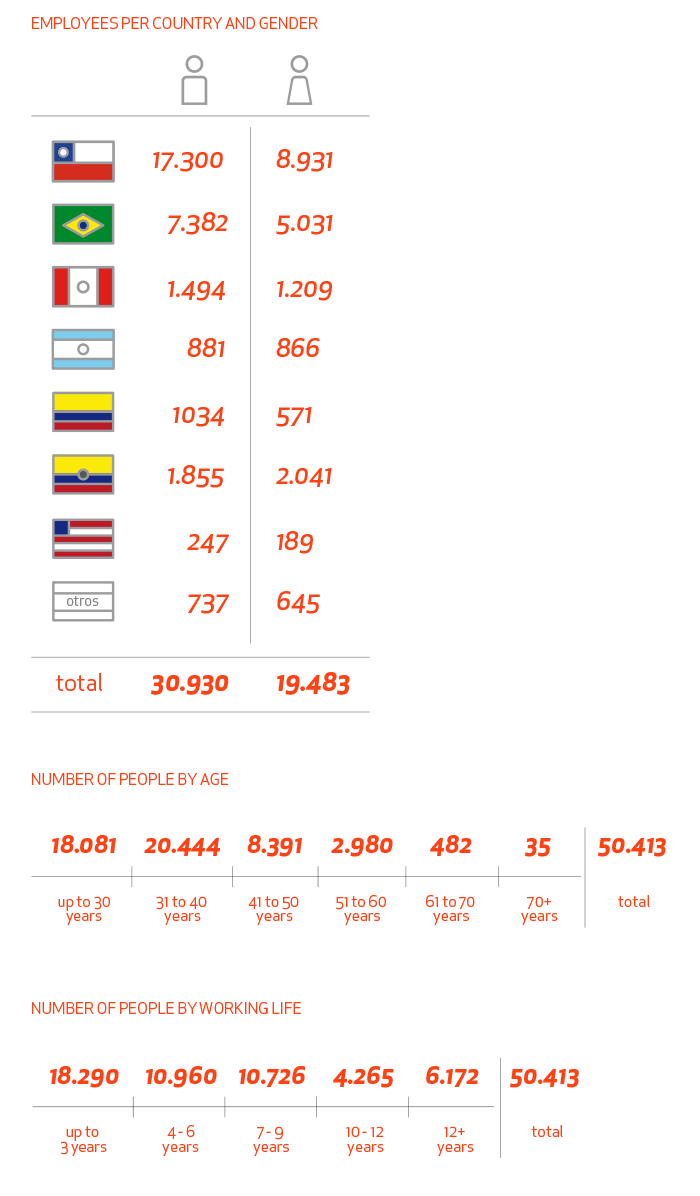
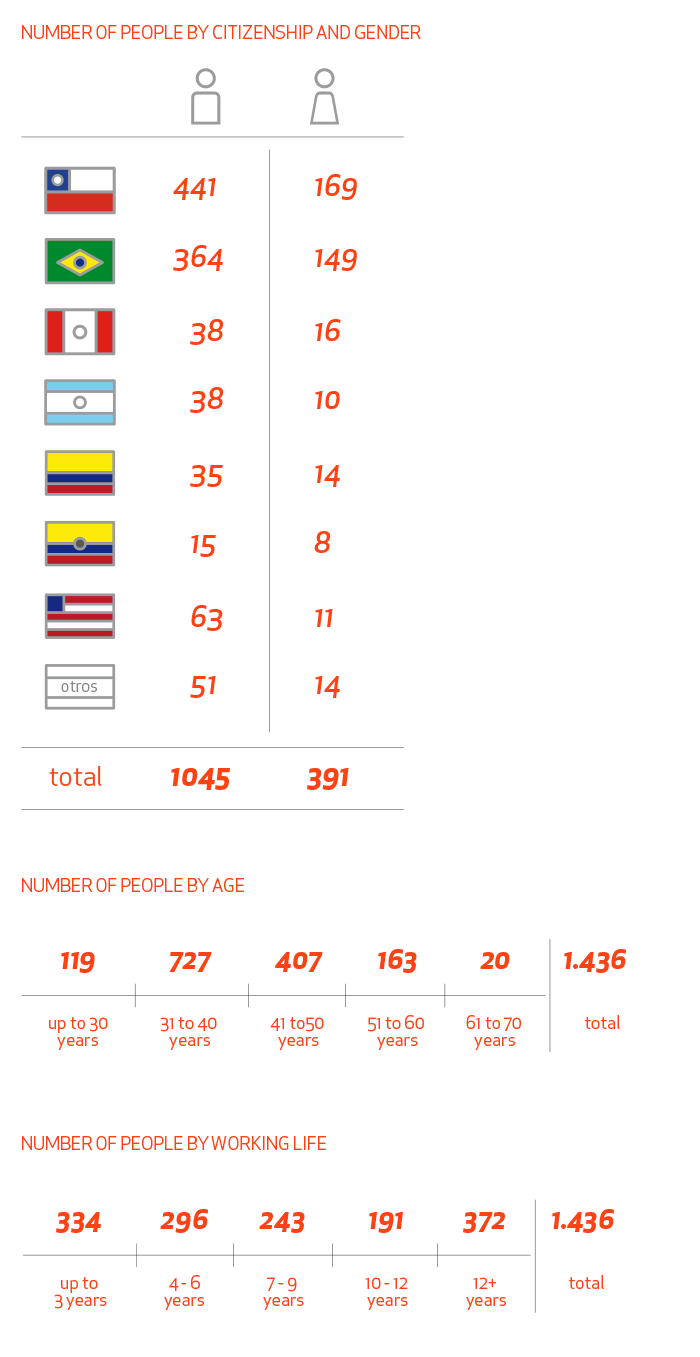
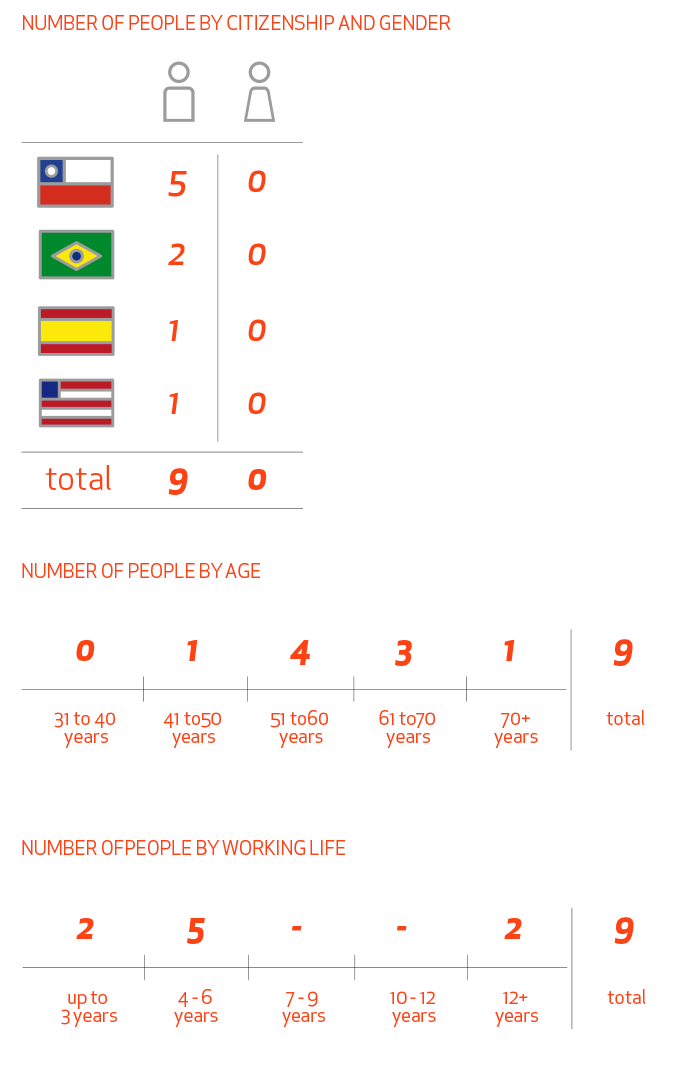
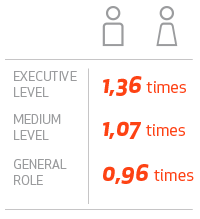

TE RelacionGrupos
The United Nations Framework Convention on Climate Change (UNFCCC) defines this phenomenon as a change in climate that alters the world’s atmosphere, causing significant harmful effects to the composition, resilience or productivity of natural ecosystems. The key objective in order to combat climate change is to stabilize and control greenhouse gas emissions.
LATAM Airlines Group is aware of the impacts generated by the airline industry (which is responsible for 2% of the greenhouse gas emissions that can be attributed to human activity), and developed a climate change strategy which allows the Company to address initiatives in two fields: impact and profitability, with actions directly related to the impacts of our operations, being handled from the risk management point of view, and are also controlled and mitigated through our management system; and also the involvement and acknowledgement, whose focus is centered in awareness-raising initiatives and training  of our employees and the promotion of actions and good environmental practices.
LATAM Airlines Group’s Environmental Management System, which is aligned with ISO 14,001 requirements for ground operations and the Environmental Assessment (IEnvA) system developed jointly with IATA for flight operations, establishes controls on significant environmental aspects, efficiency programs, the optimization of processes and risk management related to the operations’ emissions. During 2015 there were two important milestones: LAN CARGO became the first cargo airline operating at the International Miami Airport that received the international certification ISO 14001:2004, and also we reached the certification for the second stage of IEnvA, the highest possible, for the international flights operated by LAN from Chile.
Most of our greenhouse gas emissions are a result of the burning of fuel, making efficiency gains, consumption reductions and good management key issues in this field. For this purpose we have set in motion a fleet renovation plan with the acquisition of modern aircrafts that incorporates the latest-generation engines and the adoption of efficiency criteria that imply environmental improvements in decisions related to the fleet, therefore we have become one of the most efficient airlines in terms of emissions per kilometer-passenger carried in the airline industry worldwide. During 2015, the fuel efficiency programs of LAN and TAM were unified in one program named LATAM Fuel, which manages every fuel savings initiatives, and includes operational en technological projects going from the efficiency improvement of our operations to the air traffic management and the incorporation of structural development on aircrafts. The results of the implementation of these initiatives during 2015 generated fuel savings equivalent to more than 38 million gallons and reduction of its CO2 emissions by 360 thousand tons, and also reduced noise and improved local air quality.
We are committed with the goal of the industry to achieve carbon-neutral growth by 2020, for this purpose we accomplished different initiatives to reduce our carbon footprint. The development of sustainable alternative energies is a key issue for the air transport industry, and LATAM Airlines Group is aligned with these efforts and will continue working to develop and in the future to incorporate sustainable alternative fuels. Besides the in-flight fuel efficiency, we have energy efficiency initiatives on land. In addition, starting from 2012 in Peru and 2014 in Colombia, we neutralized ground emissions through local reforestation programs.
The strategic challenge of LATAM Airlines Group is to become a leader and worldwide referent in climate change, thus contributing to the efficiency and competitiveness of the Company.